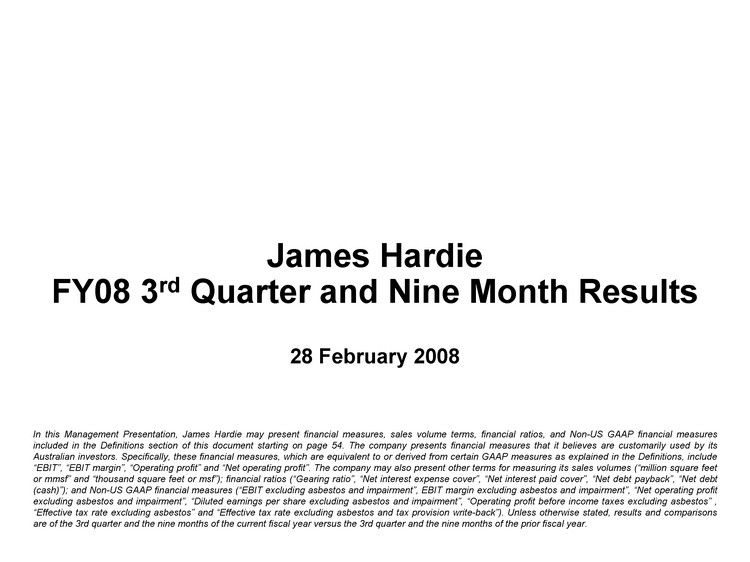
28 February 2008
|
For analyst ad media enquiries please call | |
| Steve Ashe on: Tel: (02) 8274 5246 | ||
| Mob: 0408 164 011. |
| Media Release: James Hardie — 3rd Quarter and Nine Months FY08 | 1 |
| US$ Million | Q3 | Q3 | % | 9 Months | 9 Months | % | |||||||||||||||||||
| FY 2008 | FY 2007 | Change | FY 2008 | FY 2007 | Change | ||||||||||||||||||||
Net sales |
$ | 341.4 | $ | 355.1 | (4 | ) | $ | 1,155.9 | $ | 1,182.0 | (2 | ) | |||||||||||||
Gross profit |
117.1 | 126.3 | (7 | ) | 422.8 | 439.2 | (4 | ) | |||||||||||||||||
SCI and other related expenses |
— | (2.6 | ) | — | — | (8.2 | ) | — | |||||||||||||||||
EBIT excluding asbestos
and Blandon impairment |
57.4 | 64.1 | (10 | ) | 237.8 | 248.4 | (4 | ) | |||||||||||||||||
AICF SG&A expenses |
(1.0 | ) | — | — | (2.7 | ) | — | — | |||||||||||||||||
Asbestos adjustments |
1.2 | (44.8 | ) | — | (57.8 | ) | (119.2 | ) | 52 | ||||||||||||||||
Impairment of Blandon facility |
(32.4 | ) | — | — | (32.4 | ) | — | — | |||||||||||||||||
EBIT |
25.2 | 19.3 | 31 | 144.9 | 129.2 | 12 | |||||||||||||||||||
Net interest income (expense) |
0.8 | (1.3 | ) | — | 3.3 | (2.3 | ) | — | |||||||||||||||||
Income tax expense |
(8.9 | ) | (26.0 | ) | 66 | (72.9 | ) | (79.2 | ) | 8 | |||||||||||||||
Net operating profit (loss) |
17.1 | (8.0 | ) | — | 75.3 | 48.6 | 55 | ||||||||||||||||||
| US$ Million | Q3 | Q3 | % | 9 Months | 9 Months | % | |||||||||||||||||||
| FY 2008 | FY 2007 | Change | FY 2008 | FY 2007 | Change | ||||||||||||||||||||
Net operating profit (loss) |
$ | 17.1 | $ | (8.0 | ) | — | $ | 75.3 | $ | 48.6 | 55 | ||||||||||||||
Asbestos: |
|||||||||||||||||||||||||
Asbestos adjustments |
(1.2 | ) | 44.8 | — | 57.8 | 119.2 | (52 | ) | |||||||||||||||||
AICF SG&A expenses |
1.0 | — | — | 2.7 | — | — | |||||||||||||||||||
AICF interest income |
(2.8 | ) | — | — | (7.0 | ) | — | — | |||||||||||||||||
Tax expense related to asbestos
adjustments |
— | — | — | 0.4 | — | — | |||||||||||||||||||
Impairment of Blandon facility (net of tax) |
20.0 | — | — | 20.0 | — | — | |||||||||||||||||||
Net operating profit excluding asbestos and
impairment |
$ | 34.1 | $ | 36.8 | (7 | ) | $ | 149.2 | $ | 167.8 | (11 | ) | |||||||||||||
| Media Release: James Hardie — 3rd Quarter and Nine Months FY08 | 2 |
| Media Release: James Hardie — 3rd Quarter and Nine Months FY08 | 3 |
| Media Release: James Hardie — 3rd Quarter and Nine Months FY08 | 4 |
| US$ Million | Q3 FY08 | Q3 FY07 | 9 Mths | 9 Mths | |||||||||||||
| FY 2008 | FY 2007 | ||||||||||||||||
Effect of foreign exchange |
$ | 1.2 | $ | (44.8 | ) | $ | (59.0 | ) | $ | (77.4 | ) | ||||||
Other adjustments |
— | — | 1.2 | (41.8 | ) | ||||||||||||
Asbestos adjustments |
$ | 1.2 | $ | (44.8 | ) | $ | (57.8 | ) | $ | (119.2 | ) | ||||||
| Media Release: James Hardie — 3rd Quarter and Nine Months FY08 | 5 |
Telephone:
|
+61 2 8274 5246 | |
Mobile:
|
+61 408 164 011 | |
Email:
|
[email protected] | |
Facsimile:
|
+61 2 8274 5218 |
| Media Release: James Hardie — 3rd Quarter and Nine Months FY08 | 6 |
| Media Release: James Hardie — 3rd Quarter and Nine Months FY08 | 7 |
| Q3 | Q3 | 9 Mths | 9 Mths | |||||||||||||
| US$ Millions | FY08 | FY07 | FY08 | FY07 | ||||||||||||
EBIT |
$ | 25.2 | $ | 19.3 | $ | 144.9 | $ | 129.2 | ||||||||
Asbestos: |
||||||||||||||||
Asbestos adjustments |
(1.2 | ) | 44.8 | 57.8 | 119.2 | |||||||||||
AICF SG&A expenses |
1.0 | — | 2.7 | — | ||||||||||||
Impairment of Blandon facility |
32.4 | — | 32.4 | — | ||||||||||||
EBIT excluding asbestos and impairment |
57.4 | 64.1 | 237.8 | 248.4 | ||||||||||||
Net Sales |
$ | 341.4 | $ | 355.1 | $ | 1,155.9 | $ | 1,182.0 | ||||||||
EBIT margin excluding asbestos and impairment |
16.8 | % | 18.1 | % | 20.6 | % | 21.0 | % | ||||||||
| Q3 | Q3 | 9 Mths | 9 Mths | |||||||||||||
| US$ Millions | FY08 | FY07 | FY08 | FY07 | ||||||||||||
Net operating profit (loss) |
$ | 17.1 | $ | (8.0 | ) | $ | 75.3 | $ | 48.6 | |||||||
Asbestos: |
||||||||||||||||
Asbestos adjustments |
(1.2 | ) | 44.8 | 57.8 | 119.2 | |||||||||||
AICF SG&A expenses |
1.0 | — | 2.7 | — | ||||||||||||
AICF interest income |
(2.8 | ) | — | (7.0 | ) | — | ||||||||||
Tax expense related to asbestos adjustments |
— | — | 0.4 | — | ||||||||||||
Impairment of Blandon facility (net of tax) |
20.0 | — | 20.0 | — | ||||||||||||
Net operating profit excluding asbestos and impairment |
$ | 34.1 | $ | 36.8 | $ | 149.2 | $ | 167.8 | ||||||||
| Media Release: James Hardie — 3rd Quarter and Nine Months FY08 | 8 |
| Q3 | Q3 | 9 Mths | 9 Mths | |||||||||||||
| US$ Millions | FY08 | FY07 | FY08 | FY07 | ||||||||||||
Net operating profit excluding asbestos and impairment |
$ | 34.1 | $ | 36.8 | $ | 149.2 | $ | 167.8 | ||||||||
Weighted average common shares
outstanding — Diluted (millions) |
451.8 | 464.7 | 462.8 | 464.6 | ||||||||||||
Diluted earnings per share excluding
asbestos and impairment (US cents) |
7.5 | 7.9 | 32.2 | 36.1 | ||||||||||||
| Q3 | Q3 | 9 Mths | 9 Mths | |||||||||||||
| US$ Millions | FY08 | FY07 | FY08 | FY07 | ||||||||||||
Operating profit before income taxes |
$ | 26.0 | $ | 18.0 | $ | 148.2 | $ | 126.9 | ||||||||
Asbestos: |
||||||||||||||||
Asbestos adjustments |
(1.2 | ) | 44.8 | 57.8 | 119.2 | |||||||||||
AICF SG&A expenses |
1.0 | — | 2.7 | — | ||||||||||||
AICF interest income |
(2.8 | ) | — | (7.0 | ) | — | ||||||||||
Operating profit before income taxes
excluding asbestos |
$ | 23.0 | $ | 62.8 | $ | 201.7 | $ | 246.1 | ||||||||
Income tax expense |
8.9 | 26.0 | 72.9 | 79.2 | ||||||||||||
Asbestos: |
||||||||||||||||
Tax expense related to asbestos adjustments |
— | — | 0.4 | — | ||||||||||||
Tax provision write-back |
— | — | — | 7.4 | ||||||||||||
Income tax expense excluding asbestos and tax
provision write-back |
8.9 | 26.0 | 73.3 | 86.6 | ||||||||||||
Effective tax rate excluding asbestos and tax
provision write-back |
38.7 | % | 41.4 | % | 36.3 | % | 35.2 | % | ||||||||
| Media Release: James Hardie — 3rd Quarter and Nine Months FY08 | 9 |
| Q3 | Q3 | 9 Mths | 9 Mths | |||||||||||||
| US$ Millions | FY08 | FY07 | FY08 | FY07 | ||||||||||||
EBIT |
$ | 25.2 | $ | 19.3 | $ | 144.9 | $ | 129.2 | ||||||||
Depreciation and amortisation |
14.4 | 12.8 | 42.1 | 37.0 | ||||||||||||
EBITDA |
$ | 39.6 | $ | 32.1 | $ | 187.0 | $ | 166.2 | ||||||||
| Media Release: James Hardie — 3rd Quarter and Nine Months FY08 | 10 |
| • | expectations about the timing and amount of payments to the Asbestos Injuries Compensation Fund (AICF), a special purpose fund for the compensation of proven asbestos-related personal injury and death claims; | |
| • | expectations concerning the costs associated with the suspension of operations at our Blandon, Pennsylvania plant; | |
| • | statements as to the possible consequences of proceedings brought against us and certain of our former directors and officers by the Australian Securities and Investments Commission; | |
| • | statements regarding tax liabilities and related proceedings; | |
| • | expectations that our credit facilities will be extended or renewed; | |
| • | projections of our operating results or financial condition; | |
| • | statements regarding our plans, objectives or goals, including those relating to competition, acquisitions, dispositions and our products; | |
| • | statements about our future performance; and | |
| • | statements about product or environmental liabilities. |
| Media Release: James Hardie — 3rd Quarter and Nine Months FY08 | 11 |
| Three Months and Nine Months Ended 31 December | |||||||||||||||||||||||||
| % | 9 Mths | 9 Mths | % | ||||||||||||||||||||||
| US$ Millions | Q3 FY08 | Q3 FY07 | Change | FY08 | FY07 | Change | |||||||||||||||||||
Net Sales |
|||||||||||||||||||||||||
USA Fibre Cement |
$ | 258.2 | $ | 284.5 | (9 | ) | $ | 912.3 | $ | 972.4 | (6 | ) | |||||||||||||
Asia Pacific Fibre Cement |
77.5 | 64.4 | 20 | 224.8 | 187.4 | 20 | |||||||||||||||||||
Other |
5.7 | 6.2 | (8 | ) | 18.8 | 22.2 | (15 | ) | |||||||||||||||||
Total Net Sales |
$ | 341.4 | $ | 355.1 | (4 | ) | $ | 1,155.9 | $ | 1,182.0 | (2 | ) | |||||||||||||
Cost of goods sold |
(224.3 | ) | (228.8 | ) | 2 | (733.1 | ) | (742.8 | ) | 1 | |||||||||||||||
Gross profit |
117.1 | 126.3 | (7 | ) | 422.8 | 439.2 | (4 | ) | |||||||||||||||||
Selling, general and administrative
expenses |
(54.3 | ) | (53.4 | ) | (2 | ) | (167.9 | ) | (162.3 | ) | (3 | ) | |||||||||||||
Research & development expenses |
(6.4 | ) | (6.2 | ) | (3 | ) | (19.8 | ) | (20.3 | ) | 2 | ||||||||||||||
Impairment of Blandon facility |
(32.4 | ) | — | — | (32.4 | ) | — | — | |||||||||||||||||
SCI and other related expenses |
— | (2.6 | ) | — | — | (8.2 | ) | — | |||||||||||||||||
Asbestos adjustments |
1.2 | (44.8 | ) | — | (57.8 | ) | (119.2 | ) | 52 | ||||||||||||||||
EBIT |
25.2 | 19.3 | 31 | 144.9 | 129.2 | 12 | |||||||||||||||||||
Net interest income (expense) |
0.8 | (1.3 | ) | — | 3.3 | (2.3 | ) | — | |||||||||||||||||
Operating profit before income taxes |
26.0 | 18.0 | 44 | 148.2 | 126.9 | 17 | |||||||||||||||||||
Income tax expense |
(8.9 | ) | (26.0 | ) | 66 | (72.9 | ) | (79.2 | ) | 8 | |||||||||||||||
Operating profit (loss) before
cumulative
effect of change in accounting
principle |
17.1 | (8.0 | ) | — | 75.3 | 47.7 | 58 | ||||||||||||||||||
Cumulative effect of change in
accounting principle for stock-based
compensation, net of income tax
expense
of nil and US$0.4 million,
respectively |
— | — | — | — | 0.9 | — | |||||||||||||||||||
Net operating profit (loss) |
$ | 17.1 | $ | (8.0 | ) | — | $ | 75.3 | $ | 48.6 | 55 | ||||||||||||||
Earnings per share — diluted (US
cents) |
3.9 | (1.7 | ) | — | 16.3 | 10.5 | 55 | ||||||||||||||||||
Volume (mmsf) |
|||||||||||||||||||||||||
USA Fibre Cement |
437.6 | 484.0 | (10 | ) | 1,522.7 | 1,663.1 | (8 | ) | |||||||||||||||||
Asia Pacific Fibre Cement |
100.4 | 100.1 | — | 302.9 | 292.6 | 4 | |||||||||||||||||||
Average net sales price per unit (per
mmsf) |
|||||||||||||||||||||||||
USA Fibre Cement |
US$ | 590 | US$ | 588 | — | US$ | 599 | US$ | 585 | 2 | |||||||||||||||
Asia Pacific Fibre Cement |
A$866 | A$836 | 4 | A$866 | A$845 | 2 | |||||||||||||||||||
| Management’s Analysis of Results: James Hardie — 3rd Quarter and Nine Months FY08 | 1 |
| Management’s Analysis of Results: James Hardie — 3rd Quarter and Nine Months FY08 | 2 |
| Management’s Analysis of Results: James Hardie — 3rd Quarter and Nine Months FY08 | 3 |
| Management’s Analysis of Results: James Hardie — 3rd Quarter and Nine Months FY08 | 4 |
| Management’s Analysis of Results: James Hardie — 3rd Quarter and Nine Months FY08 | 5 |
| 9 Mths | 9 Mths | ||||||||||||||||
| US$ Million | Q3 FY08 | Q3 FY07 | FY 2008 | FY 2007 | |||||||||||||
Effect of foreign exchange |
$ | 1.2 | $ | (44.8 | ) | $ | (59.0 | ) | $ | (77.4 | ) | ||||||
Other adjustments |
— | — | 1.2 | (41.8 | ) | ||||||||||||
Asbestos adjustments |
$ | 1.2 | $ | (44.8 | ) | $ | (57.8 | ) | $ | (119.2 | ) | ||||||
| Management’s Analysis of Results: James Hardie — 3rd Quarter and Nine Months FY08 | 6 |
| Three Months and Nine Months Ended 31 December | |||||||||||||||||||||||||
| % | 9 Mths | 9 Mths | % | ||||||||||||||||||||||
| EBIT - US$ Millions | Q3 FY08 | Q3 FY07 | Change | FY08 | FY07 | Change | |||||||||||||||||||
USA Fibre Cement |
$ | 64.6 | $ | 76.7 | (16 | ) | $ | 263.3 | $ | 277.8 | (5 | ) | |||||||||||||
Asia Pacific Fibre Cement |
14.8 | 8.8 | 68 | 39.6 | 30.6 | 29 | |||||||||||||||||||
Other |
(1.3 | ) | (2.4 | ) | 46 | (4.5 | ) | (6.6 | ) | 32 | |||||||||||||||
Research & Development |
(4.2 | ) | (4.9 | ) | 14 | (13.1 | ) | (13.6 | ) | 4 | |||||||||||||||
General Corporate |
(16.5 | ) | (14.1 | ) | (17 | ) | (47.5 | ) | (39.8 | ) | (19 | ) | |||||||||||||
Impairment of Blandon facility |
(32.4 | ) | — | — | (32.4 | ) | — | — | |||||||||||||||||
Asbestos adjustments |
1.2 | (44.8 | ) | — | (57.8 | ) | (119.2 | ) | 52 | ||||||||||||||||
AICF SG&A expenses |
(1.0 | ) | — | — | (2.7 | ) | — | — | |||||||||||||||||
EBIT |
25.2 | 19.3 | 31 | 144.9 | 129.2 | 12 | |||||||||||||||||||
Excluding: |
|||||||||||||||||||||||||
Asbestos: |
|||||||||||||||||||||||||
Asbestos adjustments |
(1.2 | ) | 44.8 | — | 57.8 | 119.2 | (52 | ) | |||||||||||||||||
AICF SG&A expenses |
1.0 | — | — | 2.7 | — | — | |||||||||||||||||||
Impairment of Blandon facility |
32.4 | — | — | 32.4 | — | — | |||||||||||||||||||
EBIT excluding asbestos and impairment |
$ | 57.4 | $ | 64.1 | (10 | ) | $ | 237.8 | $ | 248.4 | (4 | ) | |||||||||||||
Net sales |
$ | 341.4 | $ | 355.1 | (4 | ) | $ | 1,155.9 | $ | 1,182.0 | (2 | ) | |||||||||||||
EBIT margin excluding asbestos and
impairment |
16.8 | % | 18.1 | % | 20.6 | % | 21.0 | % | |||||||||||||||||
| Management’s Analysis of Results: James Hardie — 3rd Quarter and Nine Months FY08 | 7 |
| Management’s Analysis of Results: James Hardie — 3rd Quarter and Nine Months FY08 | 8 |
| Management’s Analysis of Results: James Hardie — 3rd Quarter and Nine Months FY08 | 9 |
| Three Months and Nine Months Ended 31 December | |||||||||||||||||||||||||
| Q3 | Q3 | % | 9 Mths | 9 Mths | % | ||||||||||||||||||||
| Net Operating Profit - US$ millions | FY08 | FY07 | Change | FY08 | FY07 | Change | |||||||||||||||||||
Net operating profit (loss) |
$ | 17.1 | $ | (8.0 | ) | — | $ | 75.3 | $ | 48.6 | 55 | ||||||||||||||
Excluding: |
|||||||||||||||||||||||||
Asbestos: |
|||||||||||||||||||||||||
Asbestos adjustments |
(1.2 | ) | 44.8 | — | 57.8 | 119.2 | (52 | ) | |||||||||||||||||
Tax expense related to
asbestos adjustments |
— | — | — | 0.4 | — | — | |||||||||||||||||||
AICF SG&A costs |
1.0 | — | — | 2.7 | — | — | |||||||||||||||||||
AICF interest income |
(2.8 | ) | — | — | (7.0 | ) | — | — | |||||||||||||||||
Impairment of Blandon facility (net
of tax) |
20.0 | — | — | 20.0 | — | — | |||||||||||||||||||
Net operating profit excluding
asbestos and impairment |
$ | 34.1 | $ | 36.8 | (7 | ) | $ | 149.2 | $ | 167.8 | (11 | ) | |||||||||||||
| At 31 December 2007 | ||||||||||||
| Effective | Total | Principal | ||||||||||
| Description | Interest Rate | Facility | Drawn | |||||||||
(US$ millions) |
||||||||||||
364-day facilities, can be drawn in US$, variable interest
rates based on LIBOR plus margin, can be repaid and
redrawn until December 2008 |
5.57 | % | $ | 110.0 | $ | 106.0 | ||||||
Term facilities, can be drawn in US$, variable interest
rates based on LIBOR plus margin, can be repaid and
redrawn until June 2010 |
5.70 | % | 245.0 | 196.5 | ||||||||
Total |
$ | 355.0 | $ | 302.5 | ||||||||
| Management’s Analysis of Results: James Hardie — 3rd Quarter and Nine Months FY08 | 10 |
| Total | ||||
| Description | Facility | |||
(US$ millions) |
||||
Term facilities, can be drawn in US$, variable interest rates based on LIBOR
plus margin, can be repaid and redrawn until February 2011 |
45.0 | |||
Term facilities, can be drawn in US$, variable interest rates based on LIBOR
plus margin, can be repaid and redrawn until February 2013 |
$ | 90.0 | ||
Total signed facilities subsequent to 31 December 2007 |
$ | 135.0 | ||
Existing facilities at 31 December 2007 |
355.0 | |||
Total credit facilities at 28 February 2008 |
$ | 490.0 | ||
| Management’s Analysis of Results: James Hardie — 3rd Quarter and Nine Months FY08 | 11 |
| Management’s Analysis of Results: James Hardie — 3rd Quarter and Nine Months FY08 | 12 |
Telephone:
|
+61 2 8274 5246 | |
Mobile:
|
+61 0408 164 011 | |
Email:
|
[email protected] | |
Facsimile:
|
+61 2 8274 5218 |
| Management’s Analysis of Results: James Hardie — 3rd Quarter and Nine Months FY08 | 13 |
| Management’s Analysis of Results: James Hardie — 3rd Quarter and Nine Months FY08 | 14 |
| Q3 | Q3 | 9 Mths | 9 Mths | |||||||||||||
| US$ Millions | FY08 | FY07 | FY08 | FY07 | ||||||||||||
EBIT |
$ | 25.2 | $ | 19.3 | $ | 144.9 | $ | 129.2 | ||||||||
Asbestos: |
||||||||||||||||
Asbestos adjustments |
(1.2 | ) | 44.8 | 57.8 | 119.2 | |||||||||||
AICF SG&A expenses |
1.0 | — | 2.7 | — | ||||||||||||
Impairment of Blandon facility |
32.4 | — | 32.4 | — | ||||||||||||
EBIT excluding asbestos and impairment |
57.4 | 64.1 | 237.8 | 248.4 | ||||||||||||
Net Sales |
$ | 341.4 | $ | 355.1 | $ | 1,155.9 | $ | 1,182.0 | ||||||||
EBIT margin excluding asbestos and impairment |
16.8 | % | 18.1 | % | 20.6 | % | 21.0 | % | ||||||||
| Q3 | Q3 | 9 Mths | 9 Mths | |||||||||||||
| US$ Millions | FY08 | FY07 | FY08 | FY07 | ||||||||||||
Net operating profit (loss) |
$ | 17.1 | $ | (8.0 | ) | $ | 75.3 | $ | 48.6 | |||||||
Asbestos: |
||||||||||||||||
Asbestos adjustments |
(1.2 | ) | 44.8 | 57.8 | 119.2 | |||||||||||
AICF SG&A expenses |
1.0 | — | 2.7 | — | ||||||||||||
AICF interest income |
(2.8 | ) | — | (7.0 | ) | — | ||||||||||
Tax expense related to asbestos adjustments |
— | — | 0.4 | — | ||||||||||||
Impairment of Blandon facility (net of tax) |
20.0 | — | 20.0 | — | ||||||||||||
Net operating profit excluding asbestos and impairment |
$ | 34.1 | $ | 36.8 | $ | 149.2 | $ | 167.8 | ||||||||
| Management’s Analysis of Results: James Hardie — 3rd Quarter and Nine Months FY08 | 15 |
| Q3 | Q3 | 9 Mths | 9 Mths | |||||||||||||
| US$ Millions | FY08 | FY07 | FY08 | FY07 | ||||||||||||
Net operating profit excluding asbestos and impairment |
$ | 34.1 | $ | 36.8 | $ | 149.2 | $ | 167.8 | ||||||||
Weighted average common shares
outstanding — Diluted (millions) |
451.8 | 464.7 | 462.8 | 464.6 | ||||||||||||
Diluted earnings per share excluding
asbestos and impairment (US cents) |
7.5 | 7.9 | 32.2 | 36.1 | ||||||||||||
| Q3 | Q3 | 9 Mths | 9 Mths | |||||||||||||
| US$ Millions | FY08 | FY07 | FY08 | FY07 | ||||||||||||
Operating profit before income taxes |
$ | 26.0 | $ | 18.0 | $ | 148.2 | $ | 126.9 | ||||||||
Asbestos: |
||||||||||||||||
Asbestos adjustments |
(1.2 | ) | 44.8 | 57.8 | 119.2 | |||||||||||
AICF SG&A expenses |
1.0 | — | 2.7 | — | ||||||||||||
AICF interest income |
(2.8 | ) | — | (7.0 | ) | — | ||||||||||
Operating profit before income taxes
excluding asbestos |
$ | 23.0 | $ | 62.8 | $ | 201.7 | $ | 246.1 | ||||||||
Income tax expense |
8.9 | 26.0 | 72.9 | 79.2 | ||||||||||||
Asbestos: |
||||||||||||||||
Tax expense related
to asbestos adjustments |
— | — | 0.4 | — | ||||||||||||
Tax provision write-back |
— | — | — | 7.4 | ||||||||||||
Income tax expense excluding asbestos and tax
provision write-back |
8.9 | 26.0 | 73.3 | 86.6 | ||||||||||||
Effective tax rate excluding asbestos and tax
provision write-back |
38.7 | % | 41.4 | % | 36.3 | % | 35.2 | % | ||||||||
| Management’s Analysis of Results: James Hardie — 3rd Quarter and Nine Months FY08 | 16 |
| Q3 | Q3 | 9 Mths | 9 Mths | |||||||||||||
| US$ Millions | FY08 | FY07 | FY08 | FY07 | ||||||||||||
EBIT |
$ | 25.2 | $ | 19.3 | $ | 144.9 | $ | 129.2 | ||||||||
Depreciation and amortisation |
14.4 | 12.8 | 42.1 | 37.0 | ||||||||||||
EBITDA |
$ | 39.6 | $ | 32.1 | $ | 187.0 | $ | 166.2 | ||||||||
| Management’s Analysis of Results: James Hardie — 3rd Quarter and Nine Months FY08 | 17 |
| Management’s Analysis of Results: James Hardie — 3rd Quarter and Nine Months FY08 | 18 |
| Total Fibre Cement | ||||||||||||
| Operations- excluding | ||||||||||||
| Asbestos | Asbestos | |||||||||||
| US$ Millions | Compensation | Compensation | As Reported | |||||||||
ASSETS |
||||||||||||
Current assets |
||||||||||||
Cash and cash equivalents |
$ | 219.0 | $ | (149.1 | ) | $ | 69.9 | |||||
Restricted cash and cash equivalents |
5.0 | — | 5.0 | |||||||||
Restricted cash and cash equivalents — Asbestos |
— | 47.7 | 47.7 | |||||||||
Restricted short-term investments — Asbestos |
— | 77.4 | 77.4 | |||||||||
Accounts and notes receivable, net of allowance
for doubtful accounts of $2.2m |
131.6 | 0.2 | 131.8 | |||||||||
Inventories |
156.2 | — | 156.2 | |||||||||
Prepaid expenses and other current assets |
34.7 | 0.3 | 35.0 | |||||||||
Insurance receivable — Asbestos |
— | 10.3 | 10.3 | |||||||||
Workers’ compensation — Asbestos |
— | 3.0 | 3.0 | |||||||||
Deferred income taxes |
23.7 | — | 23.7 | |||||||||
Deferred income taxes — Asbestos |
— | 9.1 | 9.1 | |||||||||
Total current assets |
570.2 | (1.1 | ) | 569.1 | ||||||||
Property, plant and equipment, net |
799.4 | 0.4 | 799.8 | |||||||||
Insurance receivable — Asbestos |
— | 167.5 | 167.5 | |||||||||
Workers’ compensation — Asbestos |
— | 83.6 | 83.6 | |||||||||
Deferred income taxes |
3.0 | — | 3.0 | |||||||||
Deferred income taxes — Asbestos |
— | 339.5 | 339.5 | |||||||||
Deposit with Australian Taxation Office |
191.8 | — | 191.8 | |||||||||
Other assets |
1.6 | — | 1.6 | |||||||||
Total assets |
$ | 1,566.0 | $ | 589.9 | $ | 2,155.9 | ||||||
LIABILITIES AND SHAREHOLDERS’ EQUITY |
||||||||||||
Current liabilities |
||||||||||||
Accounts payable and accrued liabilities |
$ | 112.8 | $ | 1.4 | $ | 114.2 | ||||||
Short-term debt |
106.0 | — | 106.0 | |||||||||
Accrued payroll and employee benefits |
41.5 | 0.2 | 41.7 | |||||||||
Accrued product warranties |
8.5 | — | 8.5 | |||||||||
Income taxes payable |
32.8 | (17.1 | ) | 15.7 | ||||||||
Asbestos liability |
— | 69.4 | 69.4 | |||||||||
Workers’ compensation — Asbestos |
— | 3.0 | 3.0 | |||||||||
Other liabilities |
9.2 | — | 9.2 | |||||||||
Total current liabilities |
310.8 | 56.9 | 367.7 | |||||||||
Long-term debt |
196.5 | — | 196.5 | |||||||||
Deferred income taxes |
107.8 | — | 107.8 | |||||||||
Accrued product warranties |
10.1 | — | 10.1 | |||||||||
Asbestos liability |
— | 1,287.7 | 1,287.7 | |||||||||
Workers’ compensation — Asbestos |
— | 83.6 | 83.6 | |||||||||
Other liabilities |
151.7 | 3.4 | 155.1 | |||||||||
Total liabilities |
776.9 | 1,431.6 | 2,208.5 | |||||||||
Commitments and contingencies |
||||||||||||
Shareholders’ equity |
||||||||||||
Common stock |
252.3 | — | 252.3 | |||||||||
Additional paid-in capital |
187.9 | — | 187.9 | |||||||||
Retained earnings (accumulated deficit) |
523.1 | (840.0 | ) | (316.9 | ) | |||||||
Common stock in treasury |
(196.3 | ) | — | (196.3 | ) | |||||||
Accumulated other comprehensive income |
22.1 | (1.7 | ) | 20.4 | ||||||||
Total shareholders’ equity |
789.1 | (841.7 | ) | (52.6 | ) | |||||||
Total liabilities and shareholders’ equity |
$ | 1,566.0 | $ | 589.9 | $ | 2,155.9 | ||||||
| Management’s Analysis of Results: James Hardie — 3rd Quarter and Nine Months FY08 | 19 |
| Total Fibre | ||||||||||||
| Cement | ||||||||||||
| Operations- | ||||||||||||
| excluding | ||||||||||||
| Asbestos | Asbestos | |||||||||||
| US$ Millions | Compensation | Compensation | As Reported | |||||||||
Net Sales |
||||||||||||
USA Fibre Cement |
$ | 912.3 | $ | — | $ | 912.3 | ||||||
Asia Pacific Fibre Cement |
224.8 | — | 224.8 | |||||||||
Other |
18.8 | — | 18.8 | |||||||||
Total Net Sales |
1,155.9 | — | 1,155.9 | |||||||||
Cost of goods sold |
(733.1 | ) | — | (733.1 | ) | |||||||
Gross profit |
422.8 | — | 422.8 | |||||||||
Selling, general and administrative expenses |
(165.2 | ) | (2.7 | ) | (167.9 | ) | ||||||
Research and development expenses |
(19.8 | ) | — | (19.8 | ) | |||||||
Impairment of Blandon facility |
(32.4 | ) | — | (32.4 | ) | |||||||
Asbestos adjustments |
— | (57.8 | ) | (57.8 | ) | |||||||
EBIT |
205.4 | (60.5 | ) | 144.9 | ||||||||
Net Interest (expense) income |
(3.7 | ) | 7.0 | 3.3 | ||||||||
Operating profit (loss) before income taxes |
201.7 | (53.5 | ) | 148.2 | ||||||||
Income tax expense |
(72.5 | ) | (0.4 | ) | (72.9 | ) | ||||||
Net Operating Profit (Loss) |
$ | 129.2 | $ | (53.9 | ) | $ | 75.3 | |||||
| Management’s Analysis of Results: James Hardie — 3rd Quarter and Nine Months FY08 | 20 |
| Total Fibre | ||||||||||||
| Cement | ||||||||||||
| Operations- | ||||||||||||
| excluding | ||||||||||||
| Asbestos | Asbestos | |||||||||||
| US$ Millions | Compensation | Compensation | As Reported | |||||||||
Cash Flows from Operating Activities |
||||||||||||
Net Income (loss) |
$ | 129.2 | $ | (53.9 | ) | $ | 75.3 | |||||
Adjustments to reconcile net income (loss) to net cash
provided by operating activities: |
||||||||||||
Depreciation and amortisation |
42.1 | — | 42.1 | |||||||||
Deferred income taxes |
13.2 | — | 13.2 | |||||||||
Prepaid pension cost |
0.9 | — | 0.9 | |||||||||
Stock-based compensation |
5.0 | — | 5.0 | |||||||||
Asbestos adjustments |
— | 57.8 | 57.8 | |||||||||
Impairment of Blandon facility |
32.4 | — | 32.4 | |||||||||
Other |
0.5 | (3.9 | ) | (3.4 | ) | |||||||
Changes in operating assets and liabilities: |
||||||||||||
Restricted cash and cash equivalents |
— | 37.0 | 37.0 | |||||||||
Accounts and notes receivable |
37.0 | 0.3 | 37.3 | |||||||||
Inventories |
(4.7 | ) | — | (4.7 | ) | |||||||
Prepaid expenses and other current assets |
(2.0 | ) | 0.1 | (1.9 | ) | |||||||
Insurance receivable |
— | 12.8 | 12.8 | |||||||||
Accounts payable and accrued liabilities |
2.6 | — | 2.6 | |||||||||
Asbestos liability |
— | (50.6 | ) | (50.6 | ) | |||||||
Deposit with Australian Taxation Office |
(6.5 | ) | — | (6.5 | ) | |||||||
Other accrued liabilities and other liabilities |
29.7 | 0.4 | 30.1 | |||||||||
Net cash provided by operating activities |
$ | 279.4 | $ | — | $ | 279.4 | ||||||
Cash Flows From Investing Activities |
||||||||||||
Purchases of property, plant and equipment |
(28.7 | ) | — | (28.7 | ) | |||||||
Net cash used in investing activities |
$ | (28.7 | ) | $ | — | $ | (28.7 | ) | ||||
Cash Flows from Financing Activities |
||||||||||||
Proceeds from short term borrowings |
23.0 | — | 23.0 | |||||||||
Proceeds from long term borrowings |
91.5 | — | 91.5 | |||||||||
Proceeds from issuance of shares |
3.1 | — | 3.1 | |||||||||
Tax benefit from stock options exercised |
0.1 | — | 0.1 | |||||||||
Treasury stock purchased |
(196.3 | ) | — | (196.3 | ) | |||||||
Dividends paid |
(123.1 | ) | — | (123.1 | ) | |||||||
Net cash used in Financing activities |
$ | (201.7 | ) | $ | — | $ | (201.7 | ) | ||||
Effects of exchange rate changes on cash |
(13.2 | ) | — | (13.2 | ) | |||||||
Net increase in cash and cash equivalents |
35.8 | — | 35.8 | |||||||||
Cash and cash equivalents at beginning of period |
34.1 | — | 34.1 | |||||||||
Cash and cash equivalents at end of period |
$ | 69.9 | $ | — | $ | 69.9 | ||||||
Components of Cash and Cash Equivalents |
||||||||||||
Cash at bank and on hand |
35.5 | — | 35.5 | |||||||||
Short-term deposits |
34.4 | — | 34.4 | |||||||||
Cash and cash equivalents at end of period |
$ | 69.9 | $ | — | $ | 69.9 | ||||||
| Management’s Analysis of Results: James Hardie — 3rd Quarter and Nine Months FY08 | 21 |
| • | expectations about the timing and amount of payments to the Asbestos Injuries Compensation Fund (AICF), a special purpose fund for the compensation of proven asbestos-related personal injury and death claims; | |
| • | expectations concerning the costs associated with the suspension of operations at our Blandon, Pennsylvania plant; | |
| • | statements as to the possible consequences of proceedings brought against us and certain of our former directors and officers by the Australian Securities and Investments Commission; | |
| • | statements regarding tax liabilities and related proceedings; | |
| • | expectations that our credit facilities will be extended or renewed; | |
| • | projections of our operating results or financial condition; | |
| • | statements regarding our plans, objectives or goals, including those relating to competition, acquisitions, dispositions and our products; | |
| • | statements about our future performance; and | |
| • | statements about product or environmental liabilities. |
| Management’s Analysis of Results: James Hardie — 3rd Quarter and Nine Months FY08 | 22 |

| James Hardie FY08 3rd Quarter and Nine Month Results 28 February 2008 In this Management Presentation, James Hardie may present financial measures, sales volume terms, financial ratios, and Non-US GAAP financial measures included in the Definitions section of this document starting on page 54. The company presents financial measures that it believes are customarily used by its Australian investors. Specifically, these financial measures, which are equivalent to or derived from certain GAAP measures as explained in the Definitions, include "EBIT", "EBIT margin", "Operating profit" and "Net operating profit". The company may also present other terms for measuring its sales volumes ("million square feet or mmsf" and "thousand square feet or msf"); financial ratios ("Gearing ratio", "Net interest expense cover", "Net interest paid cover", "Net debt payback", "Net debt (cash)"); and Non-US GAAP financial measures ("EBIT excluding asbestos and impairment", EBIT margin excluding asbestos and impairment", "Net operating profit excluding asbestos and impairment", "Diluted earnings per share excluding asbestos and impairment", "Operating profit before income taxes excluding asbestos" , "Effective tax rate excluding asbestos" and "Effective tax rate excluding asbestos and tax provision write-back"). Unless otherwise stated, results and comparisons are of the 3rd quarter and the nine months of the current fiscal year versus the 3rd quarter and the nine months of the prior fiscal year. |
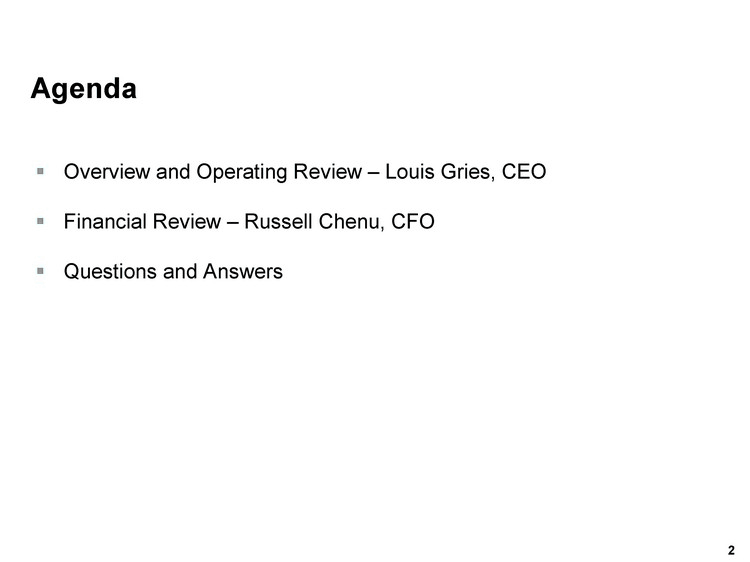
| Overview and Operating Review - Louis Gries, CEO Financial Review - Russell Chenu, CFO Questions and Answers Agenda |
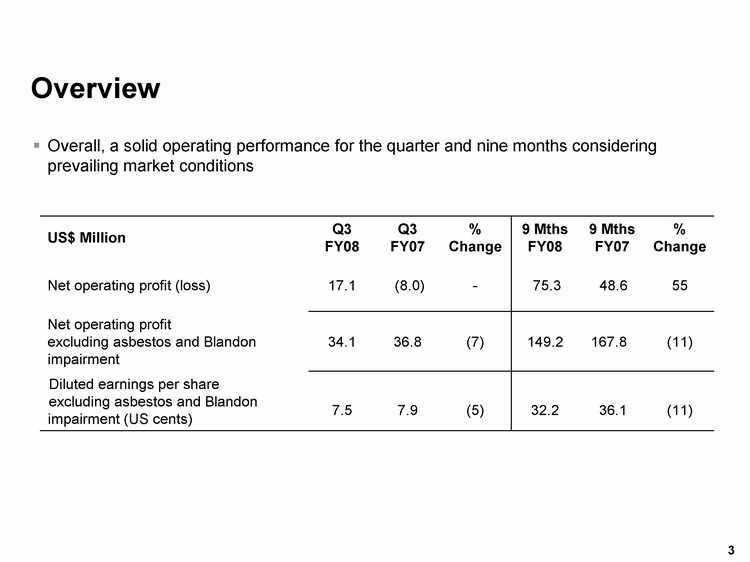
| US$ Million Q3 FY08 Q3 FY07 % Change 9 Mths FY08 9 Mths FY07 % Change Net operating profit (loss) 17.1 (8.0) - 75.3 48.6 55 Net operating profit excluding asbestos and Blandon impairment 34.1 36.8 (7) 149.2 167.8 (11) Diluted earnings per share excluding asbestos and Blandon impairment (US cents) 7.5 7.9 (5) 32.2 36.1 (11) Overall, a solid operating performance for the quarter and nine months considering prevailing market conditions Overview |
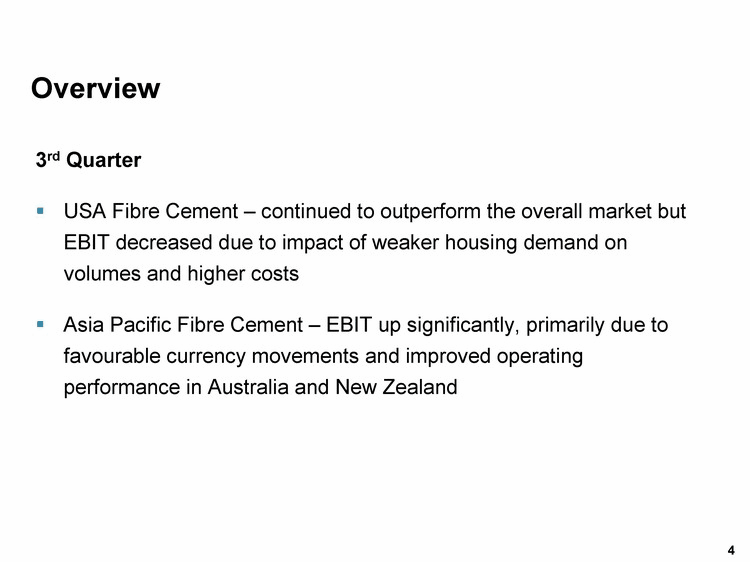
| 3rd Quarter USA Fibre Cement - continued to outperform the overall market but EBIT decreased due to impact of weaker housing demand on volumes and higher costs Asia Pacific Fibre Cement - EBIT up significantly, primarily due to favourable currency movements and improved operating performance in Australia and New Zealand Overview |
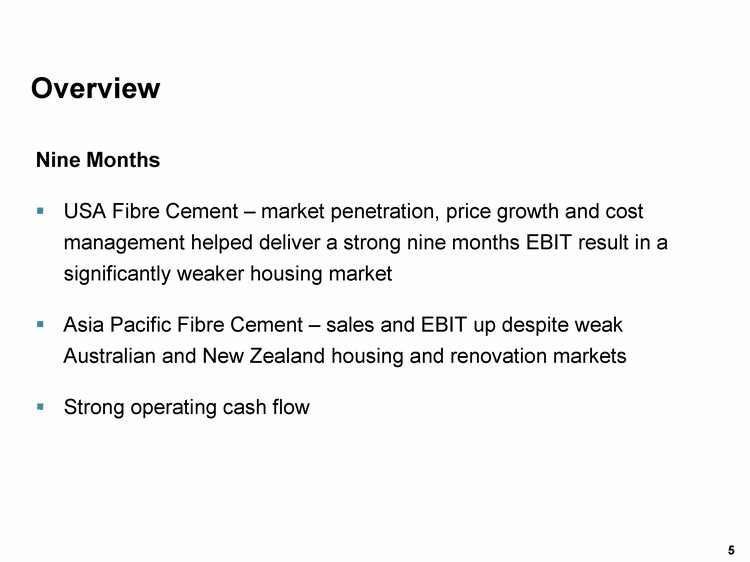
| Nine Months USA Fibre Cement - market penetration, price growth and cost management helped deliver a strong nine months EBIT result in a significantly weaker housing market Asia Pacific Fibre Cement - sales and EBIT up despite weak Australian and New Zealand housing and renovation markets Strong operating cash flow Overview |
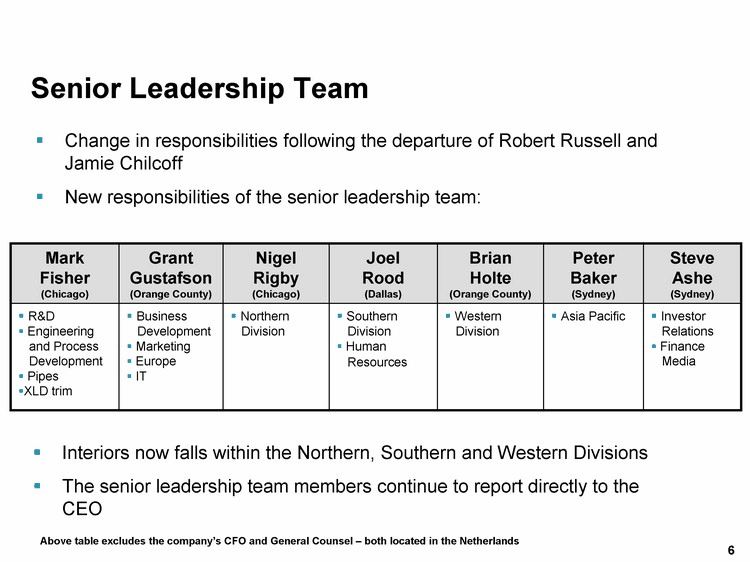
| Change in responsibilities following the departure of Robert Russell and Jamie Chilcoff New responsibilities of the senior leadership team: Mark Fisher (Chicago) Grant Gustafson (Orange County) Nigel Rigby (Chicago) Joel Rood (Dallas) Brian Holte (Orange County) Peter Baker (Sydney) Steve Ashe (Sydney) R&D Engineering and Process Development Pipes XLD trim Business Development Marketing Europe IT Northern Division Southern Division Human Resources Western Division Asia Pacific Investor Relations Finance Media Senior Leadership Team Interiors now falls within the Northern, Southern and Western Divisions The senior leadership team members continue to report directly to the CEO Above table excludes the company's CFO and General Counsel - both located in the Netherlands |
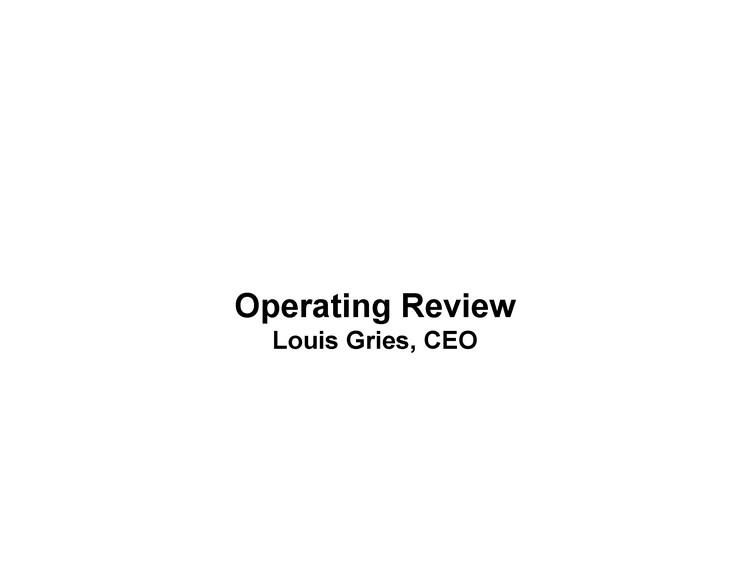
| Operating Review Louis Gries, CEO |
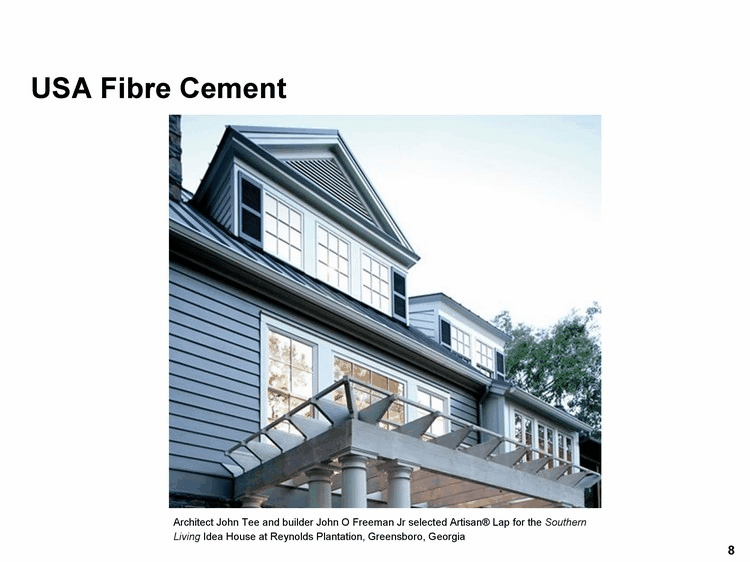
| USA Fibre Cement Architect John Tee and builder John O Freeman Jr selected Artisan(r) Lap for the Southern Living Idea House at Reynolds Plantation, Greensboro, Georgia |
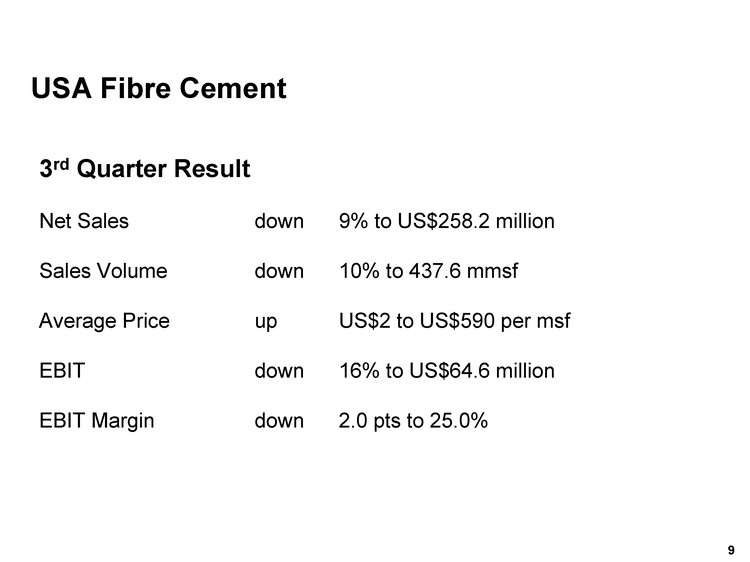
| 3rd Quarter Result Net Sales down 9% to US$258.2 million Sales Volume down 10% to 437.6 mmsf Average Price up US$2 to US$590 per msf EBIT down 16% to US$64.6 million EBIT Margin down 2.0 pts to 25.0% USA Fibre Cement |

| Nine Months Result Net Sales down 6% to US$912.3 million Sales Volume down 8% to 1,522.7 mmsf Average Price up 2% to US$599 per msf EBIT down 5% to US$263.3 million EBIT Margin up 0.3 pt to 28.9% USA Fibre Cement |
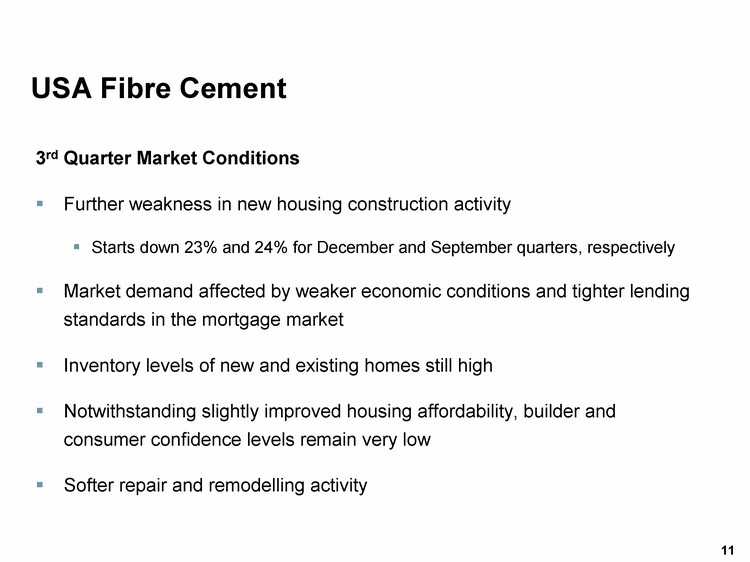
| 3rd Quarter Market Conditions Further weakness in new housing construction activity Starts down 23% and 24% for December and September quarters, respectively Market demand affected by weaker economic conditions and tighter lending standards in the mortgage market Inventory levels of new and existing homes still high Notwithstanding slightly improved housing affordability, builder and consumer confidence levels remain very low Softer repair and remodelling activity USA Fibre Cement |
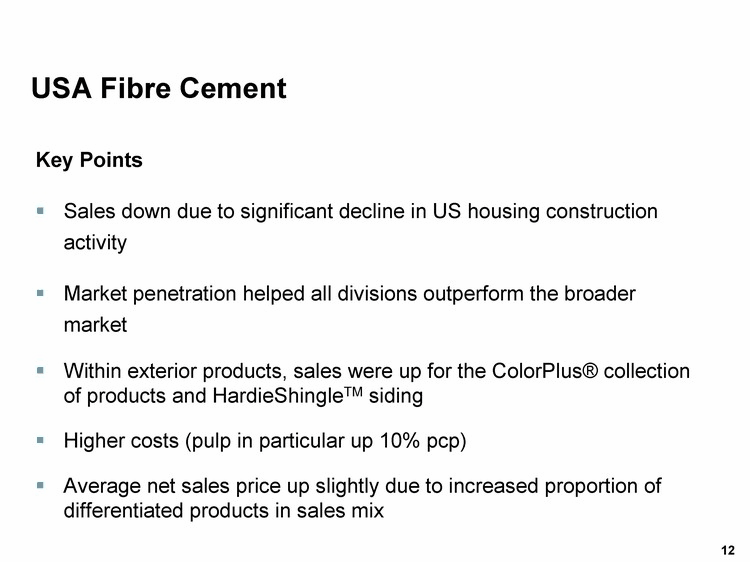
| Key Points Sales down due to significant decline in US housing construction activity Market penetration helped all divisions outperform the broader market Within exterior products, sales were up for the ColorPlus(r) collection of products and HardieShingleTM siding Higher costs (pulp in particular up 10% pcp) Average net sales price up slightly due to increased proportion of differentiated products in sales mix USA Fibre Cement |
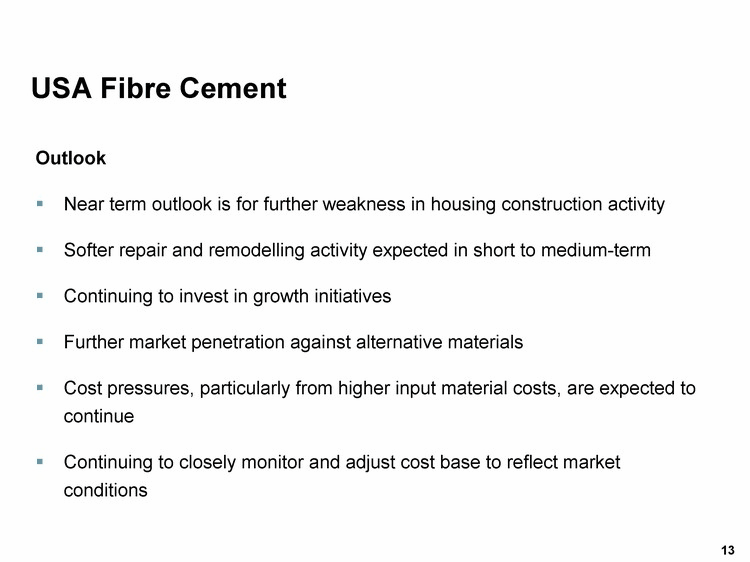
| Outlook Near term outlook is for further weakness in housing construction activity Softer repair and remodelling activity expected in short to medium-term Continuing to invest in growth initiatives Further market penetration against alternative materials Cost pressures, particularly from higher input material costs, are expected to continue Continuing to closely monitor and adjust cost base to reflect market conditions USA Fibre Cement |
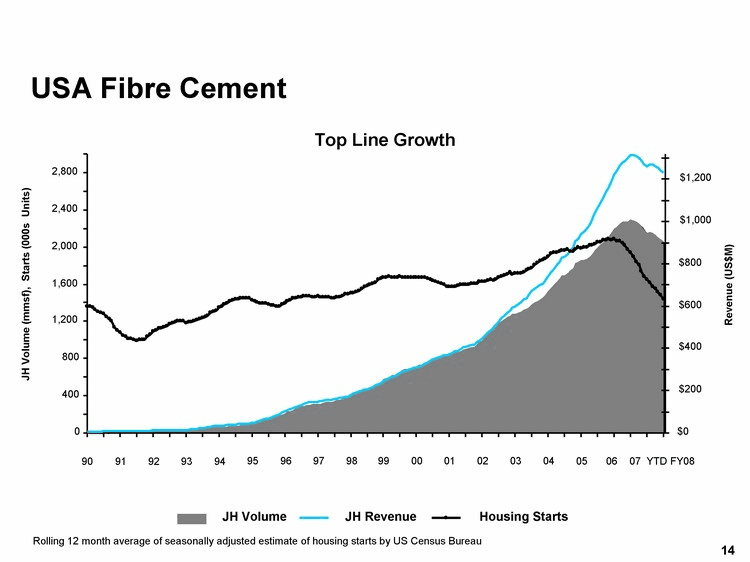
| Rolling 12 month average of seasonally adjusted estimate of housing starts by US Census Bureau USA Fibre Cement Top Line Growth 0 400 800 1,200 1,600 2,000 2,400 2,800 90 91 92 93 94 95 96 97 98 99 00 01 02 03 04 05 06 07 YTD FY08 JH Volume (mmsf), Starts (000s Units) $0 $200 $400 $600 $800 $1,000 $1,200 Revenue (US$M) JH Volume JH Revenue Housing Starts |
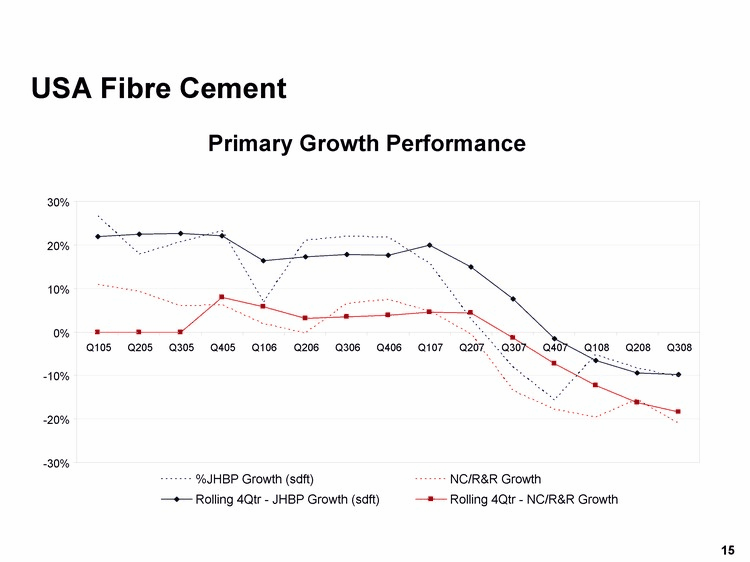
| USA Fibre Cement Primary Growth Performance NC/R&R Growth Rolling 4Qtr - JHBP Growth (sdft) Rolling 4Qtr - NC/R&R Growth |
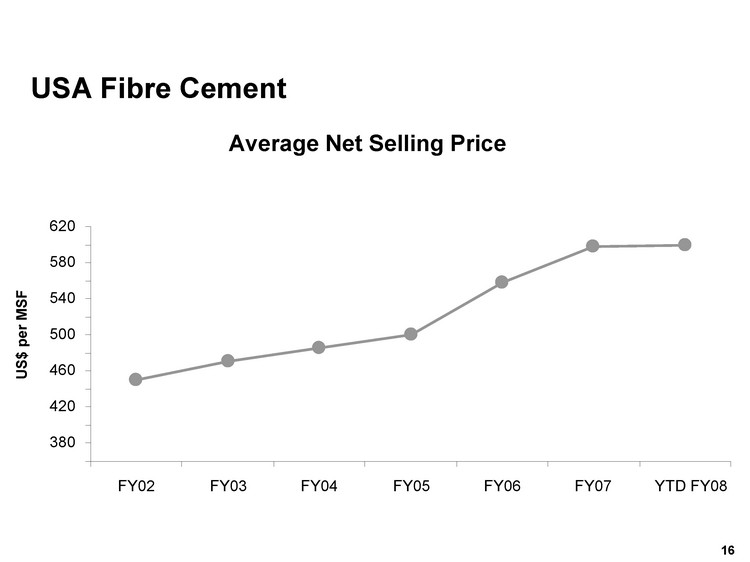
| USA Fibre Cement Average Net Selling Price US$ per MSF 380 420 460 500 540 580 620 FY02 FY03 FY04 FY05 FY06 FY07 YTD FY08 |
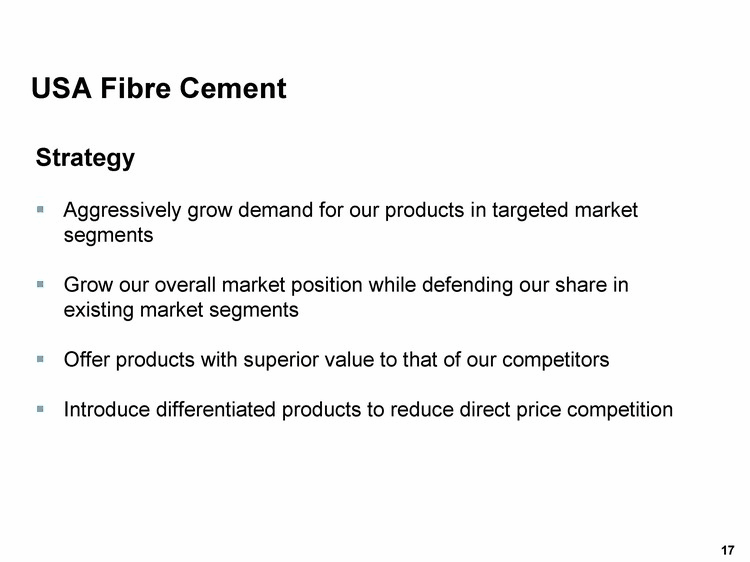
| Strategy Aggressively grow demand for our products in targeted market segments Grow our overall market position while defending our share in existing market segments Offer products with superior value to that of our competitors Introduce differentiated products to reduce direct price competition USA Fibre Cement |
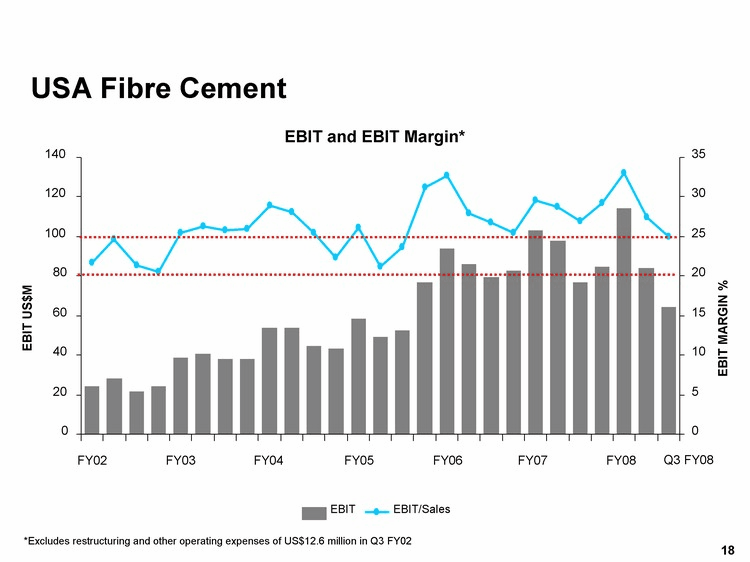
| *Excludes restructuring and other operating expenses of US$12.6 million in Q3 FY02 USA Fibre Cement EBIT EBIT/Sales EBIT and EBIT Margin* 0 20 40 60 80 100 120 140 FY02 FY03 FY04 FY05 FY06 FY07 FY08 EBIT US$M 0 5 10 15 20 25 30 35 EBIT MARGIN % Q3 FY08 |

| USA Housing Starts History Source: US Census Bureau - (Annual) New Privately Owned Housing Units Started Single Family Multi-Family 0 500 1,000 1,500 2,000 2,500 1959 1961 1963 1965 1967 1969 1971 1973 1975 1977 1979 1981 1983 1985 1987 1989 1991 1993 1995 1997 1999 2001 2003 2005 2007 Strength of future recovery uncertain - positive demographics offset by high inventory and affordability issues + consumer confidence and credit availability |
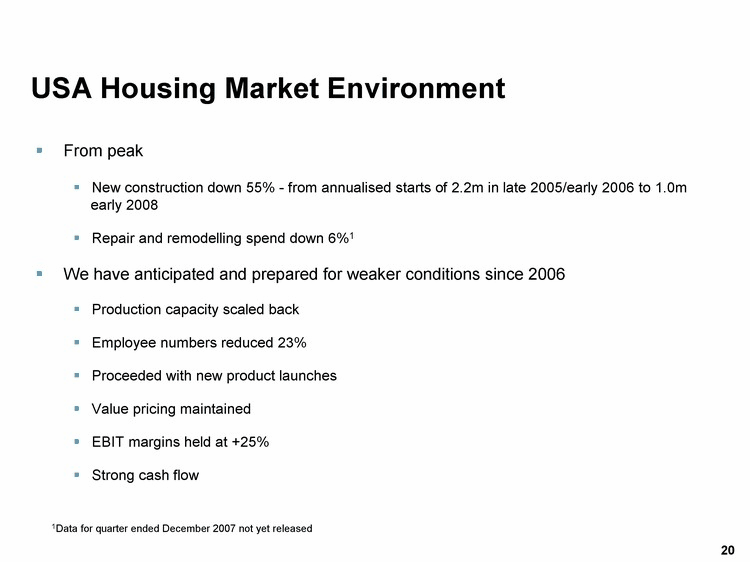
| From peak New construction down 55% - from annualised starts of 2.2m in late 2005/early 2006 to 1.0m early 2008 Repair and remodelling spend down 6%1 We have anticipated and prepared for weaker conditions since 2006 Production capacity scaled back Employee numbers reduced 23% Proceeded with new product launches Value pricing maintained EBIT margins held at +25% Strong cash flow USA Housing Market Environment 1Data for quarter ended December 2007 not yet released |
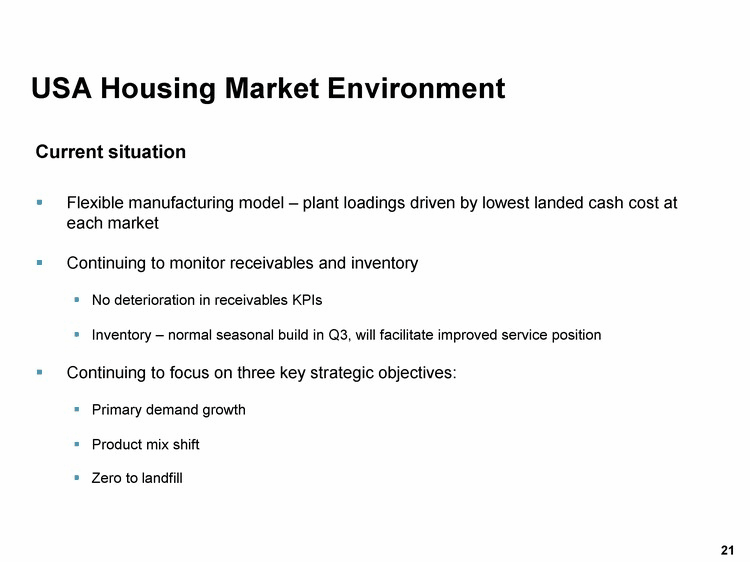
| Current situation Flexible manufacturing model - plant loadings driven by lowest landed cash cost at each market Continuing to monitor receivables and inventory No deterioration in receivables KPIs Inventory - normal seasonal build in Q3, will facilitate improved service position Continuing to focus on three key strategic objectives: Primary demand growth Product mix shift Zero to landfill USA Housing Market Environment |

| Asia Pacific Fibre Cement Landcom's sales office at Garden Gates estate, Mt Annan, NSW, was designed by BHI Architects and built by Admark using Scyon(tm) Linea(tm) weatherboards, Scyon(tm) Matrix(tm) cladding, Scyon(tm) Axon(tm) cladding and Scyon(tm) Trim |
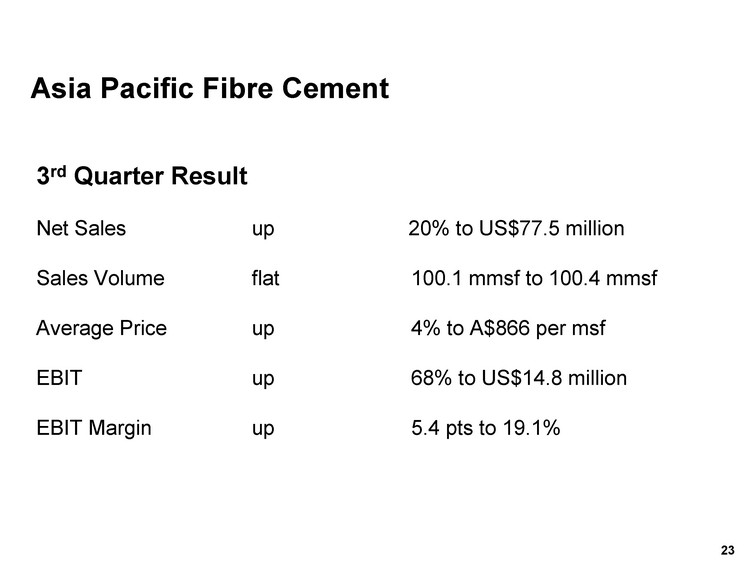
| 3rd Quarter Result Net Sales up 20% to US$77.5 million Sales Volume flat 100.1 mmsf to 100.4 mmsf Average Price up 4% to A$866 per msf EBIT up 68% to US$14.8 million EBIT Margin up 5.4 pts to 19.1% Asia Pacific Fibre Cement |
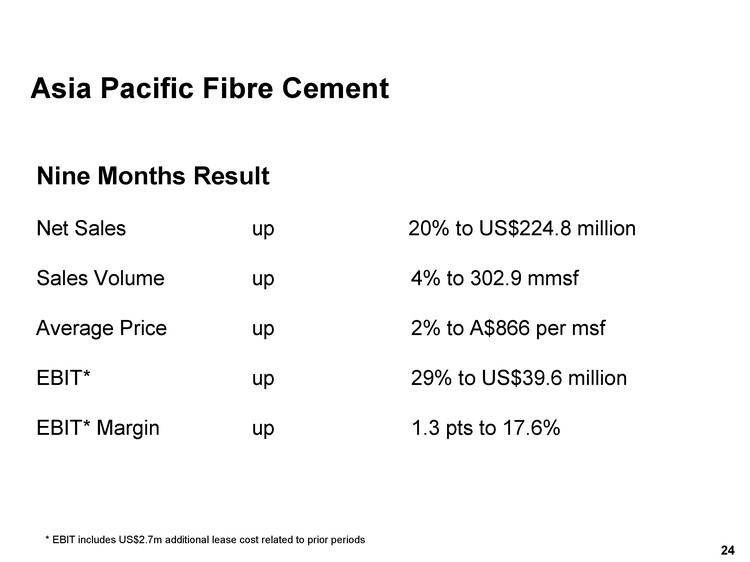
| Nine Months Result Net Sales up 20% to US$224.8 million Sales Volume up 4% to 302.9 mmsf Average Price up 2% to A$866 per msf EBIT* up 29% to US$39.6 million EBIT* Margin up 1.3 pts to 17.6% Asia Pacific Fibre Cement * EBIT includes US$2.7m additional lease cost related to prior periods |
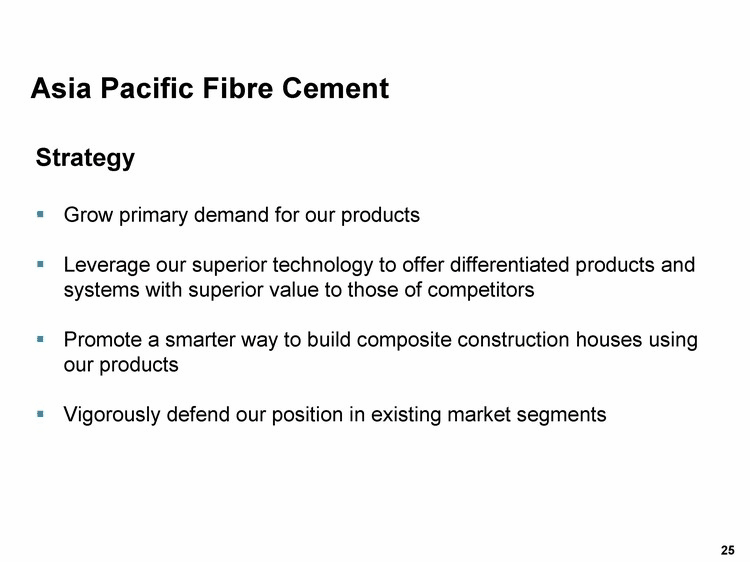
| Strategy Grow primary demand for our products Leverage our superior technology to offer differentiated products and systems with superior value to those of competitors Promote a smarter way to build composite construction houses using our products Vigorously defend our position in existing market segments Asia Pacific Fibre Cement |
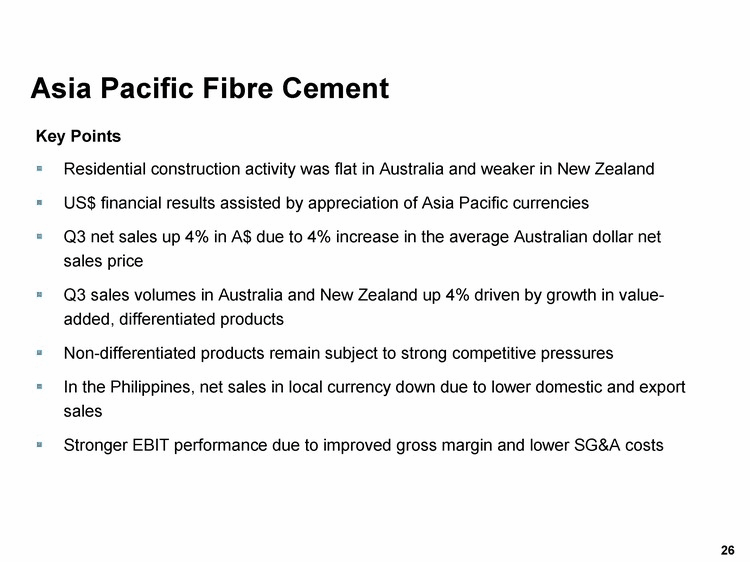
| Key Points Residential construction activity was flat in Australia and weaker in New Zealand US$ financial results assisted by appreciation of Asia Pacific currencies Q3 net sales up 4% in A$ due to 4% increase in the average Australian dollar net sales price Q3 sales volumes in Australia and New Zealand up 4% driven by growth in value- added, differentiated products Non-differentiated products remain subject to strong competitive pressures In the Philippines, net sales in local currency down due to lower domestic and export sales Stronger EBIT performance due to improved gross margin and lower SG&A costs Asia Pacific Fibre Cement |

| Outlook Residential construction activity is expected to be flat in Australia, down in New Zealand and slightly stronger in the Philippines in the short-term Further primary demand growth for fibre cement in Australia and New Zealand Non-differentiated products in Australia are expected to remain subject to strong competition More manufacturing efficiencies and other cost savings, but higher raw material costs Asia Pacific Fibre Cement |
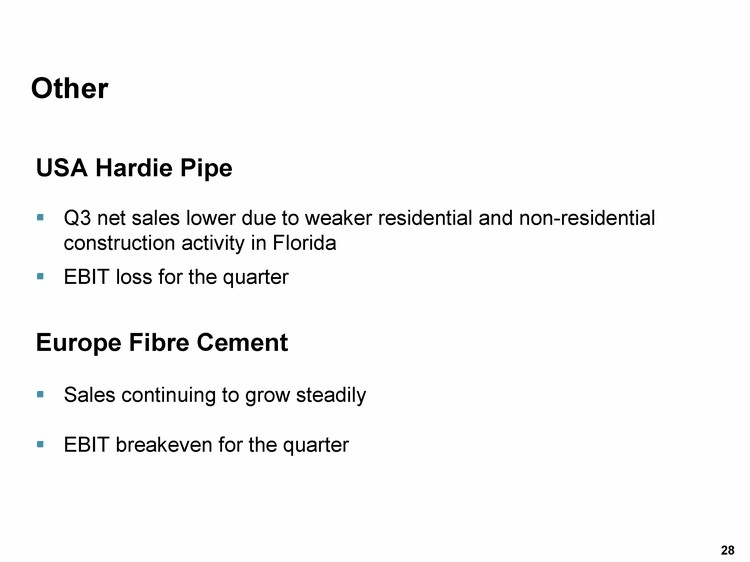
| USA Hardie Pipe Q3 net sales lower due to weaker residential and non-residential construction activity in Florida EBIT loss for the quarter Europe Fibre Cement Sales continuing to grow steadily EBIT breakeven for the quarter Other |
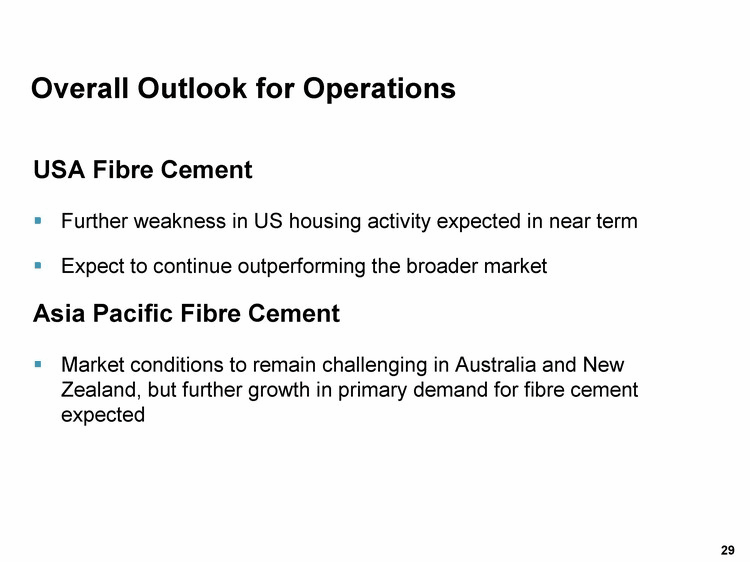
| USA Fibre Cement Further weakness in US housing activity expected in near term Expect to continue outperforming the broader market Asia Pacific Fibre Cement Market conditions to remain challenging in Australia and New Zealand, but further growth in primary demand for fibre cement expected Overall Outlook for Operations |
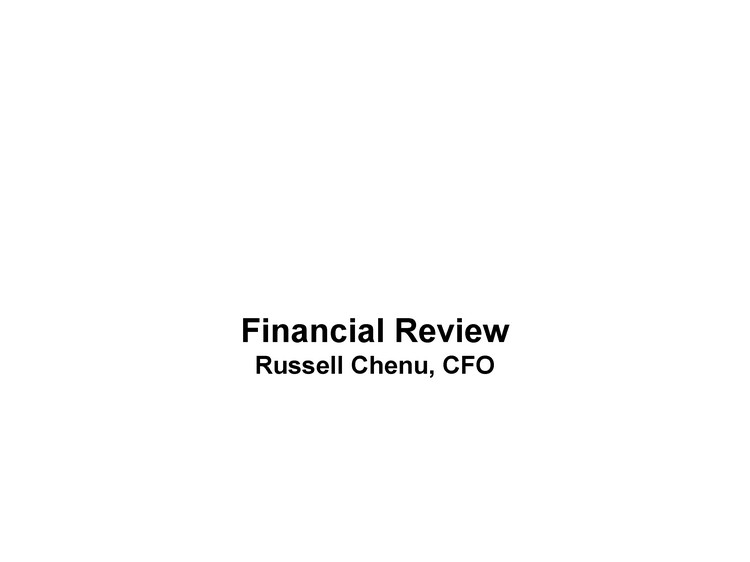
| Financial Review Russell Chenu, CFO |
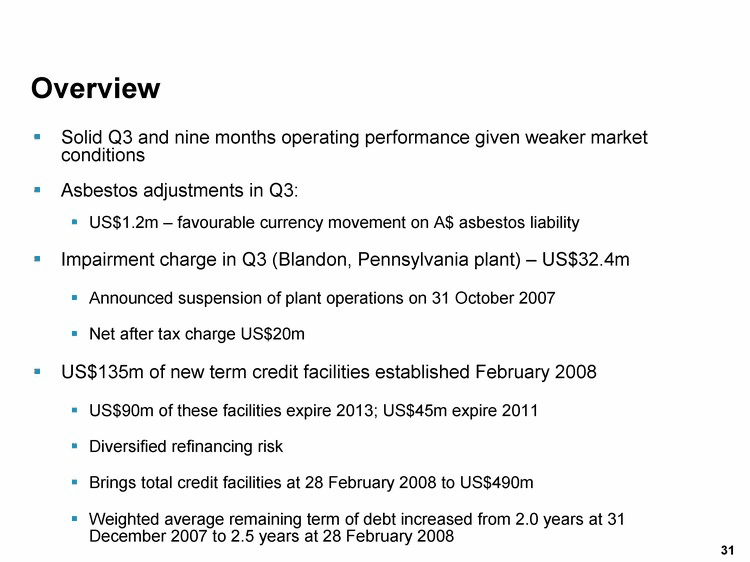
| Solid Q3 and nine months operating performance given weaker market conditions Asbestos adjustments in Q3: US$1.2m - favourable currency movement on A$ asbestos liability Impairment charge in Q3 (Blandon, Pennsylvania plant) - US$32.4m Announced suspension of plant operations on 31 October 2007 Net after tax charge US$20m US$135m of new term credit facilities established February 2008 US$90m of these facilities expire 2013; US$45m expire 2011 Diversified refinancing risk Brings total credit facilities at 28 February 2008 to US$490m Weighted average remaining term of debt increased from 2.0 years at 31 December 2007 to 2.5 years at 28 February 2008 Overview |
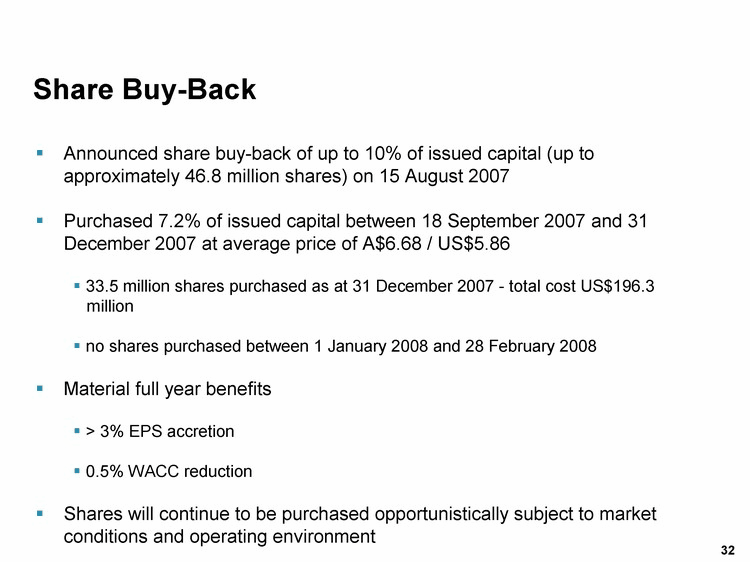
| Share Buy-Back Announced share buy-back of up to 10% of issued capital (up to approximately 46.8 million shares) on 15 August 2007 Purchased 7.2% of issued capital between 18 September 2007 and 31 December 2007 at average price of A$6.68 / US$5.86 33.5 million shares purchased as at 31 December 2007 - total cost US$196.3 million no shares purchased between 1 January 2008 and 28 February 2008 Material full year benefits > 3% EPS accretion 0.5% WACC reduction Shares will continue to be purchased opportunistically subject to market conditions and operating environment |
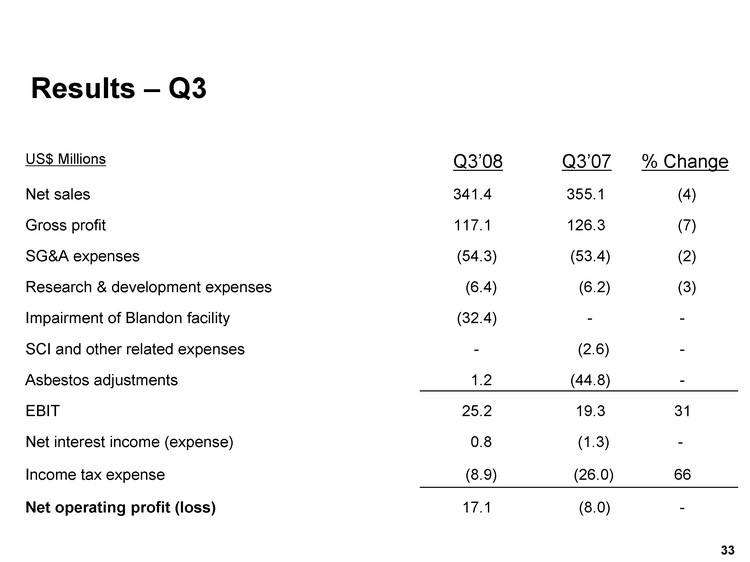
| US$ Millions Q3'08 Q3'07 % Change Net sales 341.4 355.1 (4) Gross profit 117.1 126.3 (7) SG&A expenses (54.3) (53.4) (2) Research & development expenses (6.4) (6.2) (3) Impairment of Blandon facility (32.4) - - SCI and other related expenses - (2.6) - Asbestos adjustments 1.2 (44.8) - EBIT 25.2 19.3 31 Net interest income (expense) 0.8 (1.3) - Income tax expense (8.9) (26.0) 66 Net operating profit (loss) 17.1 (8.0) - Results - Q3 |
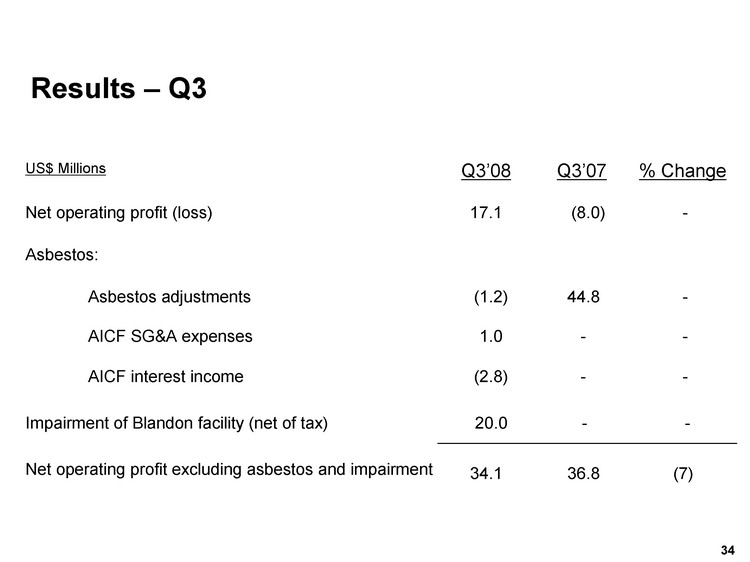
| US$ Millions Q3'08 Q3'07 % Change Net operating profit (loss) 17.1 (8.0) - Asbestos: Asbestos adjustments (1.2) 44.8 - AICF SG&A expenses 1.0 - - AICF interest income (2.8) - - Impairment of Blandon facility (net of tax) 20.0 - - Net operating profit excluding asbestos and impairment 34.1 36.8 (7) Results - Q3 |
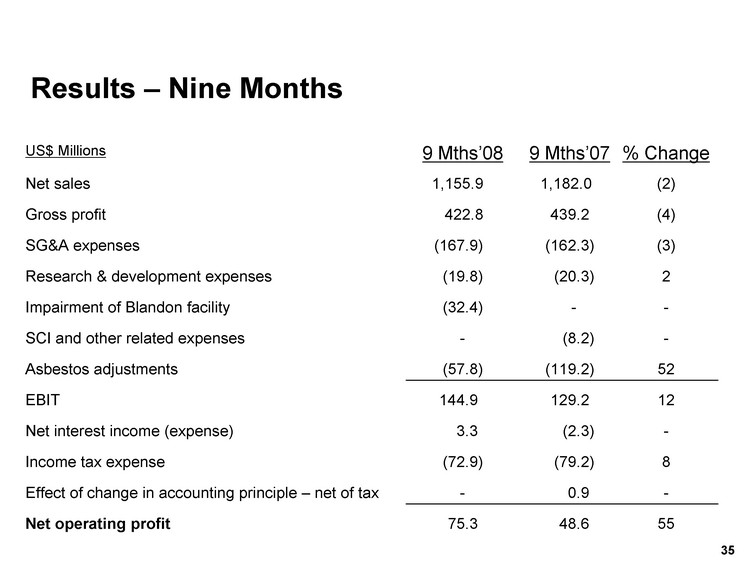
| US$ Millions 9 Mths'08 9 Mths'07 % Change Net sales 1,155.9 1,182.0 (2) Gross profit 422.8 439.2 (4) SG&A expenses (167.9) (162.3) (3) Research & development expenses (19.8) (20.3) 2 Impairment of Blandon facility (32.4) - - SCI and other related expenses - (8.2) - Asbestos adjustments (57.8) (119.2) 52 EBIT 144.9 129.2 12 Net interest income (expense) 3.3 (2.3) - Income tax expense (72.9) (79.2) 8 Effect of change in accounting principle - net of tax - 0.9 - Net operating profit 75.3 48.6 55 Results - Nine Months |
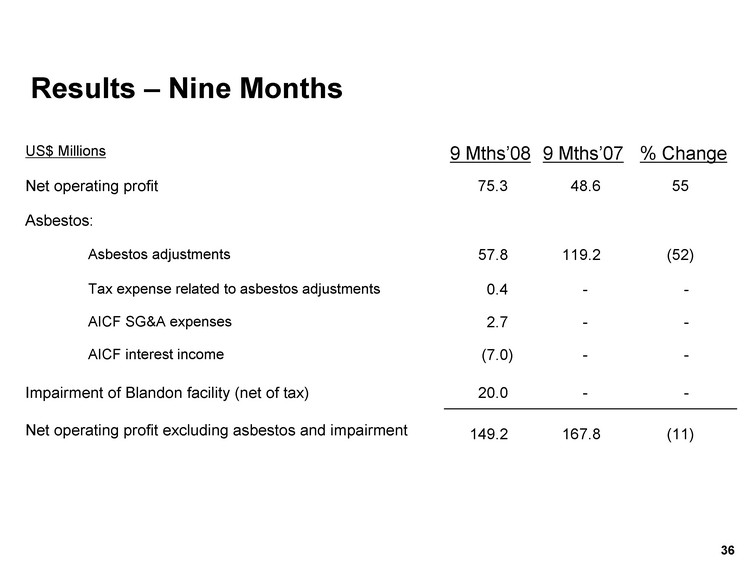
| US$ Millions 9 Mths'08 9 Mths'07 % Change Net operating profit 75.3 48.6 55 Asbestos: Asbestos adjustments 57.8 119.2 (52) Tax expense related to asbestos adjustments 0.4 - - AICF SG&A expenses 2.7 - - AICF interest income (7.0) - - Impairment of Blandon facility (net of tax) 20.0 - - Net operating profit excluding asbestos and impairment 149.2 167.8 (11) Results - Nine Months |
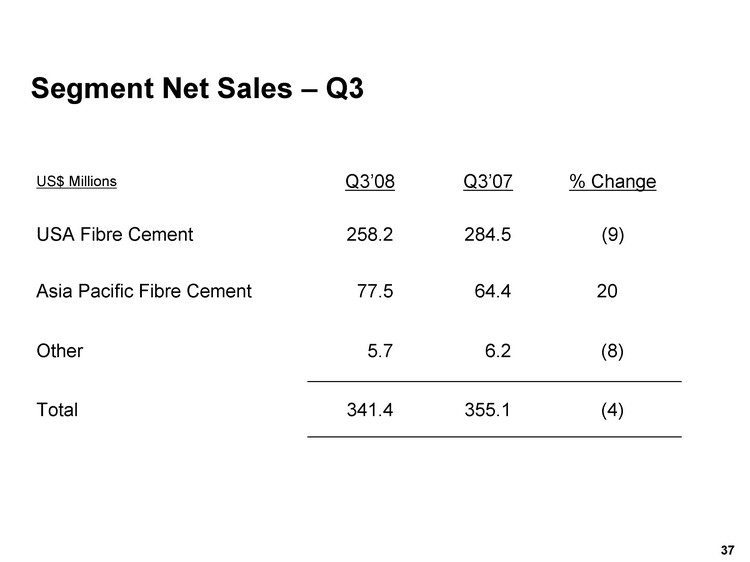
| US$ Millions Q3'08 Q3'07 % Change USA Fibre Cement 258.2 284.5 (9) Asia Pacific Fibre Cement 77.5 64.4 20 Other 5.7 6.2 (8) Total 341.4 355.1 (4) Segment Net Sales - Q3 |
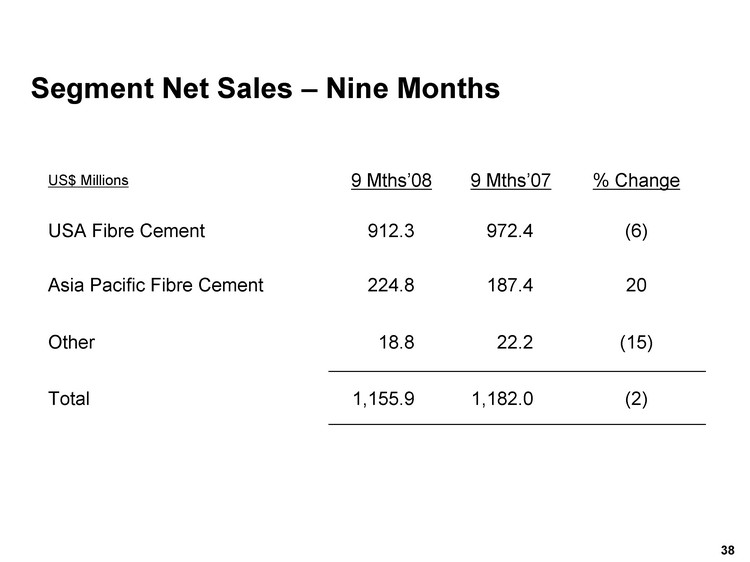
| US$ Millions 9 Mths'08 9 Mths'07 % Change USA Fibre Cement 912.3 972.4 (6) Asia Pacific Fibre Cement 224.8 187.4 20 Other 18.8 22.2 (15) Total 1,155.9 1,182.0 (2) Segment Net Sales - Nine Months |

| US$ Millions Q3'08 Q3'07 % Change USA Fibre Cement 64.6 76.7 (16) Asia Pacific Fibre Cement 14.8 8.8 68 Other (1.3) (2.4) 46 R & D1 (4.2) (4.9) 14 Total Segment EBIT excluding impairment 73.9 78.2 (5) General Corporate (16.5) (14.1) (17) Total EBIT excluding asbestos and impairment 57.4 64.1 (10) Asbestos adjustments 1.2 (44.8) - AICF SG&A expenses (1.0) - - Impairment of Blandon facility (32.4) - - Total EBIT 25.2 19.3 31 1 R&D includes "core" R&D expenses and administrative expenses, but excludes product development expenses Segment EBIT - Q3 |
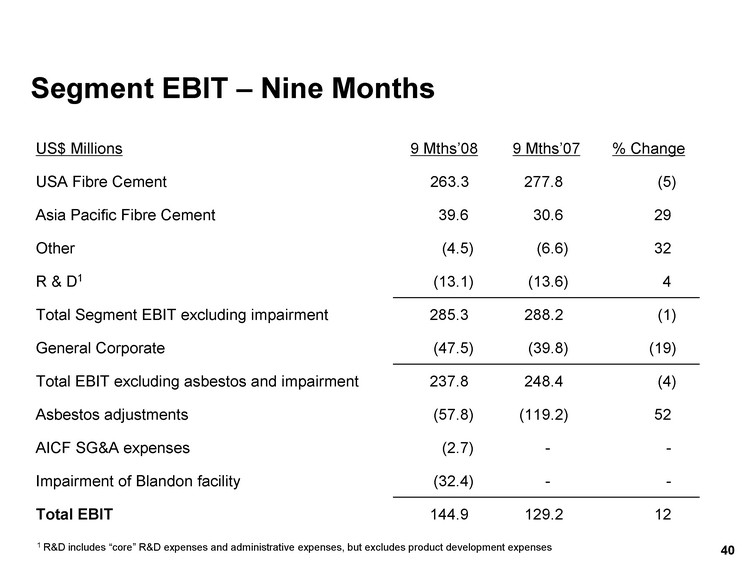
| US$ Millions 9 Mths'08 9 Mths'07 % Change USA Fibre Cement 263.3 277.8 (5) Asia Pacific Fibre Cement 39.6 30.6 29 Other (4.5) (6.6) 32 R & D1 (13.1) (13.6) 4 Total Segment EBIT excluding impairment 285.3 288.2 (1) General Corporate (47.5) (39.8) (19) Total EBIT excluding asbestos and impairment 237.8 248.4 (4) Asbestos adjustments (57.8) (119.2) 52 AICF SG&A expenses (2.7) - - Impairment of Blandon facility (32.4) - - Total EBIT 144.9 129.2 12 1 R&D includes "core" R&D expenses and administrative expenses, but excludes product development expenses Segment EBIT - Nine Months |
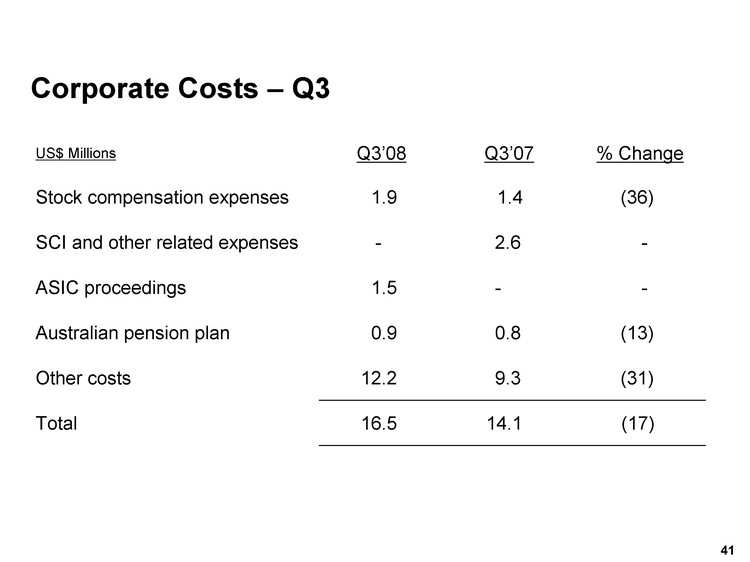
| US$ Millions Q3'08 Q3'07 % Change Stock compensation expenses 1.9 1.4 (36) SCI and other related expenses - 2.6 - ASIC proceedings 1.5 - - Australian pension plan 0.9 0.8 (13) Other costs 12.2 9.3 (31) Total 16.5 14.1 (17) Corporate Costs - Q3 |

| US$ Millions 9 Mths'08 9 Mths'07 % Change Stock compensation expenses 5.0 4.1 (22) SCI and other related expenses - 8.2 - Non-US warranty provision 4.0 - - ASIC proceedings 4.6 - - Australian pension plan 2.0 2.3 13 Other costs 31.9 25.2 (27) Total 47.5 39.8 (27) Corporate Costs - Nine Months |
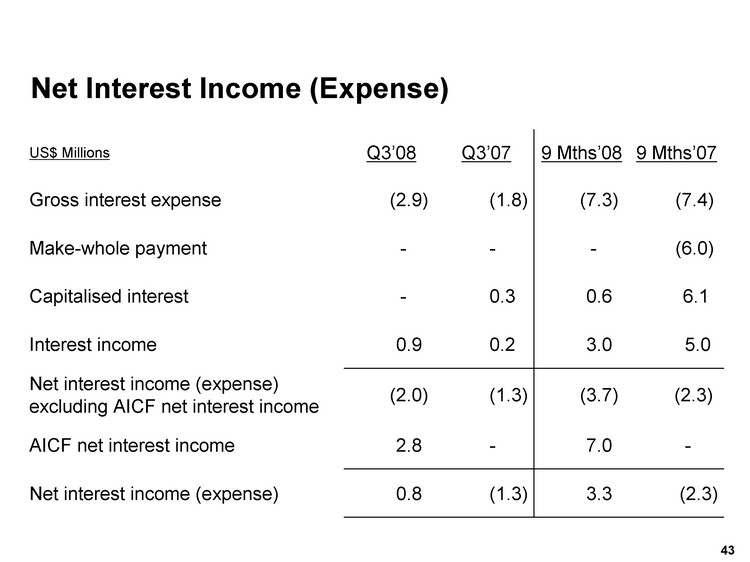
| Net Interest Income (Expense) US$ Millions Q3'08 Q3'07 9 Mths'08 9 Mths'07 Gross interest expense (2.9) (1.8) (7.3) (7.4) Make-whole payment - - - (6.0) Capitalised interest - 0.3 0.6 6.1 Interest income 0.9 0.2 3.0 5.0 Net interest income (expense) excluding AICF net interest income (2.0) (1.3) (3.7) (2.3) AICF net interest income 2.8 - 7.0 - Net interest income (expense) 0.8 (1.3) 3.3 (2.3) |
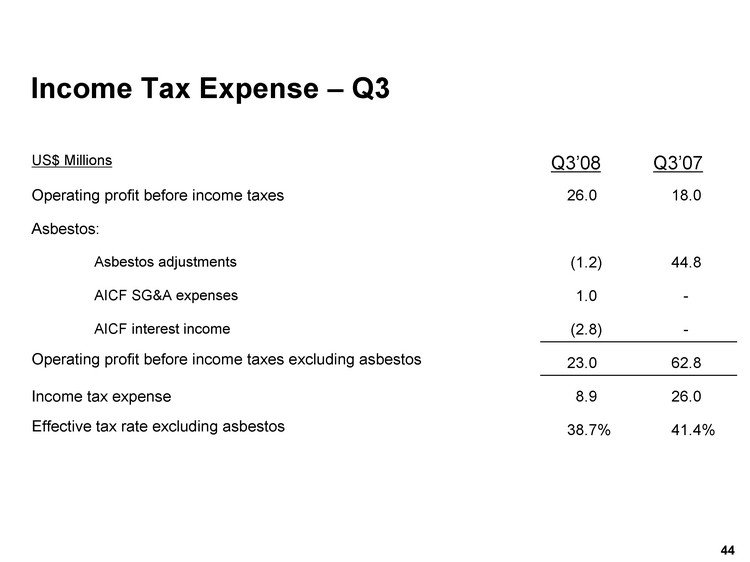
| US$ Millions Q3'08 Q3'07 Operating profit before income taxes 26.0 18.0 Asbestos: Asbestos adjustments (1.2) 44.8 AICF SG&A expenses 1.0 - AICF interest income (2.8) - Operating profit before income taxes excluding asbestos 23.0 62.8 Income tax expense 8.9 26.0 Effective tax rate excluding asbestos 38.7% 41.4% Income Tax Expense - Q3 |
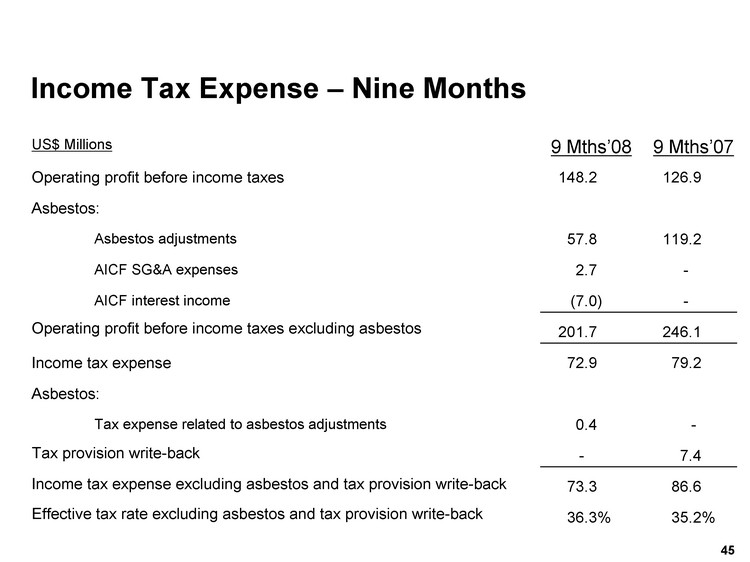
| US$ Millions 9 Mths'08 9 Mths'07 Operating profit before income taxes 148.2 126.9 Asbestos: Asbestos adjustments 57.8 119.2 AICF SG&A expenses 2.7 - AICF interest income (7.0) - Operating profit before income taxes excluding asbestos 201.7 246.1 Income tax expense 72.9 79.2 Asbestos: Tax expense related to asbestos adjustments 0.4 - Tax provision write-back - 7.4 Income tax expense excluding asbestos and tax provision write-back 73.3 86.6 Effective tax rate excluding asbestos and tax provision write-back 36.3% 35.2% Income Tax Expense - Nine Months |
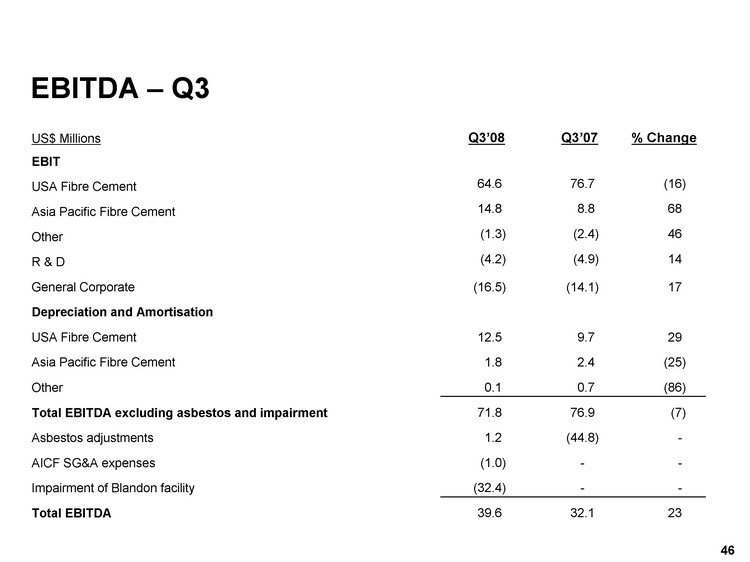
| US$ Millions Q3'08 Q3'07 % Change EBIT USA Fibre Cement 64.6 76.7 (16) Asia Pacific Fibre Cement 14.8 8.8 68 Other (1.3) (2.4) 46 R & D (4.2) (4.9) 14 General Corporate (16.5) (14.1) 17 Depreciation and Amortisation USA Fibre Cement 12.5 9.7 29 Asia Pacific Fibre Cement 1.8 2.4 (25) Other 0.1 0.7 (86) Total EBITDA excluding asbestos and impairment 71.8 76.9 (7) Asbestos adjustments 1.2 (44.8) - AICF SG&A expenses (1.0) - - Impairment of Blandon facility (32.4) - - Total EBITDA 39.6 32.1 23 EBITDA - Q3 |
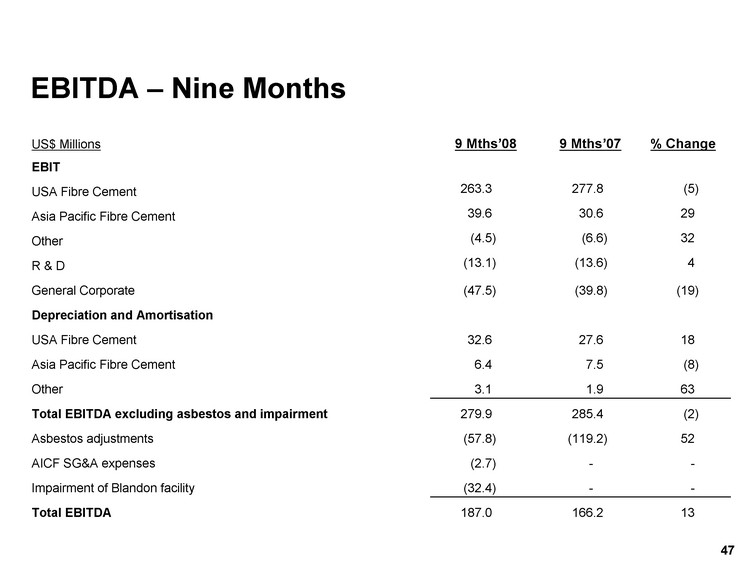
| US$ Millions 9 Mths'08 9 Mths'07 % Change EBIT USA Fibre Cement 263.3 277.8 (5) Asia Pacific Fibre Cement 39.6 30.6 29 Other (4.5) (6.6) 32 R & D (13.1) (13.6) 4 General Corporate (47.5) (39.8) (19) Depreciation and Amortisation USA Fibre Cement 32.6 27.6 18 Asia Pacific Fibre Cement 6.4 7.5 (8) Other 3.1 1.9 63 Total EBITDA excluding asbestos and impairment 279.9 285.4 (2) Asbestos adjustments (57.8) (119.2) 52 AICF SG&A expenses (2.7) - - Impairment of Blandon facility (32.4) - - Total EBITDA 187.0 166.2 13 EBITDA - Nine Months |
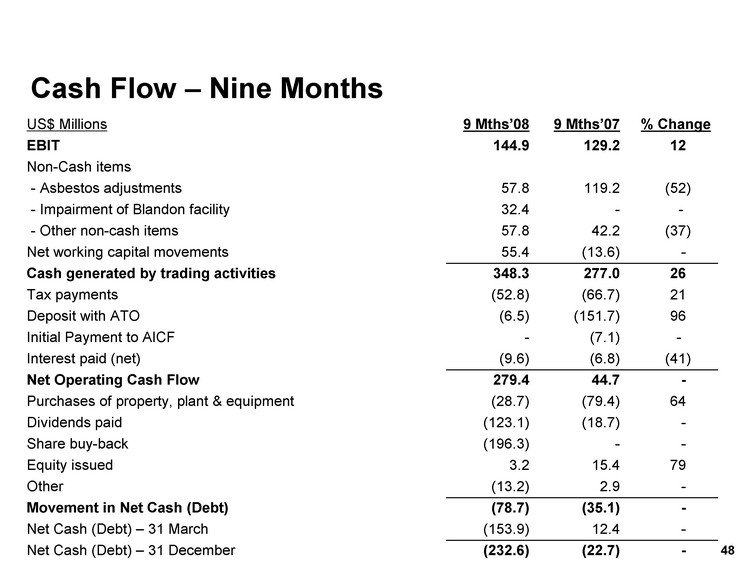
| Cash Flow - Nine Months US$ Millions 9 Mths'08 9 Mths'07 % Change EBIT 144.9 129.2 12 Non-Cash items - Asbestos adjustments 57.8 119.2 (52) - Impairment of Blandon facility 32.4 - - - Other non-cash items 57.8 42.2 (37) Net working capital movements 55.4 (13.6) - Cash generated by trading activities 348.3 277.0 26 Tax payments (52.8) (66.7) 21 Deposit with ATO (6.5) (151.7) 96 Initial Payment to AICF - (7.1) - Interest paid (net) (9.6) (6.8) (41) Net Operating Cash Flow 279.4 44.7 - Purchases of property, plant & equipment (28.7) (79.4) 64 Dividends paid (123.1) (18.7) - Share buy-back (196.3) - - Equity issued 3.2 15.4 79 Other (13.2) 2.9 - Movement in Net Cash (Debt) (78.7) (35.1) - Net Cash (Debt) - 31 March (153.9) 12.4 - Net Cash (Debt) - 31 December (232.6) (22.7) - |
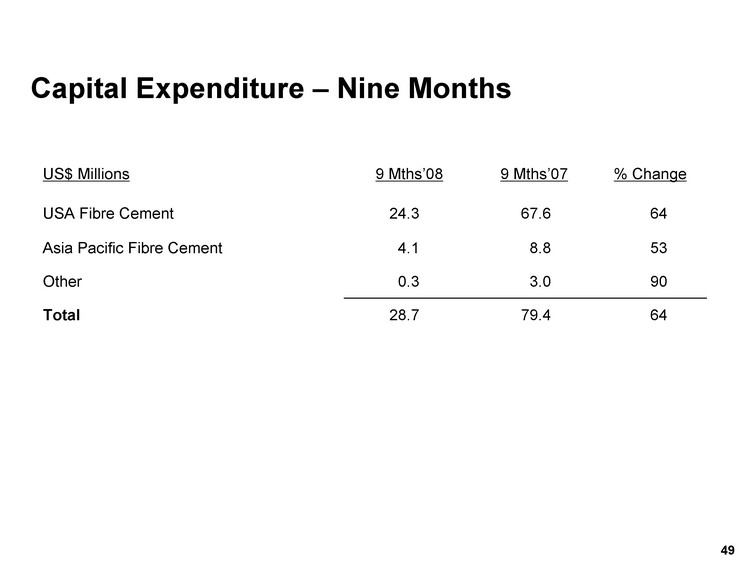
| US$ Millions 9 Mths'08 9 Mths'07 % Change USA Fibre Cement 24.3 67.6 64 Asia Pacific Fibre Cement 4.1 8.8 53 Other 0.3 3.0 90 Total 28.7 79.4 64 Capital Expenditure - Nine Months |
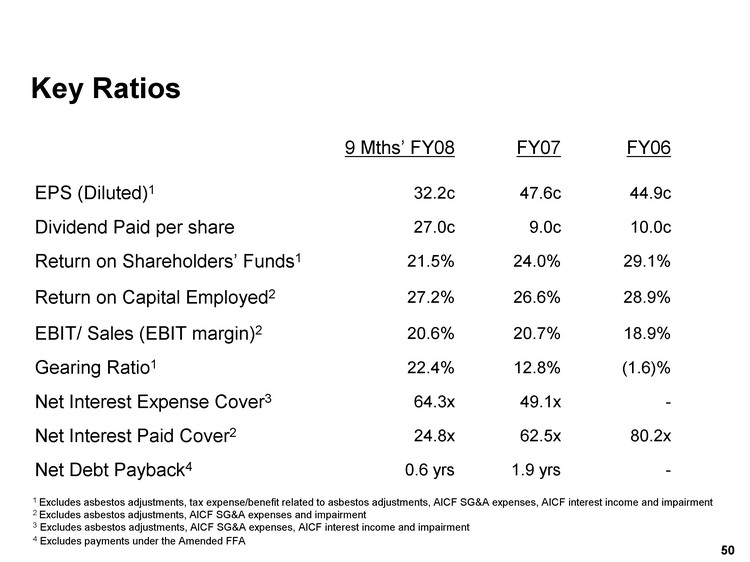
| 9 Mths' FY08 FY07 FY06 EPS (Diluted)1 32.2c 47.6c 44.9c Dividend Paid per share 27.0c 9.0c 10.0c Return on Shareholders' Funds1 21.5% 24.0% 29.1% Return on Capital Employed2 27.2% 26.6% 28.9% EBIT/ Sales (EBIT margin)2 20.6% 20.7% 18.9% Gearing Ratio1 22.4% 12.8% (1.6)% Net Interest Expense Cover3 64.3x 49.1x - Net Interest Paid Cover2 24.8x 62.5x 80.2x Net Debt Payback4 0.6 yrs 1.9 yrs - 1 Excludes asbestos adjustments, tax expense/benefit related to asbestos adjustments, AICF SG&A expenses, AICF interest income and impairment 2 Excludes asbestos adjustments, AICF SG&A expenses and impairment 3 Excludes asbestos adjustments, AICF SG&A expenses, AICF interest income and impairment 4 Excludes payments under the Amended FFA Key Ratios |
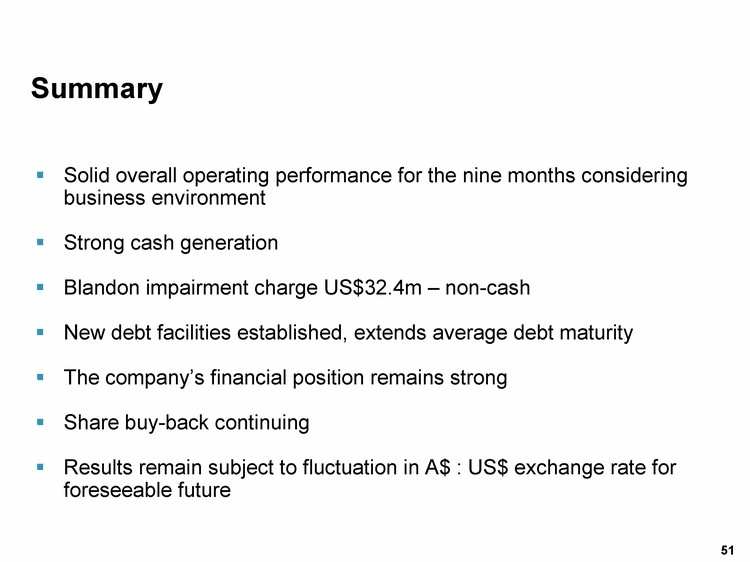
| Solid overall operating performance for the nine months considering business environment Strong cash generation Blandon impairment charge US$32.4m - non-cash New debt facilities established, extends average debt maturity The company's financial position remains strong Share buy-back continuing Results remain subject to fluctuation in A$ : US$ exchange rate for foreseeable future Summary |

| Questions & Answers |
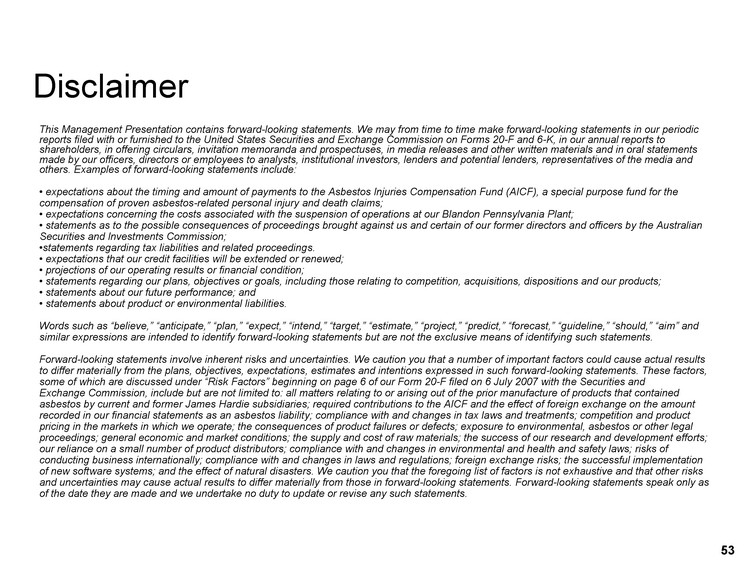
| Disclaimer This Management Presentation contains forward-looking statements. We may from time to time make forward-looking statements in our periodic reports filed with or furnished to the United States Securities and Exchange Commission on Forms 20-F and 6-K, in our annual reports to shareholders, in offering circulars, invitation memoranda and prospectuses, in media releases and other written materials and in oral statements made by our officers, directors or employees to analysts, institutional investors, lenders and potential lenders, representatives of the media and others. Examples of forward-looking statements include: expectations about the timing and amount of payments to the Asbestos Injuries Compensation Fund (AICF), a special purpose fund for the compensation of proven asbestos-related personal injury and death claims; expectations concerning the costs associated with the suspension of operations at our Blandon Pennsylvania Plant; statements as to the possible consequences of proceedings brought against us and certain of our former directors and officers by the Australian Securities and Investments Commission; statements regarding tax liabilities and related proceedings. expectations that our credit facilities will be extended or renewed; projections of our operating results or financial condition; statements regarding our plans, objectives or goals, including those relating to competition, acquisitions, dispositions and our products; statements about our future performance; and statements about product or environmental liabilities. Words such as "believe," "anticipate," "plan," "expect," "intend," "target," "estimate," "project," "predict," "forecast," "guideline," "should," "aim" and similar expressions are intended to identify forward-looking statements but are not the exclusive means of identifying such statements. Forward-looking statements involve inherent risks and uncertainties. We caution you that a number of important factors could cause actual results to differ materially from the plans, objectives, expectations, estimates and intentions expressed in such forward-looking statements. These factors, some of which are discussed under "Risk Factors" beginning on page 6 of our Form 20-F filed on 6 July 2007 with the Securities and Exchange Commission, include but are not limited to: all matters relating to or arising out of the prior manufacture of products that contained asbestos by current and former James Hardie subsidiaries; required contributions to the AICF and the effect of foreign exchange on the amount recorded in our financial statements as an asbestos liability; compliance with and changes in tax laws and treatments; competition and product pricing in the markets in which we operate; the consequences of product failures or defects; exposure to environmental, asbestos or other legal proceedings; general economic and market conditions; the supply and cost of raw materials; the success of our research and development efforts; our reliance on a small number of product distributors; compliance with and changes in environmental and health and safety laws; risks of conducting business internationally; compliance with and changes in laws and regulations; foreign exchange risks; the successful implementation of new software systems; and the effect of natural disasters. We caution you that the foregoing list of factors is not exhaustive and that other risks and uncertainties may cause actual results to differ materially from those in forward-looking statements. Forward-looking statements speak only as of the date they are made and we undertake no duty to update or revise any such statements. |
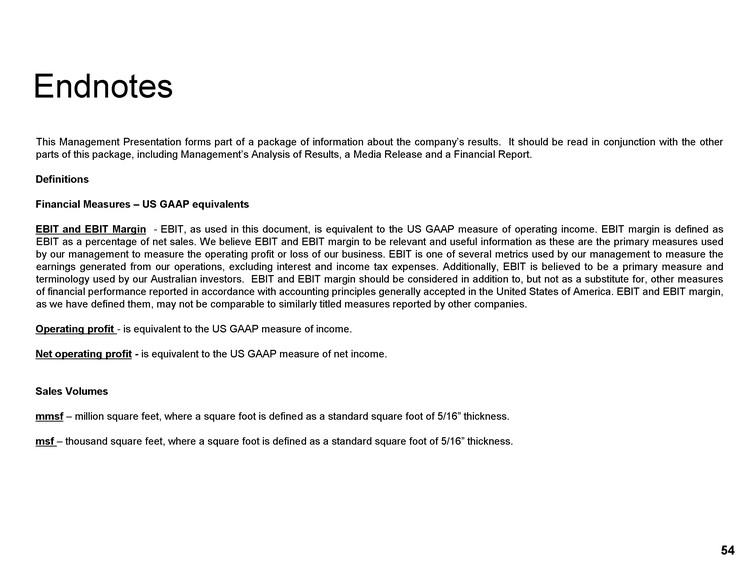
| Endnotes This Management Presentation forms part of a package of information about the company's results. It should be read in conjunction with the other parts of this package, including Management's Analysis of Results, a Media Release and a Financial Report. Definitions Financial Measures - US GAAP equivalents EBIT and EBIT Margin - EBIT, as used in this document, is equivalent to the US GAAP measure of operating income. EBIT margin is defined as EBIT as a percentage of net sales. We believe EBIT and EBIT margin to be relevant and useful information as these are the primary measures used by our management to measure the operating profit or loss of our business. EBIT is one of several metrics used by our management to measure the earnings generated from our operations, excluding interest and income tax expenses. Additionally, EBIT is believed to be a primary measure and terminology used by our Australian investors. EBIT and EBIT margin should be considered in addition to, but not as a substitute for, other measures of financial performance reported in accordance with accounting principles generally accepted in the United States of America. EBIT and EBIT margin, as we have defined them, may not be comparable to similarly titled measures reported by other companies. Operating profit - is equivalent to the US GAAP measure of income. Net operating profit - is equivalent to the US GAAP measure of net income. Sales Volumes mmsf - million square feet, where a square foot is defined as a standard square foot of 5/16" thickness. msf - thousand square feet, where a square foot is defined as a standard square foot of 5/16" thickness. |
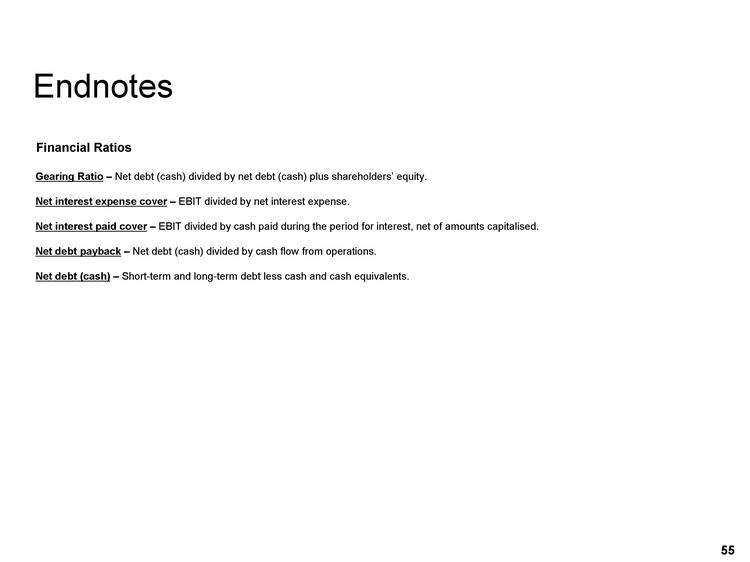
| Endnotes Financial Ratios Gearing Ratio - Net debt (cash) divided by net debt (cash) plus shareholders' equity. Net interest expense cover - EBIT divided by net interest expense. Net interest paid cover - EBIT divided by cash paid during the period for interest, net of amounts capitalised. Net debt payback - Net debt (cash) divided by cash flow from operations. Net debt (cash) - Short-term and long-term debt less cash and cash equivalents. |
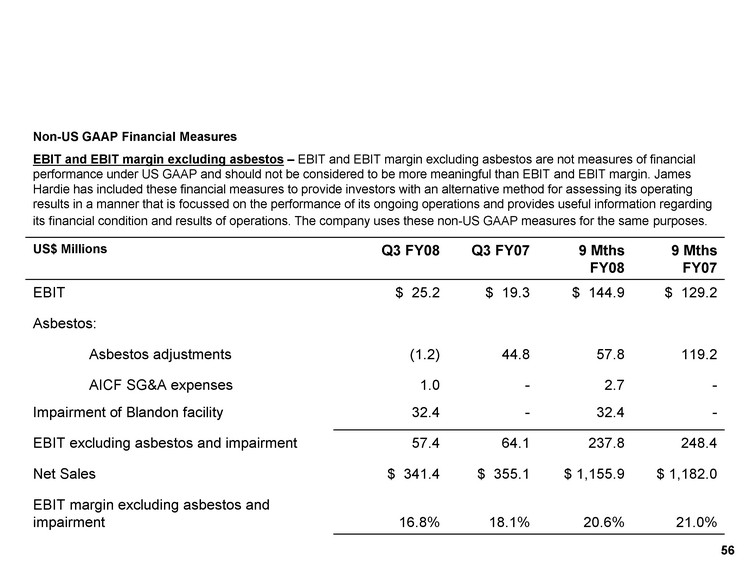
| Non-US GAAP Financial Measures EBIT and EBIT margin excluding asbestos - EBIT and EBIT margin excluding asbestos are not measures of financial performance under US GAAP and should not be considered to be more meaningful than EBIT and EBIT margin. James Hardie has included these financial measures to provide investors with an alternative method for assessing its operating results in a manner that is focussed on the performance of its ongoing operations and provides useful information regarding its financial condition and results of operations. The company uses these non-US GAAP measures for the same purposes. US$ Millions Q3 FY08 Q3 FY07 9 Mths FY08 9 Mths FY07 EBIT $ 25.2 $ 19.3 $ 144.9 $ 129.2 Asbestos: Asbestos adjustments (1.2) 44.8 57.8 119.2 AICF SG&A expenses 1.0 - 2.7 - Impairment of Blandon facility 32.4 - 32.4 - EBIT excluding asbestos and impairment 57.4 64.1 237.8 248.4 Net Sales $ 341.4 $ 355.1 $ 1,155.9 $ 1,182.0 EBIT margin excluding asbestos and impairment 16.8% 18.1% 20.6% 21.0% |
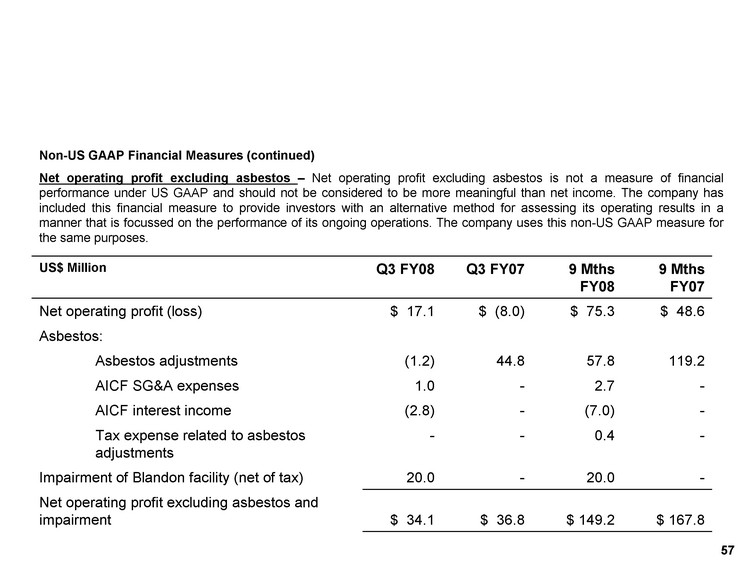
| Non-US GAAP Financial Measures (continued) Net operating profit excluding asbestos - Net operating profit excluding asbestos is not a measure of financial performance under US GAAP and should not be considered to be more meaningful than net income. The company has included this financial measure to provide investors with an alternative method for assessing its operating results in a manner that is focussed on the performance of its ongoing operations. The company uses this non-US GAAP measure for the same purposes. US$ Million Q3 FY08 Q3 FY07 9 Mths FY08 9 Mths FY07 Net operating profit (loss) $ 17.1 $ (8.0) $ 75.3 $ 48.6 Asbestos: Asbestos adjustments (1.2) 44.8 57.8 119.2 AICF SG&A expenses 1.0 - 2.7 - AICF interest income (2.8) - (7.0) - Tax expense related to asbestos adjustments - - 0.4 - Impairment of Blandon facility (net of tax) 20.0 - 20.0 - Net operating profit excluding asbestos and impairment $ 34.1 $ 36.8 $ 149.2 $ 167.8 |
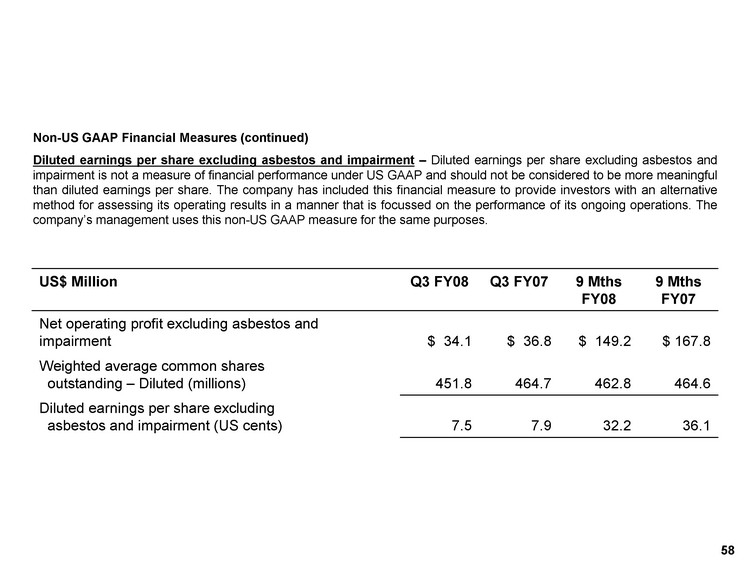
| Non-US GAAP Financial Measures (continued) Diluted earnings per share excluding asbestos and impairment - Diluted earnings per share excluding asbestos and impairment is not a measure of financial performance under US GAAP and should not be considered to be more meaningful than diluted earnings per share. The company has included this financial measure to provide investors with an alternative method for assessing its operating results in a manner that is focussed on the performance of its ongoing operations. The company's management uses this non-US GAAP measure for the same purposes. US$ Million Q3 FY08 Q3 FY07 9 Mths FY08 9 Mths FY07 Net operating profit excluding asbestos and impairment $ 34.1 $ 36.8 $ 149.2 $ 167.8 Weighted average common shares outstanding - Diluted (millions) 451.8 464.7 462.8 464.6 Diluted earnings per share excluding asbestos and impairment (US cents) 7.5 7.9 32.2 36.1 |
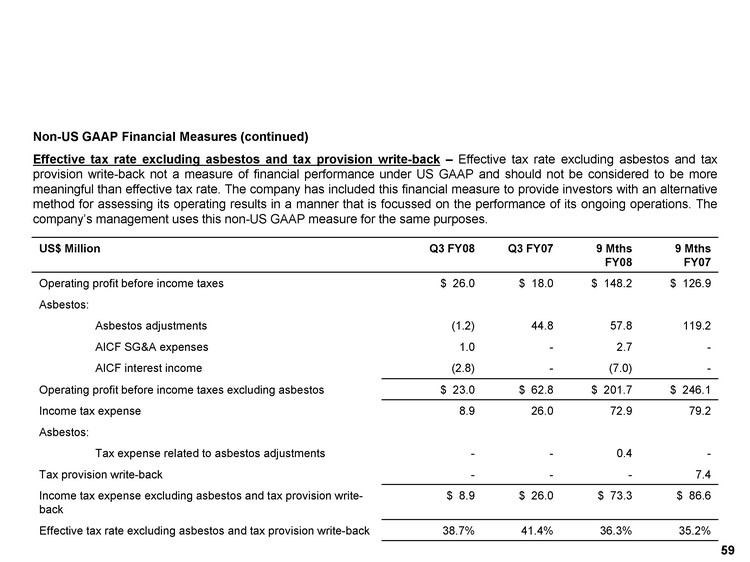
| Non-US GAAP Financial Measures (continued) Effective tax rate excluding asbestos and tax provision write-back - Effective tax rate excluding asbestos and tax provision write-back not a measure of financial performance under US GAAP and should not be considered to be more meaningful than effective tax rate. The company has included this financial measure to provide investors with an alternative method for assessing its operating results in a manner that is focussed on the performance of its ongoing operations. The company's management uses this non-US GAAP measure for the same purposes. US$ Million Q3 FY08 Q3 FY07 9 Mths FY08 9 Mths FY07 Operating profit before income taxes $ 26.0 $ 18.0 $ 148.2 $ 126.9 Asbestos: Asbestos adjustments (1.2) 44.8 57.8 119.2 AICF SG&A expenses 1.0 - 2.7 - AICF interest income (2.8) - (7.0) - Operating profit before income taxes excluding asbestos $ 23.0 $ 62.8 $ 201.7 $ 246.1 Income tax expense 8.9 26.0 72.9 79.2 Asbestos: Tax expense related to asbestos adjustments - - 0.4 - Tax provision write-back - - - 7.4 Income tax expense excluding asbestos and tax provision write-back $ 8.9 $ 26.0 $ 73.3 $ 86.6 Effective tax rate excluding asbestos and tax provision write-back 38.7% 41.4% 36.3% 35.2% |
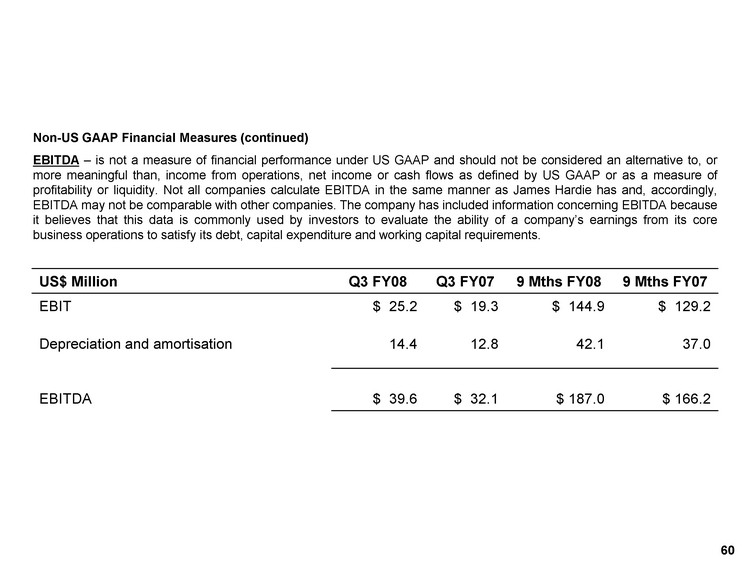
| Non-US GAAP Financial Measures (continued) EBITDA - is not a measure of financial performance under US GAAP and should not be considered an alternative to, or more meaningful than, income from operations, net income or cash flows as defined by US GAAP or as a measure of profitability or liquidity. Not all companies calculate EBITDA in the same manner as James Hardie has and, accordingly, EBITDA may not be comparable with other companies. The company has included information concerning EBITDA because it believes that this data is commonly used by investors to evaluate the ability of a company's earnings from its core business operations to satisfy its debt, capital expenditure and working capital requirements. US$ Million Q3 FY08 Q3 FY07 9 Mths FY08 9 Mths FY07 EBIT $ 25.2 $ 19.3 $ 144.9 $ 129.2 Depreciation and amortisation 14.4 12.8 42.1 37.0 EBITDA $ 39.6 $ 32.1 $ 187.0 $ 166.2 |
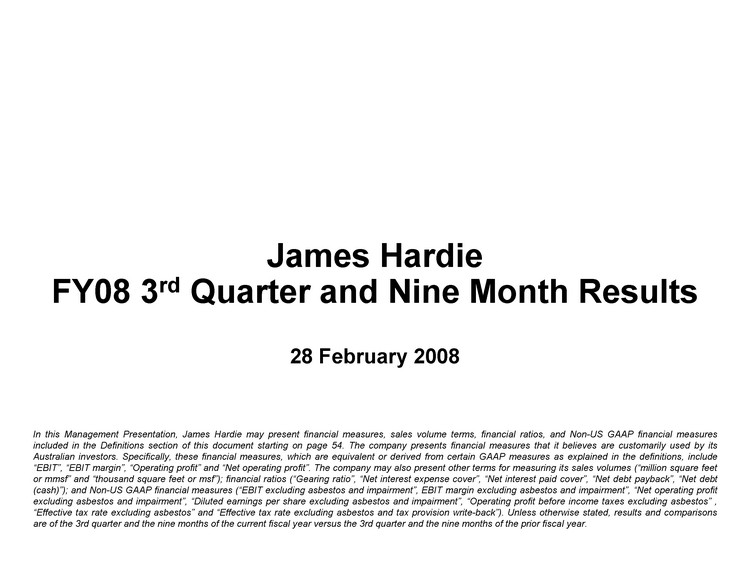
| James Hardie FY08 3rd Quarter and Nine Month Results 28 February 2008 In this Management Presentation, James Hardie may present financial measures, sales volume terms, financial ratios, and Non-US GAAP financial measures included in the Definitions section of this document starting on page 54. The company presents financial measures that it believes are customarily used by its Australian investors. Specifically, these financial measures, which are equivalent or derived from certain GAAP measures as explained in the definitions, include "EBIT", "EBIT margin", "Operating profit" and "Net operating profit". The company may also present other terms for measuring its sales volumes ("million square feet or mmsf" and "thousand square feet or msf"); financial ratios ("Gearing ratio", "Net interest expense cover", "Net interest paid cover", "Net debt payback", "Net debt (cash)"); and Non-US GAAP financial measures ("EBIT excluding asbestos and impairment", EBIT margin excluding asbestos and impairment", "Net operating profit excluding asbestos and impairment", "Diluted earnings per share excluding asbestos and impairment", "Operating profit before income taxes excluding asbestos" , "Effective tax rate excluding asbestos" and "Effective tax rate excluding asbestos and tax provision write-back"). Unless otherwise stated, results and comparisons are of the 3rd quarter and the nine months of the current fiscal year versus the 3rd quarter and the nine months of the prior fiscal year. |
| Page | ||||
Item 1. Condensed Consolidated Financial Statements (Unaudited) |
||||
Condensed Consolidated Balance Sheets as of 31 December 2007
and 31 March 2007 |
F-3 | |||
Condensed Consolidated Statements of Operations for the Three and Nine Months
Ended 31 December 2007 and 2006 |
F-4 | |||
Condensed Consolidated Statements of Cash Flows for the Nine Months
Ended 31 December 2007 and 2006 |
F-6 | |||
Condensed Consolidated Statements of Changes in Shareholders’ Equity for the
Nine Months Ended 31 December 2007 |
F-8 | |||
Notes to Condensed Consolidated Financial Statements |
F-9 | |||
Item 2. Quantitative and Qualitative Disclosures About Market Risk |
F-30 | |||
F-2
| (Millions of | (Millions of | |||||||||||||||
| US dollars) | Australian dollars) | |||||||||||||||
| 31 December | 31 March | 31 December | 31 March | |||||||||||||
| 2007 | 2007 | 2007 | 2007 | |||||||||||||
Assets |
||||||||||||||||
Current assets: |
||||||||||||||||
Cash and cash equivalents |
$ | 69.9 | $ | 34.1 | A $79.3 | A $42.3 | ||||||||||
Restricted cash and cash equivalents |
5.0 | 5.0 | 5.7 | 6.2 | ||||||||||||
Restricted cash and cash equivalents — Asbestos |
47.7 | 146.9 | 54.1 | 182.1 | ||||||||||||
Restricted short-term investments — Asbestos |
77.4 | — | 87.8 | — | ||||||||||||
Accounts and notes receivable, net of allowance for
doubtful accounts of $2.2 million (A $2.5 million) and
$1.5 million (A $1.9 million) as of 31 December 2007
and 31 March 2007, respectively |
131.8 | 163.4 | 149.5 | 202.5 | ||||||||||||
Inventories |
156.2 | 147.6 | 177.1 | 183.0 | ||||||||||||
Prepaid expenses and other current assets |
35.0 | 32.4 | 39.7 | 40.2 | ||||||||||||
Insurance receivable — Asbestos |
10.3 | 9.4 | 11.7 | 11.7 | ||||||||||||
Workers’ compensation — Asbestos |
3.0 | 2.7 | 3.4 | 3.3 | ||||||||||||
Deferred income taxes |
23.7 | 27.3 | 26.9 | 33.8 | ||||||||||||
Deferred income taxes — Asbestos |
9.1 | 7.8 | 10.3 | 9.7 | ||||||||||||
Total current assets |
569.1 | 576.6 | 645.5 | 714.8 | ||||||||||||
Property, plant and equipment, net |
799.8 | 827.7 | 907.2 | 1,025.9 | ||||||||||||
Insurance receivable — Asbestos |
167.5 | 165.1 | 189.9 | 204.6 | ||||||||||||
Workers’ compensation — Asbestos |
83.6 | 76.5 | 94.8 | 94.8 | ||||||||||||
Deferred income taxes |
3.0 | 6.9 | 3.4 | 8.6 | ||||||||||||
Deferred income taxes — Asbestos |
339.5 | 318.2 | 385.0 | 394.4 | ||||||||||||
Deposit with Australian Taxation Office |
191.8 | 154.8 | 217.5 | 191.9 | ||||||||||||
Other assets |
1.6 | 2.3 | 1.8 | 2.9 | ||||||||||||
Total assets |
$ | 2,155.9 | $ | 2,128.1 | A$2,445.1 | A$2,637.9 | ||||||||||
Liabilities and Shareholders’ Equity |
||||||||||||||||
Current liabilities: |
||||||||||||||||
Accounts payable and accrued liabilities |
$ | 114.2 | $ | 100.8 | A $129.5 | A $124.9 | ||||||||||
Short-term debt |
106.0 | 83.0 | 120.2 | 102.9 | ||||||||||||
Accrued payroll and employee benefits |
41.7 | 42.0 | 47.3 | 52.1 | ||||||||||||
Accrued product warranties |
8.5 | 5.7 | 9.6 | 7.1 | ||||||||||||
Income taxes payable |
15.7 | 10.6 | 17.8 | 13.1 | ||||||||||||
Asbestos liability |
69.4 | 63.5 | 78.7 | 78.7 | ||||||||||||
Workers’ compensation — Asbestos |
3.0 | 2.7 | 3.4 | 3.3 | ||||||||||||
Other liabilities |
9.2 | 9.3 | 10.4 | 11.5 | ||||||||||||
Total current liabilities |
367.7 | 317.6 | 416.9 | 393.6 | ||||||||||||
Long-term debt |
196.5 | 105.0 | 222.9 | 130.1 | ||||||||||||
Deferred income taxes |
107.8 | 93.8 | 122.3 | 116.3 | ||||||||||||
Accrued product warranties |
10.1 | 9.5 | 11.5 | 11.8 | ||||||||||||
Asbestos liability |
1,287.7 | 1,225.8 | 1,460.4 | 1,519.4 | ||||||||||||
Workers’ compensation — Asbestos |
83.6 | 76.5 | 94.8 | 94.8 | ||||||||||||
Other liabilities |
155.1 | 41.2 | 175.9 | 51.1 | ||||||||||||
Total liabilities |
2,208.5 | 1,869.4 | A$2,504.7 | A$2,317.1 | ||||||||||||
Commitments and contingencies (Note 7) |
||||||||||||||||
Shareholders’ equity: |
||||||||||||||||
Common stock, Euro 0.59 par value, 2.0 billion
shares authorised; 434,334,152 shares issued
at 31 December 2007 and 467,295,391 shares
issued at 31 March 2007 |
252.3 | 251.8 | ||||||||||||||
Additional paid-in capital |
187.9 | 180.2 | ||||||||||||||
Accumulated deficit |
(316.9 | ) | (178.7 | ) | ||||||||||||
Common stock in treasury, at cost, 33,529,669
shares and nil shares at 31 December 2007
and 31 March 2007, respectively |
(196.3 | ) | — | |||||||||||||
Accumulated other comprehensive income |
20.4 | 5.4 | ||||||||||||||
Total shareholders’ equity |
(52.6 | ) | 258.7 | |||||||||||||
Total liabilities and shareholders’ equity |
$ | 2,155.9 | $ | 2,128.1 | ||||||||||||
F-3
| Three Months | Nine Months | |||||||||||||||
| Ended 31 December | Ended 31 December | |||||||||||||||
| (Millions of US dollars, except per share data) | 2007 | 2006 | 2007 | 2006 | ||||||||||||
Net sales |
$ | 341.4 | $ | 355.1 | $ | 1,155.9 | $ | 1,182.0 | ||||||||
Cost of goods sold |
(224.3 | ) | (228.8 | ) | (733.1 | ) | (742.8 | ) | ||||||||
Gross profit |
117.1 | 126.3 | 422.8 | 439.2 | ||||||||||||
Selling, general and administrative expenses |
(54.3 | ) | (53.4 | ) | (167.9 | ) | (162.3 | ) | ||||||||
Research and development expenses |
(6.4 | ) | (6.2 | ) | (19.8 | ) | (20.3 | ) | ||||||||
Impairment of Blandon facility |
(32.4 | ) | — | (32.4 | ) | — | ||||||||||
SCI and other related expenses |
— | (2.6 | ) | — | (8.2 | ) | ||||||||||
Asbestos adjustments |
1.2 | (44.8 | ) | (57.8 | ) | (119.2 | ) | |||||||||
Operating income |
25.2 | 19.3 | 144.9 | 129.2 | ||||||||||||
Interest expense |
(2.9 | ) | (1.5 | ) | (6.7 | ) | (7.3 | ) | ||||||||
Interest income |
3.7 | 0.2 | 10.0 | 5.0 | ||||||||||||
Income before income taxes |
26.0 | 18.0 | 148.2 | 126.9 | ||||||||||||
Income tax expense |
(8.9 | ) | (26.0 | ) | (72.9 | ) | (79.2 | ) | ||||||||
Income (loss) before cumulative effect of
change in accounting principle |
17.1 | (8.0 | ) | 75.3 | 47.7 | |||||||||||
Cumulative effect of change in accounting principle
for stock-based compensation, net of income tax
expense of nil and $0.4 million, respectively |
— | — | — | 0.9 | ||||||||||||
Net income (loss) |
$ | 17.1 | $ | (8.0 | ) | $ | 75.3 | $ | 48.6 | |||||||
Net income (loss) per share — basic |
$ | 0.04 | $ | (0.02 | ) | $ | 0.16 | $ | 0.10 | |||||||
Net income (loss) per share — diluted |
$ | 0.04 | $ | (0.02 | ) | $ | 0.16 | $ | 0.10 | |||||||
Weighted average common shares outstanding
(Millions): |
||||||||||||||||
Basic |
451.3 | 464.7 | 461.9 | 463.8 | ||||||||||||
Diluted |
451.8 | 464.7 | 462.8 | 464.6 | ||||||||||||
F-4
| Three Months | Nine Months | |||||||||||||||
| Ended 31 December | Ended 31 December | |||||||||||||||
| (Millions of Australian dollars, except per share data) | 2007 | 2006 | 2007 | 2006 | ||||||||||||
Net sales |
A$378.6 | A$468.3 | A$1,348.6 | A$1,558.8 | ||||||||||||
Cost of goods sold |
(249.4 | ) | (301.7 | ) | (855.3 | ) | (979.6 | ) | ||||||||
Gross profit |
129.2 | 166.6 | 493.3 | 579.2 | ||||||||||||
Selling, general and administrative expenses |
(60.6 | ) | (70.4 | ) | (195.9 | ) | (214.0 | ) | ||||||||
Research and development expenses |
(7.1 | ) | (8.2 | ) | (23.1 | ) | (26.8 | ) | ||||||||
Impairment of Blandon facility |
(37.8 | ) | — | (37.8 | ) | — | ||||||||||
SCI and other related expenses |
— | (3.4 | ) | — | (10.8 | ) | ||||||||||
Asbestos adjustments |
2.9 | (59.2 | ) | (67.4 | ) | (157.2 | ) | |||||||||
Operating income |
26.6 | 25.4 | 169.1 | 170.4 | ||||||||||||
Interest expense |
(3.3 | ) | (2.0 | ) | (7.8 | ) | (9.6 | ) | ||||||||
Interest income |
4.2 | 0.3 | 11.7 | 6.6 | ||||||||||||
Income before income taxes |
27.5 | 23.7 | 173.0 | 167.4 | ||||||||||||
Income tax expense |
(8.9 | ) | (34.3 | ) | (85.1 | ) | (104.5 | ) | ||||||||
Income (loss) before cumulative effect of change
in accounting principle |
18.6 | (10.6 | ) | 87.9 | 62.9 | |||||||||||
Cumulative effect of change in accounting principle
for stock-based compensation, net of income tax
expense of nil and A$0.5 million, respectively |
— | — | — | 1.2 | ||||||||||||
Net income (loss) |
A$18.6 | A$(10.6 | ) | A$87.9 | A$64.1 | |||||||||||
Net income (loss) per share — basic |
A$0.04 | A$(0.02 | ) | A$0.19 | A$0.14 | |||||||||||
Net income (loss) per share — diluted |
A$0.04 | A$(0.02 | ) | A$0.19 | A$0.14 | |||||||||||
Weighted average common shares outstanding
(Millions): |
||||||||||||||||
Basic |
451.3 | 464.7 | 461.9 | 463.8 | ||||||||||||
Diluted |
451.8 | 464.7 | 462.8 | 464.6 | ||||||||||||
F-5
| Nine Months | ||||||||
| Ended 31 December | ||||||||
| (Millions of US dollars) | 2007 | 2006 | ||||||
Cash Flows From Operating Activities |
||||||||
Net income |
$ | 75.3 | $ | 48.6 | ||||
Adjustments to reconcile net income to net cash
provided by operating activities: |
||||||||
Depreciation and amortisation |
42.1 | 37.0 | ||||||
Deferred income taxes |
13.2 | 20.2 | ||||||
Prepaid pension cost |
0.9 | 2.3 | ||||||
Stock-based compensation |
5.0 | 2.9 | ||||||
Asbestos adjustments |
57.8 | 119.2 | ||||||
Cumulative effect of change in accounting principle |
— | (0.9 | ) | |||||
Interim payment to the Special Purpose Fund |
— | (7.1 | ) | |||||
Impairment of Blandon facility |
32.4 | — | ||||||
Other |
(3.4 | ) | 0.3 | |||||
Changes in operating assets and liabilities: |
||||||||
Restricted cash and cash equivalents |
37.0 | (5.0 | ) | |||||
Accounts and notes receivable |
37.3 | 35.6 | ||||||
Inventories |
(4.7 | ) | (25.4 | ) | ||||
Prepaid expenses and other current assets |
(1.9 | ) | (17.2 | ) | ||||
Insurance receivable |
12.8 | — | ||||||
Accounts payable and accrued liabilities |
2.6 | (23.2 | ) | |||||
Asbestos liability |
(50.6 | ) | — | |||||
Deposit with Australian Taxation Office |
(6.5 | ) | (151.7 | ) | ||||
Other accrued liabilities and other liabilities |
30.1 | 9.1 | ||||||
Net cash provided by operating activities |
279.4 | 44.7 | ||||||
Cash Flows From Investing Activities |
||||||||
Purchases of property, plant and equipment |
(28.7 | ) | (79.4 | ) | ||||
Net cash used in investing activities |
(28.7 | ) | (79.4 | ) | ||||
Cash Flows From Financing Activities |
||||||||
Proceeds from short-term borrowings |
23.0 | — | ||||||
Repayments of short-term borrowings |
— | (93.0 | ) | |||||
Proceeds from long-term borrowings |
91.5 | — | ||||||
Repayments of long-term borrowings |
— | (121.7 | ) | |||||
Proceeds from issuance of shares |
3.1 | 15.4 | ||||||
Tax benefit from stock options exercised |
0.1 | 1.6 | ||||||
Treasury stock purchased |
(196.3 | ) | — | |||||
Dividends paid |
(123.1 | ) | (18.7 | ) | ||||
Collections on loans receivable |
— | 0.1 | ||||||
Net cash used in financing activities |
(201.7 | ) | (216.3 | ) | ||||
Effects of exchange rate changes on cash |
(13.2 | ) | 1.2 | |||||
Net increase (decrease) in cash and cash equivalents |
35.8 | (249.8 | ) | |||||
Cash and cash equivalents at beginning of period |
34.1 | 315.1 | ||||||
Cash and cash equivalents at end of period |
$ | 69.9 | $ | 65.3 | ||||
Components of Cash and Cash Equivalents |
||||||||
Cash at bank and on hand |
$ | 35.5 | $ | 39.6 | ||||
Short-term deposits |
34.4 | 25.7 | ||||||
Cash and cash equivalents at end of period |
$ | 69.9 | $ | 65.3 | ||||
F-6
| Nine Months | ||||||||
| Ended 31 December | ||||||||
| (Millions of Australian dollars) | 2007 | 2006 | ||||||
Cash Flows From Operating Activities |
||||||||
Net income |
A$87.9 | A$64.1 | ||||||
Adjustments to reconcile net income to net cash
provided by operating activities: |
||||||||
Depreciation and amortisation |
49.1 | 48.8 | ||||||
Deferred income taxes |
15.4 | 26.6 | ||||||
Prepaid pension cost |
1.1 | 3.0 | ||||||
Stock-based compensation |
5.8 | 3.8 | ||||||
Asbestos adjustments |
67.4 | 157.2 | ||||||
Cumulative effect of change in accounting principle |
— | (1.2 | ) | |||||
Interim payment to the Special Purpose Fund |
— | (9.4 | ) | |||||
Impairment of Blandon facility |
37.8 | — | ||||||
Other |
(4.0 | ) | 0.4 | |||||
Changes in operating assets and liabilities: |
||||||||
Restricted cash and cash equivalents |
43.2 | (6.6 | ) | |||||
Accounts and notes receivable |
43.5 | 46.9 | ||||||
Inventories |
(5.5 | ) | (33.5 | ) | ||||
Prepaid expenses and other current assets |
(2.2 | ) | (22.7 | ) | ||||
Insurance receivable |
14.9 | — | ||||||
Accounts payable and accrued liabilities |
3.0 | (30.6 | ) | |||||
Asbestos liability |
(59.0 | ) | — | |||||
Deposit with Australian Taxation Office |
(7.6 | ) | (191.9 | ) | ||||
Other accrued liabilities and other liabilities |
35.1 | 12.0 | ||||||
Net cash provided by operating activities |
325.9 | 66.9 | ||||||
Cash Flows From Investing Activities |
||||||||
Purchases of property, plant and equipment |
(33.5 | ) | (104.7 | ) | ||||
Net cash used in investing activities |
(33.5 | ) | (104.7 | ) | ||||
Cash Flows From Financing Activities |
||||||||
Proceeds from short-term borrowings |
26.8 | — | ||||||
Repayments of short-term borrowings |
— | (122.6 | ) | |||||
Proceeds from long-term borrowings |
106.8 | — | ||||||
Repayments of long-term borrowings |
— | (160.5 | ) | |||||
Proceeds from issuance of shares |
3.6 | 20.3 | ||||||
Tax benefit from stock options exercised |
0.1 | 2.1 | ||||||
Treasury stock purchased |
(229.0 | ) | — | |||||
Dividends paid |
(143.6 | ) | (24.7 | ) | ||||
Collections on loans receivable |
— | 0.1 | ||||||
Net cash used in financing activities |
(235.3 | ) | (285.3 | ) | ||||
Effects of exchange rate changes on cash |
(20.1 | ) | (34.7 | ) | ||||
Net increase (decrease) in cash and cash equivalents |
37.0 | (357.8 | ) | |||||
Cash and cash equivalents at beginning of period |
42.3 | 440.4 | ||||||
Cash and cash equivalents at end of period |
A$79.3 | A$82.6 | ||||||
Components of Cash and Cash Equivalents |
||||||||
Cash at bank and on hand |
A$40.3 | A$50.1 | ||||||
Short-term deposits |
39.0 | 32.5 | ||||||
Cash and cash equivalents at end of period |
A$79.3 | A$82.6 | ||||||
F-7
| Accumulated | ||||||||||||||||||||||||
| Additional | Other | |||||||||||||||||||||||
| Common | Paid-in | Accumulated | Comprehensive | Treasury | ||||||||||||||||||||
| (Millions of US dollars) | Stock | Capital | Deficit | Income | Stock | Total | ||||||||||||||||||
Balances as of 31 March 2007 |
$ | 251.8 | $ | 180.2 | $ | (178.7 | ) | $ | 5.4 | $ | — | $ | 258.7 | |||||||||||
Comprehensive income (loss): |
||||||||||||||||||||||||
Net income |
— | — | 75.3 | — | — | 75.3 | ||||||||||||||||||
Pension and post-retirement benefit adjustments |
— | — | — | (0.2 | ) | — | (0.2 | ) | ||||||||||||||||
Unrealised loss on investments |
— | — | — | (1.7 | ) | — | (1.7 | ) | ||||||||||||||||
Foreign currency translation gain |
— | — | — | 16.9 | — | 16.9 | ||||||||||||||||||
Other comprehensive income |
— | — | — | 15.0 | — | 15.0 | ||||||||||||||||||
Total comprehensive income |
90.3 | |||||||||||||||||||||||
Adoption of FIN 48 |
— | — | (90.4 | ) | — | — | (90.4 | ) | ||||||||||||||||
Stock-based compensation |
— | 5.0 | — | — | — | 5.0 | ||||||||||||||||||
Tax benefit from stock options exercised |
— | 0.1 | — | — | — | 0.1 | ||||||||||||||||||
Stock options exercised |
0.5 | 2.6 | — | — | — | 3.1 | ||||||||||||||||||
Dividends paid |
— | — | (123.1 | ) | — | — | (123.1 | ) | ||||||||||||||||
Treasury stock purchased |
— | — | — | — | (196.3 | ) | (196.3 | ) | ||||||||||||||||
Balances as of 31 December 2007 |
$ | 252.3 | $ | 187.9 | $ | (316.9 | ) | $ | 20.4 | $ | (196.3 | ) | $ | (52.6 | ) | |||||||||
F-8
| 1. | Basis of Presentation | |
| Nature of Operations The Company manufactures and sells fibre cement building products for interior and exterior building construction applications primarily in the United States, Australia, New Zealand, Philippines and Europe. |
||
| Basis of Presentation The condensed consolidated financial statements represent the financial position, results of operations and cash flows of James Hardie Industries N.V. (“JHI NV”) and its current wholly owned subsidiaries and special interest entities, collectively referred to as either the “Company” or “James Hardie” and JHI NV together with its subsidiaries as of the time relevant to the applicable reference, the “James Hardie Group,” unless the context indicates otherwise. These interim condensed consolidated financial statements should be read in conjunction with the audited consolidated financial statements and the notes thereto, included in the Company’s Annual Report on Form 20-F for the fiscal year ended 31 March 2007. |
||
| The condensed consolidated financial statements included herein are unaudited; however, they contain all normal recurring adjustments which, in the opinion of the Company’s management, are necessary to state fairly the consolidated financial position of the Company at 31 December 2007, the consolidated results of operations for the three and nine months ended 31 December 2007 and 2006 and the consolidated cash flows for the nine months ended 31 December 2007 and 2006. Income from continuing operations for the three and nine months ended 31 December 2007 includes a charge of US$2.7 million relating to prior period lease costs. The impact of this adjustment on prior periods’ financial statements is not material. The results of operations for the three and nine months ended 31 December 2007 are not necessarily indicative of the results to be expected for the full year. The balance sheet at 31 March 2007 has been derived from the audited financial statements at that date but does not include all of the information and footnotes required by generally accepted accounting principles for complete financial statements. | ||
| The assets, liabilities, statements of operations and statements of cash flows of the Company have been presented with accompanying Australian dollar (A$) convenience translations as the majority of the Company’s shareholder base is Australian. These A$ convenience translations are not prepared in accordance with accounting principles generally accepted in the United States of America. The exchange rates used to calculate the convenience translations are as follows: |
| 31 March | 31 December | |||||||||||
| (US$1 = A$) | 2007 | 2007 | 2006 | |||||||||
Assets and liabilities |
1.2395 | 1.1341 | 1.2648 | |||||||||
Statements of operations |
n/a | 1.1667 | 1.3188 | |||||||||
Cash flows — beginning cash |
n/a | 1.2395 | 1.3975 | |||||||||
Cash flows — ending cash |
n/a | 1.1341 | 1.2648 | |||||||||
Cash flows — current period movements |
n/a | 1.1667 | 1.3188 | |||||||||
F-9
| 2. | Summary of Significant Accounting Policies | |
| Earnings Per Share The Company is required to disclose basic and diluted earnings per share (“EPS”). Basic EPS is calculated using income divided by the weighted average number of common shares outstanding during the period. Diluted EPS is similar to basic EPS except that the weighted average number of common shares outstanding is increased to include the number of additional common shares calculated using the treasury method that would have been outstanding if dilutive potential common shares, such as options, had been exercised. Accordingly, basic and dilutive common shares outstanding used in determining net income per share are as follows: |
| Three Months | Nine Months | |||||||||||||||
| Ended 31 December | Ended 31 December | |||||||||||||||
| (Millions of shares) | 2007 | 2006 | 2007 | 2006 | ||||||||||||
Basic common shares outstanding |
451.3 | 464.7 | 461.9 | 463.8 | ||||||||||||
Dilutive effect of stock options |
0.5 | — | 0.9 | 0.8 | ||||||||||||
Diluted common shares outstanding |
451.8 | 464.7 | 462.8 | 464.6 | ||||||||||||
| (US dollars) | 2007 | 2006 | 2007 | 2006 | ||||||||||||
Net income (loss) per share — basic |
$ | 0.04 | $ | (0.02 | ) | $ | 0.16 | $ | 0.10 | |||||||
Net income (loss) per share — diluted |
$ | 0.04 | $ | (0.02 | ) | $ | 0.16 | $ | 0.10 | |||||||
| Potential common shares of 13.0 million and 8.1 million for the three months ended 31 December 2007 and 2006, respectively, and 10.4 million and 7.0 million for the nine months ended 31 December 2007 and 2006, respectively, have been excluded from the calculations of diluted common shares outstanding because the effect of their inclusion would be anti-dilutive. | ||
| Advertising The Company expenses the production costs of advertising the first time the advertising takes place. Advertising expense was US$4.1 million and US$4.2 million for the three months ended 31 December 2007 and 2006, respectively, and US$10.0 million and US$13.1 million for the nine months ended 31 December 2007 and 2006, respectively. |
||
| Stock-Based Compensation The Company recognised stock-based compensation expense (included in selling, general and administrative expenses) of US$1.9 million and US$1.4 million for the three months ended 31 December 2007 and 2006, respectively, and US$5.0 million and US$4.1 million for the nine months ended 31 December 2007 and 2006, respectively. Upon adoption of Statement of Financial Accounting Standards (“SFAS”) No. 123R, “Accounting for Stock-Based Compensation”, at the beginning of fiscal year 2007, the Company analysed forfeiture rates on all of its 2001 Stock Option Plan grants for which vesting was complete, resulting in an estimated weighted average forfeiture rate of 30.7%. Based on this estimated rate, a cumulative adjustment to stock-based compensation expense of US$1.3 million net of an income tax benefit of US$0.4 million was recorded effective 1 April 2006. The adjustment is presented on the consolidated statements of operations as a cumulative effect of change in accounting principle (net of income tax). The portion of the cumulative adjustment that relates to USA-based employees caused a reduction in the deferred tax asset previously recorded. For the nine months ended 31 December 2006, the amount of the cumulative adjustment related to USA-based employees was US$1.0 million for which the related USA income tax adjustment was US$0.4 million. |
F-10
| Impairment of Long-Lived Assets In accordance with Statement of Financial Accounting Standards (“SFAS”) No. 144, “Accounting for the Impairment or Disposal of Long-Lived Assets,” long-lived assets, such as property, plant and equipment, and purchased intangibles subject to amortisation are reviewed for impairment whenever events or changes in circumstances indicate that the carrying amount of an asset may not be recoverable. Recoverability of assets to be held and used is measured by a comparison of the carrying amount of an asset to estimated undiscounted future cash flows expected to be generated by the asset. If the carrying amount of the asset exceeds its estimated future cash flows, an impairment charge is recognised by the amount by which the carrying amount of the asset exceeds the fair value of the assets. |
||
| Repurchased Common Stock The Company accounts for repurchased common stock under the cost method and includes such treasury stock as a component of shareholders’ equity. Retirement of treasury stock is recorded as a reduction of common stock, additional paid-in capital and retained earnings, as applicable. |
||
| Asbestos Prior to 31 March 2007, the Company’s consolidated financial statements included an asbestos provision relating to its anticipated future payments to a Special Purpose Fund (“SPF”) based on the terms of the Original Final Funding Agreement (“Original FFA”) entered into on 1 December 2005. |
||
| In February 2007, the shareholders approved the Amended & Restated Final Funding Agreement (“Amended FFA”) entered into on 21 November 2006 to provide long-term funding to the Asbestos Injuries Compensation Fund (“AICF”), a special purpose fund that provides compensation for Australian-related personal injury claims against certain former subsidiary companies of James Hardie in Australia (being Amaca Pty Ltd (“Amaca”), Amaba Pty Ltd (“Amaba”) and ABN 60 Pty Ltd (“ABN 60”) (collectively, the “Liable Entities”)). | ||
| Amaca and Amaba separated from the James Hardie Group in February 2001. ABN 60 separated from the James Hardie Group in March 2003. Upon shareholder approval of the Amended FFA in February 2007, shares in the Liable Entities were transferred to the AICF. The Company appoints three of the AICF directors and the NSW state government appoints two of the AICF directors. The AICF manages Australian asbestos-related personal injury claims made against the Liable Entities, and makes compensation payments in respect of those proven claims. | ||
| AICF Under the terms of the Amended FFA, James Hardie 117 Pty Ltd (the “Performing Subsidiary”) has a contractual liability to make payments to the AICF. This funding to the AICF results in the Company having a pecuniary interest in the AICF. The interest is considered variable because the potential impact on the Company will vary based upon the annual actuarial assessments obtained by the Company with respect to asbestos-related personal injury claims against the Liable Entities. Due to the Company’s variable interest in the AICF, it consolidates the AICF in accordance with Financial Accounting Standards Board (“FASB”) Interpretation No. 46R, “Consolidation of Variable Interest Entities”. |
||
| The AICF has operating costs that are claims related and non-claims related. Claims related costs incurred by the AICF are treated as reductions to the accrued asbestos liability balances previously reflected in the consolidated balance sheets. Non-claims related operating costs incurred by the AICF are expensed as incurred in the line item Selling, general and administrative expenses in the consolidated statements of operations. The AICF earns interest on its cash and cash equivalents and on its short-term investments; these amounts are included in the line item Interest income in the consolidated statements of operations. |
F-11
| Asbestos-Related Assets and Liabilities The Company has recorded on its consolidated balance sheets certain assets and liabilities under the terms of the Amended FFA. These items are Australian dollar-denominated and are subject to translation into US dollars at each reporting date. These assets and liabilities are commonly referred to by the Company as Asbestos-Related Assets and Liabilities and include: |
||
| Asbestos Liability The amount of the asbestos liability reflects the terms of the Amended FFA and has been calculated by reference to (but is not exclusively based upon) the most recent actuarial estimate of projected future cash flows prepared by KPMG Actuaries Pty Ltd (“KPMG Actuaries”). The asbestos liability includes these cash flows as undiscounted and uninflated on the basis that it is inappropriate to discount or inflate future cash flows when the timing and amounts of such cash flows are not fixed or readily determinable. The asbestos liability also includes an allowance for the future claims-handling costs of the AICF. |
||
| Adjustments in the asbestos liability due to changes in the actuarial estimate of projected future cash flows and changes in the estimate of future operating costs of the AICF are reflected in the consolidated statements of operations during the period in which they occur. Claims paid by the AICF and claims-handling costs incurred by the AICF are treated as reductions in the accrued balances previously reflected in the consolidated balance sheets. | ||
| Insurance Receivable There are various insurance policies and insurance companies with exposure to the asbestos claims. The insurance receivable determined by KPMG Actuaries reflects the recoveries expected from all such policies based on the expected pattern of claims against such policies less an allowance for credit risk based on credit agency ratings. The insurance receivable generally includes these cash flows as undiscounted and uninflated on the basis that it is inappropriate to discount or inflate future cash flows when the timing and amounts of such cash flows are not fixed or readily determinable. The Company only records insurance receivables that it deems to be probable. |
||
| Included in insurance receivable is US$14.3 million recorded on a discounted basis because the timing of the recoveries has been agreed with the insurer. | ||
| Adjustments in insurance receivable due to changes in the actuarial estimate, or changes in the Company’s assessment of recoverability, are reflected in the consolidated statements of operations during the period in which they occur. Insurance recoveries are treated as a reduction in the insurance receivable balance. | ||
| Workers’ Compensation Workers’ compensation claims are claims made by former employees of the Liable Entities. Such past, current and future reported claims were insured with various insurance companies and the various Australian State-based workers’ compensation schemes (collectively “workers’ compensation schemes or policies”). An estimate of the liability related to workers’ compensation claims is prepared by KPMG Actuaries as part of the annual actuarial assessment. This estimate contains two components, amounts that will be met by a workers’ compensation scheme or policy, and amounts that will be met by the Liable Entities. |
||
| The portion of the KPMG Actuaries estimate that is expected to be met by the Liable Entities is included as part of the Asbestos Liability. Adjustments to this estimate are reflected in the consolidated statements of operations during the period in which they occur. |
F-12
| The portion of the KPMG Actuaries estimate that is expected to be met by the workers’ compensation schemes or policies of the Liable Entities is recorded by the Company as a workers’ compensation liability. Since these amounts are expected to be met by the workers’ compensation schemes or policies, the Company records an equivalent workers’ compensation receivable. Adjustments to the workers’ compensation liability result in an equal adjustment in the workers’ compensation receivable recorded by the Company and have no effect on the consolidated statements of operations. | ||
| Asbestos-Related Research and Education Contributions The Company has agreed to fund asbestos-related research and education initiatives for a period of 10 years, beginning in fiscal year 2007. The liabilities related to these agreements are included in “Other Liabilities” on the consolidated balance sheets. |
||
| Restricted Cash Assets of the AICF Cash and cash equivalents of the AICF are reflected as restricted assets, as the use of these assets is restricted to the settlement of asbestos claims and payment of the operating costs of the AICF. |
||
| Restricted Short-Term Investments Short-term investments consist of highly liquid investments held in the custody of major financial institutions. All short-term investments are classified as available for sale and are recorded at market value using the specific identification method. Unrealised gains and losses on these investments are included as a separate component of accumulated other comprehensive income, net of tax. |
||
| AICF — Other Assets and Liabilities Other assets and liabilities of the AICF, including fixed assets, trade receivables and payables are included on the consolidated balance sheets under the appropriate captions and their use is restricted to the operations of the AICF. |
||
| Deferred Income Taxes The Performing Subsidiary is able to claim a taxation deduction for its contributions to the AICF over a five-year period from the date of contribution. Consequently, a deferred tax asset has been recognised equivalent to the anticipated tax benefit over the life of the Amended FFA. |
||
| Adjustments are made to the deferred income tax asset as adjustments to the asbestos-related assets and liabilities are recorded. | ||
| Foreign Currency Translation The asbestos-related assets and liabilities are denominated in Australian dollars and thus the reported value of these asbestos-related assets and liabilities in the Company’s consolidated balance sheets in US dollars are subject to adjustment depending on the closing exchange rate between the two currencies at the balance sheet date. The effect of foreign exchange rate movements between these currencies is included in Asbestos Adjustments in the consolidated statements of operations. |
F-13
| Recent Accounting Pronouncements | ||
| Fair Value Measurements In September 2006, the FASB issued Statement No. 157, “Fair Value Measurements” (“SFAS No. 157”), which defines fair value, establishes a framework for measuring fair value in generally accepted accounting principles (“GAAP”) and expands disclosures about fair value measurements. The expanded disclosures in this statement about the use of fair value to measure assets and liabilities should provide users of financial statements with better information about the extent to which fair value is used to measure recognised assets and liabilities, the inputs used to develop the measurements, and the effect of certain measurements on earnings (or changes in net assets) for the period. Certain provisions of SFAS No. 157 are effective for the Company on 1 April 2008, and it is currently evaluating the impact on its financial statements of adopting SFAS No. 157. |
||
| Fair Value Option for Financial Assets and Financial Liabilities In February 2007, the FASB issued Statement No. 159, “The Fair Value Option for Financial Assets and Financial Liabilities” (“SFAS No. 159”), which allows for voluntary measurement of financial assets and liabilities as well as certain other items at fair value. Unrealised gains and losses on financial instruments for which the fair value option has been elected are reported in earnings. The provisions of SFAS No. 159 are effective for the Company on 1 April 2008, and it is currently evaluating the impact on its financial statements of adopting SFAS No. 159. |
||
| Business Combinations In December 2007, the FASB issued SFAS No. 141 (revised 2007), “Business Combinations (“SFAS No. 141R”)”, which replaces SFAS No. 141. The statement establishes principles and requirements for how the acquirer in a business combination recognises and measures in its financial statements the identifiable assets acquired, the liabilities assumed, and any controlling interest; recognises and measures the goodwill acquired in the business combination or a gain from a bargain purchase; and determines what information to disclose to enable users of the financial statements to evaluate the nature and financial effects of the business combination. The provisions of SFAS No. 141R are effective for the Company on 1 April 2008, and it is currently evaluating the impact on its financial statement of adopting SFAS No. 141R. |
||
| Noncontrolling Interests in Consolidated Financial
Statements — an amendment to ARB No. 51 In December 2007, the FASB approved the issuance of SFAS No. 160 “Noncontrolling Interests in Consolidated Financial Statements — an amendment to ARB No. 51” (“SFAS No. 160”). SFAS No. 160 establishes accounting and reporting standards that require the ownership interest in subsidiaries held by parties other than the parent be clearly identified and presented in the Consolidated Balance Sheets within equity, but separate from the parent’s equity; the amount of consolidated net income attributable to the parent and the noncontrolling interest be clearly identified and presented on the face of the Consolidated Statement of Earnings; and changes in a parent’s ownership interest while the parent retains its controlling financial interest in its subsidiary be accounted for consistently. The provisions of SFAS No. 160 are effective for the Company on 1 April 2008, and it is currently evaluating the impact on its financial statement of adopting SFAS No. 160. |
F-14
| 3. | Inventories | |
| Inventories consist of the following components: |
| 31 December | 31 March | |||||||
| (Millions of US dollars) | 2007 | 2007 | ||||||
Finished goods |
$ | 101.5 | $ | 101.5 | ||||
Work-in-process |
8.5 | 12.3 | ||||||
Raw materials and supplies |
52.6 | 37.8 | ||||||
Provision for obsolete finished goods and raw materials |
(6.4 | ) | (4.0 | ) | ||||
Total inventories |
$ | 156.2 | $ | 147.6 | ||||
| 4. | Operating Segment Information and Concentrations of Risk | |
| The Company has reported its operating segment information in the format that the operating segment information is available to, and evaluated by, the Board of Directors. USA Fibre Cement manufactures and sells fibre cement interior linings, exterior siding and related accessories products in the United States. Asia Pacific Fibre Cement includes all fibre cement manufactured in Australia, New Zealand and the Philippines and sold in Australia, New Zealand and Asia. Research and Development represents the cost incurred by the research and development centres. Other includes the manufacture and sale of fibre cement reinforced pipes in the United States, fibre cement operations in Europe and roofing operations in the United States. The roofing plant was closed and the business ceased operations in April 2006. The Company’s operating segments are strategic operating units that are managed separately due to their different products and/or geographical location. | ||
| The following are the Company’s operating segments and geographical information: | ||
| Operating Segments |
| Net Sales to Customers | Net Sales to Customers | |||||||||||||||
| Three Months | Nine Months | |||||||||||||||
| Ended 31 December | Ended 31 December | |||||||||||||||
| (Millions of US dollars) | 2007 | 2006 | 2007 | 2006 | ||||||||||||
USA Fibre Cement |
$ | 258.2 | $ | 284.5 | $ | 912.3 | $ | 972.4 | ||||||||
Asia Pacific Fibre Cement |
77.5 | 64.4 | 224.8 | 187.4 | ||||||||||||
Other |
5.7 | 6.2 | 18.8 | 22.2 | ||||||||||||
Worldwide total |
$ | 341.4 | $ | 355.1 | $ | 1,155.9 | $ | 1,182.0 | ||||||||
F-15
| Income | Income | |||||||||||||||
| Before Income Taxes | Before Income Taxes | |||||||||||||||
| Three Months | Nine Months | |||||||||||||||
| Ended 31 December | Ended 31 December | |||||||||||||||
| (Millions of US dollars) | 2007 | 2006 | 2007 | 2006 | ||||||||||||
USA Fibre Cement1 |
$ | 32.2 | $ | 76.7 | $ | 230.9 | $ | 277.8 | ||||||||
Asia Pacific Fibre Cement |
14.8 | 8.8 | 39.6 | 30.6 | ||||||||||||
Research and Development |
(4.2 | ) | (4.9 | ) | (13.1 | ) | (13.6 | ) | ||||||||
Other |
(1.3 | ) | (2.4 | ) | (4.5 | ) | (6.6 | ) | ||||||||
Segments total |
41.5 | 78.2 | 252.9 | 288.2 | ||||||||||||
General Corporate2 |
(16.3 | ) | (58.9 | ) | (108.0 | ) | (159.0 | ) | ||||||||
Total operating income |
25.2 | 19.3 | 144.9 | 129.2 | ||||||||||||
Net interest income (expense)3 |
0.8 | (1.3 | ) | 3.3 | (2.3 | ) | ||||||||||
Worldwide total |
$ | 26.0 | $ | 18.0 | $ | 148.2 | $ | 126.9 | ||||||||
| Total Identifiable Assets | ||||||||
| 31 December | 31 March | |||||||
| (Millions of US dollars) | 2007 | 2007 | ||||||
USA Fibre Cement |
$ | 842.3 | $ | 893.0 | ||||
Asia Pacific Fibre Cement |
216.7 | 199.3 | ||||||
Other |
57.5 | 52.5 | ||||||
Segments total |
1,116.5 | 1,144.8 | ||||||
General Corporate4 |
1,039.4 | 983.3 | ||||||
Worldwide total |
$ | 2,155.9 | $ | 2,128.1 | ||||
| Geographic Areas | Net Sales to Customers | Net Sales to Customers | ||||||||||||||
| Three Months | Nine Months | |||||||||||||||
| Ended 31 December | Ended 31 December | |||||||||||||||
| (Millions of US dollars) | 2007 | 2006 | 2007 | 2006 | ||||||||||||
USA |
$ | 259.9 | $ | 287.8 | $ | 919.0 | $ | 986.0 | ||||||||
Australia |
52.0 | 42.4 | 150.1 | 126.7 | ||||||||||||
New Zealand |
17.7 | 14.4 | 51.3 | 40.3 | ||||||||||||
Other Countries |
11.8 | 10.5 | 35.5 | 29.0 | ||||||||||||
Worldwide total |
$ | 341.4 | $ | 355.1 | $ | 1,155.9 | $ | 1,182.0 | ||||||||
F-16
| Total Identifiable Assets | ||||||||
| 31 December | 31 March | |||||||
| (Millions of US dollars) | 2007 | 2007 | ||||||
USA |
$ | 885.3 | $ | 935.7 | ||||
Australia |
135.0 | 127.1 | ||||||
New Zealand |
27.5 | 23.1 | ||||||
Other Countries |
68.7 | 58.9 | ||||||
Segments total |
1,116.5 | 1,144.8 | ||||||
General Corporate4 |
1,039.4 | 983.3 | ||||||
Worldwide total |
$ | 2,155.9 | $ | 2,128.1 | ||||
| 1 | Included in USA Fibre Cement for the three and nine months ended 31 December 2007 is the impairment charge of the Blandon facility of US$32.4 million and the related closure costs totalling US$1.7 million. | |
| 2 | Included in General Corporate for the three months ended 31 December 2007 are favourable asbestos adjustments of US$1.2 million and AICF SG&A expenses of US$1.0 million. Included in General Corporate for the three months ended 31 December 2006 are unfavourable asbestos adjustments of US$44.8 million. Included in General Corporate for the nine months ended 31 December 2007 are unfavourable asbestos adjustments of US$57.8 million and AICF SG&A expenses of US$2.7 million. Included in General Corporate for the nine months ended 31 December 2006 are unfavourable asbestos adjustments of US$119.2 million. See Note 6. | |
| 3 | Included in Net Interest Income for the three and nine months ended 31 December 2007 is AICF interest income of US$2.8 million and US$7.0 million, respectively. See Note 6. | |
| 4 | Asbestos-related assets at 31 December 2007 and 31 March 2007 are US$739.0 million and US$727.6 million, respectively, and are included in the General Corporate segment. See Note 6. |
| 5. | Accumulated Other Comprehensive Income | |
| Accumulated other comprehensive income consists of the following components: |
| 31 December | 31 March | |||||||
| (Millions of US dollars) | 2007 | 2007 | ||||||
Pension and post-retirement benefit adjustments
(net of US$1.2 million and US$1.2 million tax benefit, respectively) |
$ | (2.9 | ) | $ | (2.7 | ) | ||
Unrealised loss on restricted short-term investments |
(1.7 | ) | — | |||||
Foreign currency translation adjustments |
25.0 | 8.1 | ||||||
Total accumulated other comprehensive income |
$ | 20.4 | $ | 5.4 | ||||
| 6. | Asbestos | |
| The Amended FFA to provide long-term funding to the AICF was approved by shareholders in February 2007. The accounting policies utilised by the Company to account for the Amended FFA are described in Note 2, Summary of Significant Accounting Policies. |
F-17
| Asbestos Adjustments | ||
| The asbestos adjustments included in the condensed consolidated statements of operations comprise the following: |
| Three Months | Nine Months | |||||||||||||||
| Ended 31 December | Ended 31 December | |||||||||||||||
| (Millions of US dollars ) | 2007 | 2006 | 2007 | 2006 | ||||||||||||
Effect of foreign exchange |
$ | 1.2 | $ | (44.8 | ) | $ | (59.0 | ) | $ | (77.4 | ) | |||||
Other adjustments |
— | — | 1.2 | (41.8 | ) | |||||||||||
Total Asbestos Adjustments |
$ | 1.2 | $ | (44.8 | ) | $ | (57.8 | ) | $ | (119.2 | ) | |||||
| Asbestos-Related Assets and Liabilities | ||
| Under the terms of the Amended FFA, the Company has included on its consolidated balance sheets certain asbestos-related assets and liabilities. These amounts are detailed in the table below, and the net total of these asbestos-related assets and liabilities is commonly referred to by the Company as the “Net Amended FFA Liability”. |
| 31 December | 31 March | |||||||
| (Millions of US dollars) | 2007 | 2007 | ||||||
Asbestos liability — current |
$ | (69.4 | ) | $ | (63.5 | ) | ||
Asbestos liability — non-current |
(1,287.7 | ) | (1,225.8 | ) | ||||
Asbestos liability — Total |
(1,357.1 | ) | (1,289.3 | ) | ||||
Insurance receivable — current |
10.3 | 9.4 | ||||||
Insurance receivable — non-current |
167.5 | 165.1 | ||||||
Insurance receivable — Total |
177.8 | 174.5 | ||||||
Workers’ compensation asset — current |
3.0 | 2.7 | ||||||
Workers’ compensation asset — non-current |
83.6 | 76.5 | ||||||
Workers’ compensation liability — current |
(3.0 | ) | (2.7 | ) | ||||
Workers’ compensation liability — non-current |
(83.6 | ) | (76.5 | ) | ||||
Workers’ compensation — Total |
— | — | ||||||
Deferred income taxes — current |
9.1 | 7.8 | ||||||
Deferred income taxes — non-current |
339.5 | 318.2 | ||||||
Deferred income taxes — Total |
348.6 | 326.0 | ||||||
Income tax payable (reduction in income tax payable) |
17.1 | 9.0 | ||||||
Other net liabilities |
(4.1 | ) | (6.3 | ) | ||||
Net Amended FFA liability |
(817.7 | ) | (786.1 | ) | ||||
Restricted cash and short-term investment assets of the AICF |
125.1 | 146.9 | ||||||
Unfunded Net Amended FFA liability |
$ | (692.6 | ) | $ | (639.2 | ) | ||
F-18
| Asbestos Liability The amount of the asbestos liability reflects the terms of the Amended FFA, which has been calculated by reference to (but is not exclusively based upon) the most recent actuarial estimate of the projected future asbestos-related cash flows prepared by KPMG Actuaries. The asbestos liability also includes an allowance for the future claims-handling costs of the AICF. The Company will receive an updated actuarial estimate as of 31 March each year. The last actuarial assessment was performed as of 31 March 2007. |
||
| The changes in the asbestos liability for the nine months ended 31 December 2007 are detailed in the table below: |
| A$ | A$ to US$ | US$ | ||||||||||
| Millions | rate | Millions | ||||||||||
Asbestos liability — 31 March 2007 |
A$ | (1,598.1 | ) | 1.2395 | $ | (1,289.3 | ) | |||||
Asbestos claims paid1 |
56.9 | 1.1667 | 48.8 | |||||||||
AICF claims-handling costs incurred1 |
2.1 | 1.1667 | 1.8 | |||||||||
Effect of foreign exchange |
(118.4 | ) | ||||||||||
Asbestos liability — 31 December 2007 |
A$ | (1,539.1 | ) | 1.1341 | $ | (1,357.1 | ) | |||||
| Insurance Receivable — Asbestos The changes in the insurance receivable for the nine months ended 31 December 2007 are detailed in the table below: |
| A$ | A$ to US$ | US$ | ||||||||||
| Millions | rate | Millions | ||||||||||
Insurance receivable — 31 March 2007 |
A$ | 216.3 | 1.2395 | $ | 174.5 | |||||||
Insurance recoveries1 |
(14.9 | ) | 1.1667 | (12.8 | ) | |||||||
Change in estimate2 |
0.2 | 1.1782 | 0.2 | |||||||||
Effect of foreign exchange |
15.9 | |||||||||||
Insurance receivable — 31 December 2007 |
A$ | 201.6 | 1.1341 | $ | 177.8 | |||||||
| Deferred Income Taxes — Asbestos The changes in the deferred income taxes — asbestos for the nine months ended 31 December 2007 are detailed in the table below: |
| A$ | A$ to US$ | US$ | ||||||||||
| Millions | rate | Millions | ||||||||||
Deferred income taxes — 31 March 2007 |
A$ | 404.1 | 1.2395 | $ | 326.0 | |||||||
Amounts offset against income tax payable1 |
(8.3 | ) | 1.1667 | (7.1 | ) | |||||||
Impact of asbestos adjustments1 |
(0.5 | ) | 1.1667 | (0.4 | ) | |||||||
Effect of foreign exchange |
30.1 | |||||||||||
Deferred income taxes — 31 December 2007 |
A$ | 395.3 | 1.1341 | $ | 348.6 | |||||||
F-19
| Other Net Liabilities Other net liabilities include a provision for asbestos-related education and medical research contributions of US$3.4 million at 31 December 2007. Also included in other net liabilities are the other assets and liabilities of the AICF at 31 December 2007, which include US$0.5 million of trade receivables and prepayments, US$0.4 million of fixed assets, and US$1.6 million of trade payables and accruals. |
||
| Restricted Cash and Short-term Investment Assets of the AICF Cash and cash equivalents and short-term investments of the AICF are reflected as restricted assets as these assets are restricted for use in the settlement of asbestos claims and payment of the operating costs of the AICF. During the three and nine months ended 31 December 2007 no short-term investments were purchased or sold. |
||
| The changes in the restricted cash and short-term investment assets of the AICF for the nine months ended 31 December 2007 are detailed in the table below: |
| A$ | A$ to US$ | US$ | ||||||||||
| Millions | rate | Millions | ||||||||||
Restricted cash and short-term investment
assets — 31 March 2007 |
A$ | 182.1 | 1.2395 | $ | 146.9 | |||||||
Asbestos claims paid1 |
(56.9 | ) | 1.1667 | (48.8 | ) | |||||||
AICF operating costs paid — claims-handling1 |
(2.1 | ) | 1.1667 | (1.8 | ) | |||||||
AICF operating costs paid — non claims-handling1 |
(3.2 | ) | 1.1667 | (2.7 | ) | |||||||
Insurance recoveries1 |
14.9 | 1.1667 | 12.8 | |||||||||
Interest and investment income1 |
8.2 | 1.1667 | 7.0 | |||||||||
Unrealised loss on investments1 |
(2.0 | ) | 1.1667 | (1.7 | ) | |||||||
Other1 |
0.9 | 1.1667 | 0.8 | |||||||||
Effect of foreign exchange |
12.6 | |||||||||||
Restricted cash and short-term investment
assets — 31 December 2007 |
A$ | 141.9 | 1.1341 | $ | 125.1 | |||||||
| 1 | The average exchange rate for the period is used to convert the Australian dollar amount to US dollars based on the assumption that these transactions occurred evenly throughout the period. | |
| 2 | The spot exchange rate at 30 June 2007 is used to convert the Australian dollar amount to US dollars as the adjustment to the estimate was made on that date. |
F-20
| Claims Data | ||
| The AICF provides compensation payments for Australian asbestos-related personal injury claims against the Liable Entities. The claims data in this section are only reflective of these Australian asbestos-related personal injury claims against the Liable Entities. | ||
| For the nine months ended 31 December 2007 and twelve months ended 31 March 2007, the following table, provided by KPMG Actuaries, shows the claims filed, the number of claims dismissed, settled or otherwise resolved for each period and the average settlement amount per claim: |
| Nine Months | Twelve Months | |||||||
| Ended | Ended | |||||||
| 31 December 2007 | 31 March 2007 | |||||||
Number of claims filed |
427 | 463 | ||||||
Number of claims dismissed |
51 | 121 | ||||||
Number of claims settled or otherwise resolved |
326 | 416 | ||||||
Average settlement amount per settled claim |
A$ | 152,716 | A$ | 166,164 | ||||
Average settlement amount per settled claim |
US$ | 130,896 | US$ | 127,165 | ||||
| The following table, provided by KPMG Actuaries, shows the activity related to the numbers of open claims, new claims and closed claims during each of the past five years and the average settlement per settled claim and case closed: |
| Period Ended | For the Year Ended 31 March | |||||||||||||||||||
| 31 December 2007 | 2007 | 2006 1 | 2005 | 2004 | ||||||||||||||||
Number of open claims at beginning of period |
490 | 564 | 712 | 687 | 743 | |||||||||||||||
Number of new claims |
427 | 463 | 346 | 489 | 379 | |||||||||||||||
Number of closed claims |
377 | 537 | 502 | 464 | 435 | |||||||||||||||
Number of open claims at end of period |
540 | 490 | 556 | 712 | 687 | |||||||||||||||
Average settlement amount per settled claim |
A$ | 152,716 | A$ | 166,164 | A$ | 151,883 | A$ | 157,594 | A$ | 167,450 | ||||||||||
Average settlement amount per case closed |
A$ | 132,056 | A$ | 128,723 | A$ | 122,535 | A$ | 136,536 | A$ | 121,642 | ||||||||||
Average settlement amount per settled claim |
US$ | 130,896 | US$ | 127,165 | US$ | 114,318 | US$ | 116,572 | US$ | 116,127 | ||||||||||
Average settlement amount per case closed |
US$ | 113,188 | US$ | 98,510 | US$ | 92,229 | US$ | 100,996 | US$ | 84,356 | ||||||||||
| 1 | Information includes claims data for only 11 months ended 28 February 2006. Claims data for the 12 months ended 31 March 2006 were not available at the time the Company’s financial statements were prepared. |
| Under the terms of the Amended FFA, the Company has obtained rights of access to actuarial information produced for the AICF by the actuary appointed by the AICF (the “Approved Actuary”). The Company’s future disclosures with respect to claims statistics are subject to it obtaining such information from the Approved Actuary. The Company has had no general right (and has not obtained any right under the Amended FFA) to audit or otherwise require independent verification of such information or the methodologies to be adopted by the Approved Actuary. As such, the Company will need to rely on the accuracy and completeness of the information and analysis of the Approved Actuary when making future disclosures with respect to claims statistics. |
F-21
| 7. | Commitments and Contingencies | |
| ASIC Proceedings In February 2007, the Australian Securities and Investments Commission (“ASIC”) commenced civil proceedings in the Supreme Court of New South Wales (the “Court”) against the Company, ABN 60 Pty Limited (“ABN 60”) and ten former officers and directors of the James Hardie Group. While the subject matter of the allegations varies between individual defendants, the allegations against the Company are confined to alleged contraventions of provisions of the Australian Corporations Act/Law relating to continuous disclosure, a director’s duty of care and diligence, and engaging in misleading or deceptive conduct in respect of a security. |
||
| In the proceedings, ASIC seeks: |
| • | declarations regarding the alleged contraventions; | ||
| • | orders for pecuniary penalties in such amount as the Court thinks fit up to the limits specified in the Corporations Act; | ||
| • | orders that former James Hardie group directors or officers Michael Brown, Michael Gillfillan, Meredith Hellicar, Martin Koffel, Peter Macdonald, Philip Morley, Geoffrey O’Brien, Peter Shafron, Gregory Terry and Peter Willcox be prohibited from managing an Australian corporation for such period as the Court thinks fit; | ||
| • | an order that the Company execute a deed of indemnity in favour of ABN 60 providing that the Company indemnify ABN 60 for an amount up to a maximum of A$1.9 billion, for such amount as ABN 60, or its directors, consider, after giving careful consideration, is necessary to ensure that ABN 60 is able to pay its debts, as and when they fall due, and for such amount as ABN 60, or its directors, reasonably believe is necessary to ensure that ABN 60 remains solvent; and | ||
| • | its costs of the proceedings. |
| The Company is defending each of the allegations made by ASIC and the orders sought against it in the proceedings, as are the other former directors and officers. | ||
| ASIC has indicated that its investigations into other related matters continue and may result in further actions, both civil and criminal. However, it has not indicated the possible defendants to any such actions. | ||
| The Company has entered into deeds of indemnity with certain of its directors and officers, as is common practice for publicly listed companies. The Company’s articles of association also contain an indemnity for directors and officers and the Company has granted indemnities to certain of its former related corporate bodies which may require the Company to indemnify those entities against indemnities they have granted their directors and officers. To date, claims for payments of expenses incurred have been received from certain former directors and officers in relation to the ASIC investigation, and in relation to the examination of these persons by ASIC delegates. Now that proceedings have been brought against former directors and officers of the James Hardie Group, the Company has and will continue to incur further costs under these indemnities which may be significant. The Company has obligations, or has offered, to advance funds in respect of defence costs and such advances have been and will continue to be made. A portion of the defence costs of former directors are being advanced by third parties, with the Company paying the balance. Based upon the information available to it presently, the Company expects this to continue absent any finding of dishonesty against any former director or officer. The Company notes that other recoveries may be available, depending upon the outcome of the ASIC proceedings, including either as a result of a costs order being made against ASIC or, if ASIC is successful in securing civil penalty declarations, as a result of repayments by former directors and officers in accordance with the terms of their indemnities. It is the Company’s policy to expense legal costs as incurred. |
F-22
| There remains considerable uncertainty surrounding the likely outcome of the ASIC proceedings in the longer term and there is a possibility that the Company could become responsible for other amounts in addition to the defence costs. However, at this stage, the Company believes that, while incurring such amounts is reasonably possible, the actual amount or range of amounts is not estimable. | ||
| Environmental and Legal The operations of the Company, like those of other companies engaged in similar businesses, are subject to a number of federal, state and local laws and regulations on air and water quality, waste handling and disposal. The Company’s policy is to accrue for environmental costs when it is determined that it is probable that an obligation exists and the amount can be reasonably estimated. In the opinion of management, based on information presently known except as set forth above, the ultimate liability for such matters should not have a material adverse effect on either the Company’s consolidated financial position, results of operations or cash flows. |
||
| The Company is involved from time to time in various legal proceedings and administrative actions incidental or related to the normal conduct of its business. Although it is impossible to predict the outcome of any pending legal proceeding, management believes that such proceedings and actions should not, except as it relates to asbestos as described above, individually or in the aggregate, have a material adverse effect on its consolidated financial position, results of operations or cash flows. | ||
| 8. | Short and Long-Term Debt | |
| Debt consists of the following components: |
| 31 December | 31 March | |||||||
| (Millions of US dollars) | 2007 | 2007 | ||||||
Short-term debt |
$ | 106.0 | $ | 83.0 | ||||
Long-term debt |
196.5 | 105.0 | ||||||
Total debt1 |
$ | 302.5 | $ | 188.0 | ||||
| 1 | Total debt at 5.66% and 5.91% weighted average rates at 31 December 2007 and 31 March 2007, respectively. |
| The Company’s credit facilities currently consist of 364-day facilities in the amount of US$110.0 million, which as of 31 December 2007 had a maturity date in December 2008. The Company also has term facilities in the amount of US$245.0 million, which as of 31 December 2007, had a maturity date in June 2010. For all facilities, the interest rate is calculated two business days prior to the commencement of each draw-down period based on the US$ London Interbank Offered Rate (“LIBOR”) plus the margins of individual lenders, and is payable at the end of each draw-down period. During the three months ended 31 December 2007 and 2006, the Company paid commitment fees in the amount of US$0.1 million and US$0.2 million, respectively, and US$0.2 million and US$0.6 million for the nine months ended 31 December 2007 and 2006, respectively. At 31 December 2007, there was US$302.5 million drawn under the combined facilities and US$52.5 million was available. On 21 February 2008, the Company signed new credit facilities totalling US$135.0 million, as described in Note 14, Subsequent Events. | ||
| Short-term debt at 31 December 2007 and 31 March 2007 comprised US$106.0 million and US$83.0 million, respectively, drawn under the 364-day facilities. Long-term debt at 31 December 2007 and 31 March 2007 comprised US$196.5 million and US$105.0 million, respectively, drawn under the term facilities. |
F-23
| At 31 December 2007, management believes that the Company was in compliance with all restrictive covenants contained in its credit facility agreements. Under the most restrictive of these covenants, the Company (i) is required to maintain a ratio of debt to equity which does not exceed a certain maximum, excluding the assets, liabilities and other balance sheet items of the AICF, Amaba Pty Limited, Amaca Pty Limited, ABN 60 Pty Limited and Marlew Mining Pty Limited (ii) must maintain a minimum level of net worth, excluding the assets, liabilities and other balance sheet items of the AICF, (iii) must meet or exceed a minimum ratio of earnings before interest and taxes to net interest charges, excluding all income, expense and other profit and loss statement impacts of the AICF, Amaba Pty Limited, Amaca Pty Limited, ABN 60 Pty Limited and Marlew Mining Pty Limited and (iv) has limits on how much it can spend on an annual basis in relation to asbestos payments to the AICF. Such limits are consistent with the contractual liabilities of the Performing Subsidiary and the Company under the Amended FFA. | ||
| The Company anticipates being able to meet its future payment obligations for the next 12 months from existing cash, unutilised committed facilities and anticipated future net operating cash flows. | ||
| 9. | Income Taxes | |
| In June 2006, the FASB issued FASB Interpretation No. 48 (“FIN 48”), “Accounting for Uncertainty in Income Taxes, an interpretation of SFAS No. 109, Accounting for Income Taxes”. FIN 48 clarifies the accounting for uncertainty in income taxes recognised in an enterprise’s financial statements in accordance with SFAS No. 109. Unlike SFAS No. 109, FIN 48 prescribes a recognition threshold and measurement attribute for the financial statement recognition and measurement of a tax position taken or expected to be taken in a tax return. Additionally, FIN 48 provides guidance on derecognition, classification, interest and penalties, accounting in interim periods, disclosure and transition. | ||
| The Company adopted FIN 48 on 1 April 2007. The adoption of FIN 48 resulted in the reduction of the Company’s consolidated beginning retained earnings of US$90.4 million. As of the adoption date, the Company had US$39.0 million of gross unrecognised tax benefits that, if recognised, would affect the effective tax rate. As of the adoption date, the Company’s opening accrual for interest and penalties is US$52.1 million. | ||
| During the three and nine months ended 31 December 2007, the gross increase in unrecognised tax benefits as a result of tax positions taken during a prior period was US$2.9 million and US$4.4 million, respectively. During the three and nine months ended 31 December 2007, the gross increase in unrecognised tax benefits as a result of tax positions taken during the current period was US$0.8 million and US$0.8 million, respectively. For the three and nine months ended 31 December 2007, there was an unfavourable impact of changes in foreign currency exchange rates of US$0.7 and US$4.4 million, respectively. If recognised, US$42.8 million, of the 31 December 2007 balance would affect the effective tax rate. | ||
| The Company recognises penalties and interest accrued related to unrecognised tax benefits in income tax expense. During the nine months ended 31 December 2007, the Company recognised an increase of US$0.7 million in interest and penalties and recognised this amount as income tax expense. For the three months ended 31 December 2007 there was a favourable impact of changes in foreign currency exchange rates of US$0.2 million and for the nine months ended 31 December 2007, there was an unfavourable impact of changes in foreign currency exchange rates of US$4.9 million. At 31 December 2007, the accrual for interest and penalties is US$57.7 million. | ||
| The liabilities associated with FIN 48 are included in other non current liabilities on the Company’s consolidated balance sheet. |
F-24
| The Company or one of its subsidiaries files income tax returns in the US federal jurisdiction, and various states and foreign jurisdictions including Australia and the Netherlands. The Company is no longer subject to US federal examinations by US Internal Revenue Service (“IRS”) for tax years prior to tax year 2004. The Company is no longer subject to examinations by the Netherlands tax authority, the Belastingdienst, for tax years prior to tax year 2002. With certain limited exceptions, the Company is no longer subject to Australian federal examinations by the Australian Taxation Office (“ATO”) for tax years prior to tax year 2000. The Company is currently subject to audit and review in a number of jurisdictions in which it operates and has been advised that further audits may commence in the next 12 months. It is anticipated that the audits and reviews currently being conducted will be completed within the next 12 months. | ||
| A number of years may elapse before an uncertain tax position is audited and ultimately settled. It is difficult to predict the ultimate outcome or the timing of resolution for uncertain tax positions. It is reasonably possible that the amount of unrecognised tax benefits could significantly increase or decrease within the next twelve months. These changes could result from the settlement of ongoing litigation, the completion of ongoing examinations, the expiration of the statute of limitations, or other circumstances. At this time, an estimate of the range of the reasonably possible change cannot be made. | ||
| 10. | Amended ATO Assessment | |
| In March 2006, RCI Pty Ltd (“RCI”), a wholly owned subsidiary of the Company, received an amended assessment from the ATO in respect of RCI’s income tax return for the year ended 31 March 1999. The amended assessment relates to the amount of net capital gains arising as a result of an internal corporate restructure carried out in 1998 and has been issued pursuant to the discretion granted to the Commissioner of Taxation under Part IVA of the Australian Income Tax Assessment Act 1936. The original amended assessment issued to RCI was for a total of A$412.0 million. However, after two remissions of general interest charges (“GIC”) made by the ATO during fiscal year 2007, the total was revised to A$368.0 million and is comprised of the following as of 31 December 2007: |
| (Millions of dollars) | US$ 1 | A$ | ||||||
Primary tax after allowable credits |
$ | 151.7 | A$ | 172.0 | ||||
Penalties 2 |
37.9 | 43.0 | ||||||
GIC |
134.9 | 153.0 | ||||||
Total amended assessment |
$ | 324.5 | A$ | 368.0 | ||||
| 1 | US$ amounts calculated using the A$/US$ foreign exchange spot rate at 31 December 2007. | |
| 2 | Represents 25% of primary tax. |
| During fiscal year 2007, the Company agreed with the ATO that in accordance with the ATO Receivable Policy, the Company would pay 50% of the total amended assessment being A$184.0 million (US$162.5 million), and provide a guarantee from James Hardie Industries N.V. in favour of the ATO for the remaining unpaid 50% of the amended assessment, pending outcome of the appeal of the amended assessment. The Company also agreed to pay GIC accruing on the unpaid balance of the amended assessment in arrears on a quarterly basis. Up to 31 December 2007, GIC totalling A$91.9 million has been paid to the ATO. On 15 January 2008, the Company paid A$3.3 million in GIC in respect of the quarter ended 31 December 2007. | ||
| On 30 May 2007, the ATO issued a Notice of Decision disallowing the Company’s objection to the amended assessment. On 11 July 2007, the Company filed an application appealing the Objection Decision with the Federal Court of Australia. |
F-25
| RCI strongly disputes the amended assessment and is pursuing all avenues of appeal to contest the ATO’s position in this matter. The ATO has confirmed that RCI has a reasonably arguable position that the amount of net capital gains arising as a result of the corporate restructure carried out in 1998 has been reported correctly in the fiscal year 1999 tax return and that Part IVA does not apply. As a result, the ATO reduced the amount of penalty from an automatic 50% of primary tax that would otherwise apply in these circumstances, to 25% of primary tax. In Australia, a reasonably arguable position means that the tax position is about as likely to be correct as it is not correct. The Company and RCI received legal and tax advice at the time of the transaction, during the ATO enquiries and following receipt of the amended assessment. The Company believes that it is more likely than not that the tax position reported in RCI’s tax return for the 1999 fiscal year will be upheld on appeal. Therefore, the Company believes that the requirements under FIN 48 for recording a liability have not been met and therefore it has not recorded any liability at 31 December 2007 for the remainder of the amended assessment. | ||
| The Company expects that amounts paid in respect of the amended assessment will be recovered by RCI (with interest) at the time RCI is successful in its appeal against the amended assessment. As a result, the Company has treated all payments in respect of the amended assessment that have been made up to 31 December 2007 as a deposit and it is the Company’s intention to treat any payments to be made at a later date as a deposit. | ||
| 11. | Stock-Based Compensation | |
| At 31 December 2007, the Company had the following stock-based compensation plans: the Executive Share Purchase Plan; the Managing Board Transitional Stock Option Plan; the JHI NV 2001 Equity Incentive Plan; the JHI NV Stock Appreciation Rights Incentive Plan; the Supervisory Board Share Plan; the Supervisory Board Share Plan 2006 and the Long-Term Incentive Plan. | ||
| JHI NV 2001 Equity Incentive Plan The Company granted 5,031,310 options, during the three and nine months ended 31 December 2007, to management and other employees of the Company under the 2001 Equity Incentive Plan. Each option confers the right to subscribe for one ordinary share in the capital of JHI NV. The options may be exercised as follows: 25% after the first year; 25% after the second year; and 50% after the third year. All unexercised options expire 10 years from the date of issue or 90 days after the employee ceases to be employed by the Company. |
||
| Long-Term Incentive Plan At the 2006 Annual General Meeting, the Company’s shareholders approved the establishment of a Long-Term Incentive Plan (“LTIP”) to provide incentives to members of the Company’s Managing Board and to certain members of its management (“Executives”). The shareholders also approved, in accordance with certain LTIP rules, the issue of certain options or other rights over, or interest in, ordinary fully-paid shares in the Company (“Shares”), the issue and/or transfer of Shares under them, and the grant of cash awards to members of the Company’s Managing Board and to Executives. In November 2006, 1,132,000 options were granted under the LTIP to the Managing Board. In August 2007 an additional 1,016,000 options were granted to the Managing Board under the LTIP. The vesting of these options is subject to ‘performance hurdles’ as outlined in the LTIP rules. Unexercised options expire 10 years from the date of issue. At 31 December 2007, there were 2,148,000 options outstanding under this plan. |
||
| Valuation Information The Company accounts for stock options in accordance with the fair value provisions of SFAS No. 123R, which requires the Company to estimate the value of stock options issued based upon an option-pricing model and recognise this estimated value as compensation expense over the periods in which the options vest. |
F-26
| The Company estimates the fair value of each option grant on the date of grant using either the Black-Scholes option-pricing model or a lattice model that incorporates a Monte Carlo Simulation (the “Monte Carlo method”). Options granted under the 2001 Equity Incentive Plan are valued using the Black-Scholes option-pricing model since the vesting of these options is based solely on a requisite service condition. Options granted under the LTIP were valued using the Monte Carlo method since vesting of these options requires that certain target market conditions are achieved. | ||
| The determination of the fair value of stock-based payment awards on the date of grant using an option-pricing model is affected by the Company’s stock price as well as assumptions regarding a number of complex and subjective variables. These variables include the Company’s expected stock price volatility over the term of the awards, actual and projected employee stock option exercise behaviors, risk-free rate and expected dividends. The Company estimates the expected term of options granted by calculating the average term from its historical stock option exercise experience. The Company estimates the volatility of its common stock based on historical daily stock price volatility. The Company bases the risk-free interest rate on US Treasury notes with terms similar to the expected term of the options. The Company calculates its dividend yield using the current management dividend policy at the time of option grant. | ||
| The following table includes the weighted average assumptions and weighted average fair values used for grants valued using the Black-Scholes option-pricing model during the nine month periods ended 31 December: |
| 2007 | 2006 | |||||||
Dividend yield |
5.0 | % | 1.6 | % | ||||
Expected volatility |
30.0 | % | 28.1 | % | ||||
Risk-free interest rate |
3.4 | % | 4.6 | % | ||||
Expected life in years |
4.3 | 5.1 | ||||||
Weighted average fair value at grant date |
A$ | 1.13 | A$ | 2.39 | ||||
Number of stock options |
5,031,310 | 3,499,490 | ||||||
| The following table includes the weighted average assumptions and weighted average fair values used for grants valued using the Monte Carlo method during the nine month periods ended 31 December: |
| 2007 | 2006 | |||||||
Dividend yield |
5.0 | % | 1.6 | % | ||||
Expected volatility |
32.1 | % | 28.1 | % | ||||
Risk-free interest rate |
4.2 | % | 4.6 | % | ||||
Weighted average fair value at grant date |
A$ | 3.14 | A$ | 3.30 | ||||
Number of stock options |
1,016,000 | 1,132,000 | ||||||
F-27
| General Share-Based Award Information The following table summarises all of the Company’s shares available for grant and the movement in all of the Company’s outstanding options: |
| Outstanding Options | ||||||||||||
| Weighted | ||||||||||||
| Shares | Average | |||||||||||
| Available for | Exercise | |||||||||||
| Grant | Number | Price | ||||||||||
Balance at 1 April 2007 |
19,420,793 | 18,939,817 | A$ | 7.52 | ||||||||
Granted |
(6,047,310 | ) | 6,047,310 | A$ | 6.62 | |||||||
Exercised |
— | (568,430 | ) | A$ | 6.38 | |||||||
Forfeited |
1,556,928 | (1,556,928 | ) | A$ | 7.92 | |||||||
Balance at 31 December 2007 |
14,930,411 | 22,861,769 | A$ | 7.29 | ||||||||
| Compensation expense arising from stock option grants, as estimated using option-pricing models, was US$1.9 million and US$1.4 million for the three months ended 31 December 2007 and 2006, respectively, and US$5.0 million and US$4.1 million for the nine months ended 31 December 2007 and 2006, respectively. As of 31 December 2007, the unrecorded deferred stock-based compensation balance related to stock options was US$11.2 million after estimated forfeitures and will be recognised over an estimated weighted average amortisation period of 2.2 years. | ||
| 12. | Impairment of Blandon Facility | |
| On 31 October 2007, the Company announced plans to suspend production at its Blandon, Pennsylvania plant in the US. The Company recorded an impairment charge of US$32.4 million in the three months ended 31 December 2007 in its USA Fibre Cement segment. The impaired assets include buildings and machinery, which were reduced to their fair value based on valuation methods including quoted market prices and discounted future cash flows. These assets are being held for use by the Company. Since the date of the announcement through 31 December 2007, the Company has incurred US$0.7 million of closure costs and has accrued an additional US$1.0 million of closure costs as of 31 December 2007, which represents all future expected costs. The closure costs are not included in the impairment charge of US$32.4 million and have been included in cost of goods sold and selling, general and administrative expenses as appropriate. | ||
| 13. | Share Repurchase Program | |
| On 15 August 2007, the Company announced a share repurchase program of up to 10% of the Company’s issued capital, approximately 46.8 million shares. The Company repurchased approximately 26.0 million shares and 33.5 million shares of common stock during the three and nine months ended 31 December 2007, respectively. The repurchased shares had an aggregate cost of A$169.7 million (US$149.2 million) and A$223.7 million (US$196.3 million) during the three and nine months ended 31 December 2007, respectively. The average price paid per share of common stock was A$6.53 (US$5.74) and A$6.68 (US$5.86) during the three and nine months ended 31 December 2007, respectively. The US dollar amounts were determined using the weighted average spot rates for the days on which shares were purchased. The Company has purchased no shares during the period between 1 January 2008 and 28 February 2008. The Company intends to officially cancel all of the repurchased shares on or before 31 March 2008. |
F-28
| 14. | Subsequent Event | |
| Credit Facilities On 21 February 2008, the Company signed new credit facilities totalling US$135.0 million. All of these facilities are term facilities, US$90.0 million of which expire in February 2013 and US$45.0 million of which expire in February 2011. The Company anticipates that the conditions precedent to drawing funds under these new facilities will be fully satisfied by 15 March 2008. |
F-29
| In this report, James Hardie Industries N.V. and its subsidiaries are collectively referred to as “we,” “us,” or “our,” and the terms “US$”, “A$”, “NZ$”, “PHP”, refer to United States dollars, Australian dollars, New Zealand dollars and Philippine pesos, respectively. | ||
| We have operations in foreign countries and, as a result, are exposed to foreign currency exchange rate risk inherent in purchases, sales, assets and liabilities denominated in currencies other than the US dollar. We also are exposed to interest rate risk associated with our long-term debt and to changes in prices of commodities we use in production. | ||
| Our policy is to enter into derivative instruments solely to mitigate risks in our business and not for trading or speculative purposes. | ||
| Foreign Currency Exchange Rate Risk We have significant operations outside of the United States and, as a result, are exposed to changes in exchange rates which affect our financial position, results of operations and cash flows. In addition, payments to the AICF are required to be made in Australian dollars which, because the majority of our revenues is produced in US dollars, exposes the Company to risks associated with fluctuations in the US dollar/Australian dollar exchange rate. |
||
| For the nine months ended 31 December 2007, the following currencies comprised the following percentages of our net sales, cost of goods sold, expenses and liabilities: |
| US$ | A$ | NZ$ | Other 1 | |||||||||||||
Net sales |
79.5 | % | 13.0 | % | 4.4 | % | 3.1 | % | ||||||||
Cost of goods sold |
79.8 | % | 13.3 | % | 3.9 | % | 3.0 | % | ||||||||
Expenses 2 |
58.1 | % | 36.3 | % | 2.2 | % | 3.4 | % | ||||||||
Liabilities (excluding borrowings)2 |
21.5 | % | 77.1 | % | 0.9 | % | 0.5 | % | ||||||||
| 1 | Comprises Philippine pesos and Euros. | |
| 2 | Liabilities include A$ denominated asbestos liability, which was initially recorded in the fourth quarter of fiscal year 2006. Expenses include adjustments to the liability. See Note 6 for further information. |
| We purchase raw materials and fixed assets and sell some finished product for amounts denominated in currencies other than the functional currency of the business in which the related transaction is generated. In order to protect against foreign exchange rate movements, we may enter into forward exchange contracts timed to mature when settlement of the underlying transaction is due to occur. At 31 December 2007, there were no such material contracts outstanding. | ||
| Interest Rate Risk We have market risk from changes in interest rates, primarily related to our borrowings. At 31 December 2007, all of the Company’s borrowings were variable-rate. From time to time, we may enter into interest rate swap contracts in an effort to mitigate interest rate risk. As of 31 December 2007, the Company had no interest swap contracts outstanding. As of 31 December 2007, the Company had no forward rate agreements outstanding. |
F-30
| Commodity Price Risk The Company is exposed to changes in prices of commodities used in its operations, primarily associated with energy, fuel and raw materials such as pulp and cement. Pulp has historically demonstrated more price sensitivity than other raw materials that we use in our manufacturing process. In addition, energy, fuel, and cement prices rose in fiscal year 2007 and continued to rise during the first nine months of fiscal year 2008. Pulp prices have also been subject to significant price fluctuations in the past. The Company expects that pulp, energy, fuel and cement prices will continue to fluctuate in the near future. To minimise the additional working capital requirements caused by rising prices related to these commodities, the Company may seek to enter into contracts with suppliers for the purchase of these commodities that could fix the Company’s prices over the longer-term. However, if the Company enters into such contracts with suppliers and if such commodity prices decrease, the Company’s cost of sales may be negatively impacted due to the fixed pricing over the longer-term. |
F-31
| This Financial Report forms part of a package of information about the Company’s results. It should be read in conjunction with the other parts of this package, including the Media Release, Management Presentation and Management’s Analysis of Results. | ||
| Disclaimer This Financial Report of results contains forward-looking statements. James Hardie may from time to time make forward-looking statements in its periodic reports filed with or furnished to the United States Securities and Exchange Commission on Forms 20-F and 6-K, in the annual reports to shareholders, in offering circulars, invitation memoranda and prospectuses, in media releases and other written materials and in oral statements made by the Company’s officers, directors or employees to analysts, institutional investors, lenders and potential lenders, representatives of the media and others. Examples of forward-looking statements include: |
| • | expectations about the timing and amount of payments to the Asbestos Injuries Compensation Fund (AICF), a special purpose fund for the compensation of proven asbestos-related personal injury and death claims; | ||
| • | expectations concerning the costs associated with the suspension of operations at the Company’s Blandon, Pennsylvania plant; | ||
| • | statements as to the possible consequences of proceedings brought against the Company and certain of its former directors and officers by the Australian Securities and Investments Commission; | ||
| • | statements regarding tax liabilities and related proceedings; | ||
| • | expectations that the Company’s credit facilities will be extended or renewed; | ||
| • | projections of the Company’s operating results or financial condition; | ||
| • | statements regarding the Company’s plans, objectives or goals, including those relating to competition, acquisitions, dispositions and the Company’s products; | ||
| • | statements about the Company’s future performance; and | ||
| • | statements about product or environmental liabilities. |
F-32
| Words such as “believe,” “anticipate,” “plan,” “expect,” “intend,” “target,” “estimate,” “project,” “predict,” “forecast,” “guideline,” “should,” “aim” and similar expressions are intended to identify forward-looking statements but are not the exclusive means of identifying such statements. | ||
| Forward-looking statements involve inherent risks and uncertainties. The Company cautions that a number of important factors could cause actual results to differ materially from the plans, objectives, expectations, estimates and intentions expressed in such forward-looking statements. These factors, some of which are discussed under “Risk Factors” beginning on page 6 of the Form 20-F filed on 6 July 2007 with the Securities and Exchange Commission, include but are not limited to: all matters relating to or arising out of the prior manufacture of products that contained asbestos by current and former James Hardie subsidiaries; required contributions to the AICF and the effect of foreign exchange on the amount recorded in the Company’s financial statements as an asbestos liability; compliance with and changes in tax laws and treatments; competition and product pricing in the markets in which the Company operates; the consequences of product failures or defects; exposure to environmental, asbestos or other legal proceedings; general economic and market conditions; the supply and cost of raw materials; the success of research and development efforts; reliance on a small number of product distributors; compliance with and changes in environmental and health and safety laws; risks of conducting business internationally; compliance with and changes in laws and regulations; foreign exchange risks; the successful implementation of new software systems; and the effect of natural disasters. The Company cautions that the foregoing list of factors is not exhaustive and that other risks and uncertainties may cause actual results to differ materially from those in forward-looking statements. Forward-looking statements speak only as of the date they are made and the Company undertakes no duty to update or revise any such statements. |
F-33